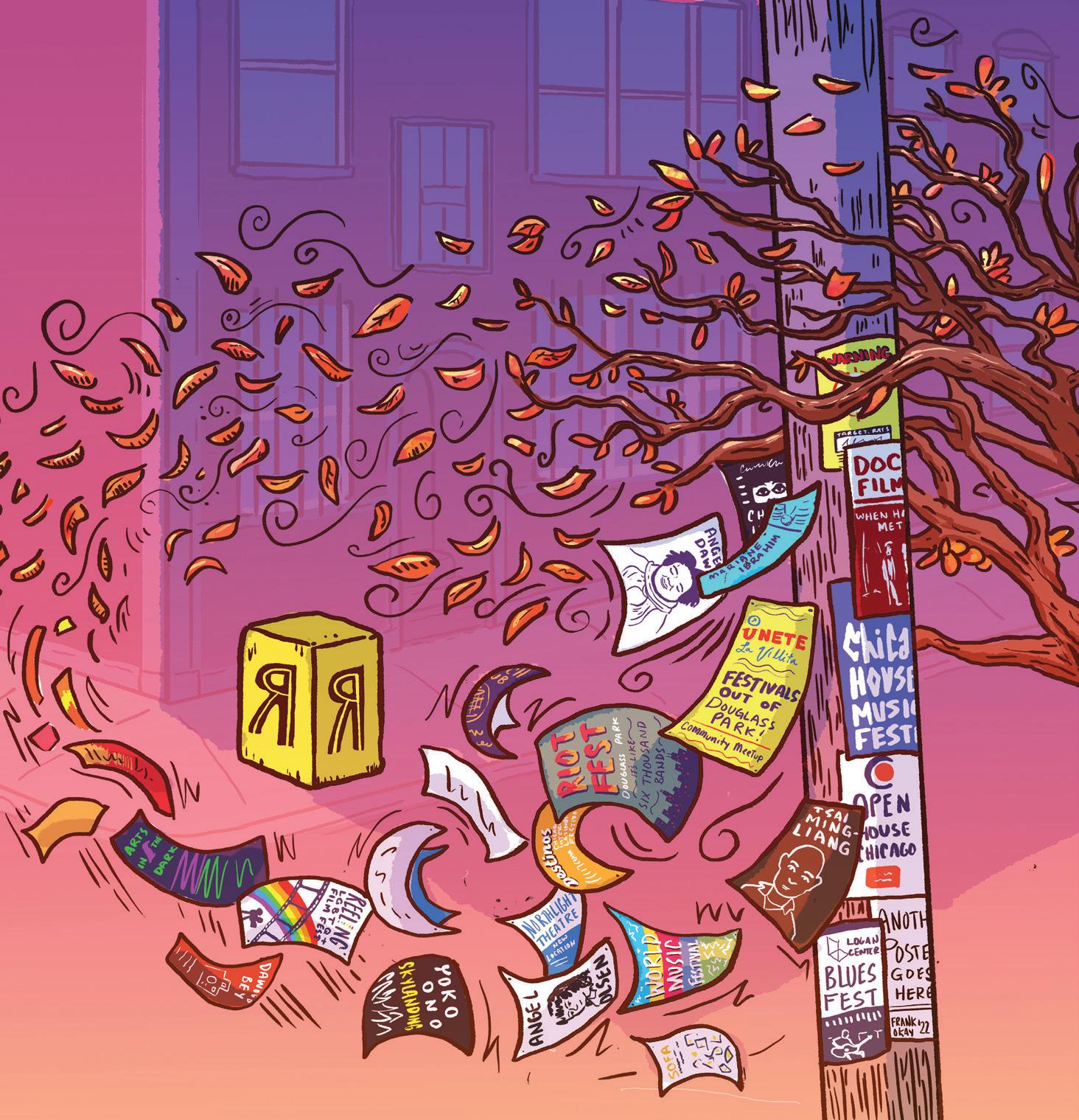

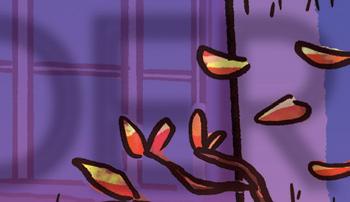






FREE AND FREAKY SINCE 1971 | SEPTEMBER 15, 2022
Theater & Arts
Gallerist Mariane Ibrahim 18 Is iO Theater coming back? 36 Filmmaker Tsai Ming-Liang 52
Fall
Preview
CITY LIFE
04 Street View Mucca Pazza delivered their mesmerizing cheer to the Chicago Botanic Garden.
16 Resources A list of employment programs and legal aid support to help those making a transition from incarceration to community
FALL THEATER & ARTS
18 New Home Artist Carmen Neely and gallerist Mariane Ibrahim found community in Chicago.
20 Graphic Novels Michael DeForge’s Birds of Maine paints a human-free utopia.

24 Living on Luck A former Chicago busker’s new novel based on his time on the streets
26 Collo-Julin | Listings Fall exhibitions and events for Chicago’s corner of the art world
28 Breaking Ground Northlight Theatre’s Evanston homecoming
30 Local Legend Larry Yando balances the comic and tragic in Hercule Poirot.
FOOD & DRINK

06 Sula | Preview Four Chicago books on pies, Palestinian cuisine, veggies, and bread
COMMENTARY
08 Joravsky | Politics MAGA’s Illinois Supreme Court nominees are poised to outlaw abortion in Illinois—if, gulp, they win.
10 Isaacs | Culture What did Americans know about Nazi Germany? When did they know it?
NEWS & POLITICS
12 City Bureau Cash assistance offers stability to formerly incarcerated people.
34 Performance Anxiety Nick Drnaso’s unsettling graphic novel Acting Class blurs the lines between acting and life.
36 Rebirth Comedy giant iO returns with help from old hands and fresh talent.
42 Witch Season Karla Galván calls on old friends for her newest show at Teatro Tariakuri.
44 Podcast Chris Gethard finds comfort in his own skin.
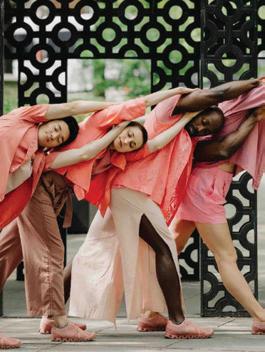

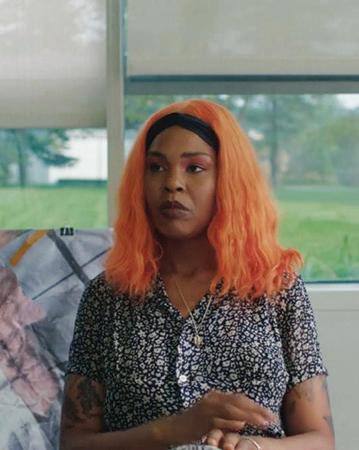
46 Dance Tools for new movement
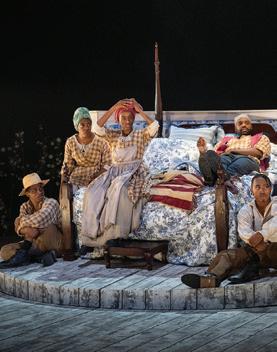
48 Reid | Review The Most Spectacularly Lamentable Trial of Miz Martha Washington presents a comic historical nightmare.
50 Plays of Note Court’s Arsenic
CHICAGO READER | SEPTEMBER 15, 2022 | VOLUME 51, NUMBER 25
TO CONTACT ANY READER EMPLOYEE, EMAIL: (FIRST INITIAL)(LAST NAME) @CHICAGOREADER.COM
and Old Lace is fun, Dreamgirls delivers at the Paramount, and Manual Cinema and Chicago Children’s Theatre bring Leonardo! to stage and screen.
52 Film Feature Tsai Ming-liang (finally) comes to Chicago.
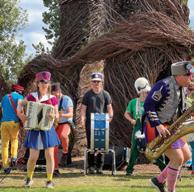
54 Analog The Chicago Film Society’s Celluloid Now showcase invites film buffs and newbies alike to discover the beauty of film.
56 Watch Screenings, events, and festivals abound in the coming months.
58 Movies of Note Viola Davis ascends to the next level in The Woman King, an A-list cast was hoodwinked into See How They Run, and Barbarian occasionally achieves ghastly heights.
founder of Mictlan Productions
70 Shows and Records of Note Previews of concerts including Stranded Civilians, Ten City, and the Hyde Park Jazz Festival, plus reviews of releases by Tink, Man Parrish, and Nicole Mitchell & Fabio Paolizzo
PUBLISHER AND PRESIDENT TRACY BAIM
MANAGING EDITOR SALEM COLLO-JULIN
PRODUCTION MANAGER KIRK WILLIAMSON
SENIOR GRAPHIC DESIGNER AMBER HUFF
STORY EDITOR SUJAY KUMAR
NEWS EDITOR JIM DALEY
THEATER AND DANCE EDITOR KERRY REID
MUSIC EDITOR PHILIP MONTORO
CULTURE EDITOR: FILM, MEDIA, FOOD & DRINK TARYN ALLEN
ASSOCIATE EDITOR AND BRANDED
CONTENT SPECIALIST JAMIE LUDWIG
SENIOR WRITERS LEOR GALIL, DEANNA ISAACS, BEN JORAVSKY, MIKE SULA
STAFF WRITERS DEBBIE-MARIE BROWN, KELLY GARCIA, KATIE PROUT
AUDIENCE ENGAGEMENT MANAGER YASMIN ZACARIA MIKHAIEL
LISTINGS COORDINATOR MICCO CAPORALE
74 Early Warnings New concerts and other updated listings
74 Gossip Wolf Annie Fish simulates her dream of 90s altrock stardom, multimedia studio Sonnenzimmer and composer Coupler collaborate on a catbased piece of sound art, and Monobody bassist Steve Marek debuts as Holy Western Parallels.
SAVAGE LOVE
VICE PRESIDENT OF OPERATIONS ANN SCHOLHAMER
DIRECTOR OF DIGITAL JOHN DUNLEVY
DIRECTOR OF MARKETING VIVIAN GONZALEZ MARKETING PROJECT STRATEGIST SHAWNEE DAY
DIRECTORS OF CIMA SAVANNAH HUGUELEY, YAZMIN DOMINGUEZ
EXECUTIVE ASSISTANT SANDRA L. KLEIN
ADVERTISING 312-392-2970, ADS@CHICAGOREADER.COM CLASSIFIEDS: CLASSIFIED-ADS@CHICAGOREADER.COM

MUSIC & NIGHTLIFE
60 Galil | Feature Vinyl owned by DJs in the 80s and 90s is still circulating in Chicago shops, and it offers a unique window into the ways house music came alive.
64 Brown | Feature Kehlani’s fans discuss the queer R&B artist’s music and impact.
68 Chicagoans of Note Amanda Flores, aka DJ Flores Negras and
75 Police State Dan Savage answers the age-old question: Do straight guys swap dick pics?
CLASSIFIEDS
ON THE COVER: ILLUSTRATION BY FRANK OKAY. FOR MORE OF OKAY’S WORK, GO TO FRANKOKAY.COM.
VICE PRESIDENT OF SALES AND BUSINESS DEVELOPMENT AMBER NETTLES
VICE PRESIDENT OF SALES AMY MATHENY SALES TEAM VANESSA FLEMING, TIM OGDEN, TED PIEKARZ, WILL ROGERS
DIGITAL SALES ASSOCIATE AYANA ROLLING
NATIONAL ADVERTISING VOICE MEDIA GROUP 1-888-278-9866 VMGADVERTISING.COM JOE LARKIN AND SUE BELAIR
DISTRIBUTION CONCERNS distributionissues@chicagoreader.com 312-392-2970
READER INSTITUTE FOR COMMUNITY JOURNALISM, INC. CHAIRWOMAN EILEEN RHODES ACTING SECRETARY KIM L. HUNT DIRECTORS ALISON CUDDY, VANESSA FERNANDEZ, ROBERT REITER
READER (ISSN 1096-6919) IS PUBLISHED BIWEEKLY BY THE READER INSTITUTE FOR COMMUNITY JOURNALISM 2930 S. MICHIGAN, SUITE 102 CHICAGO, IL 60616 312-392-2934, CHICAGOREADER.COM
COPYRIGHT © 2022 CHICAGO READER PERIODICAL POSTAGE PAID AT CHICAGO, IL ALL RIGHTS RESERVED. CHICAGO READER, READER, AND REVERSED R: REGISTERED TRADEMARKS ®
2 CHICAGO READER - SEPTEMBER 15, 2022 ll
76 Jobs THIS WEEK
IN THIS ISSUE



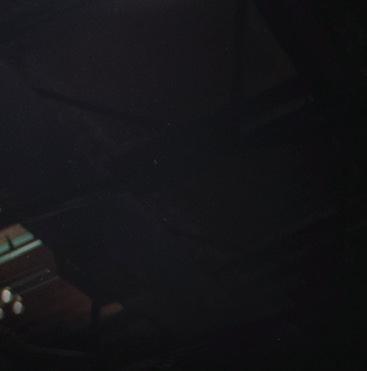



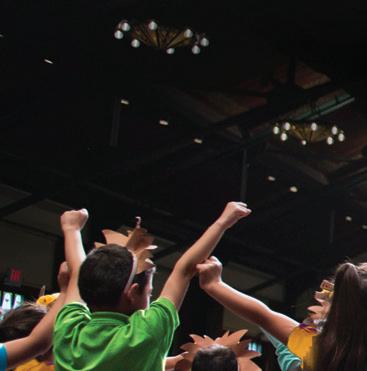
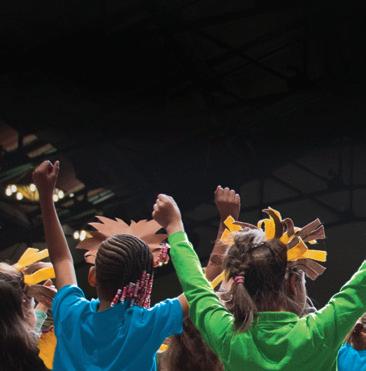
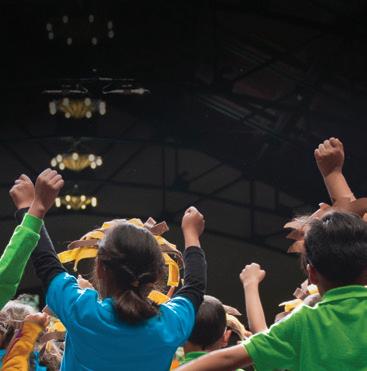
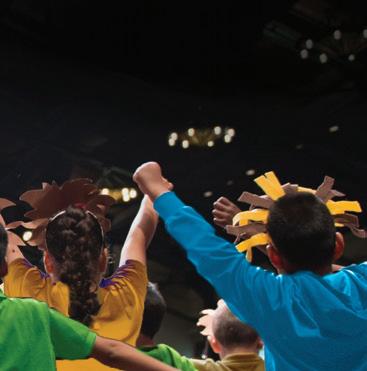

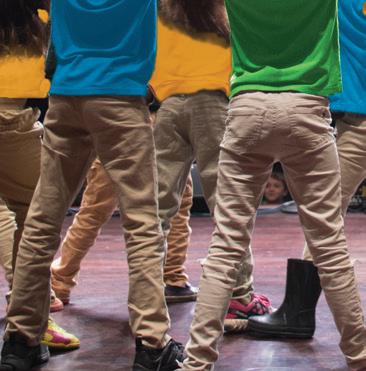
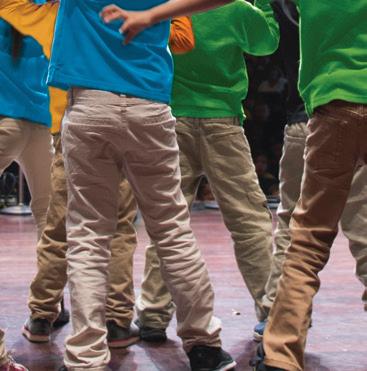

SEPTEMBER 15, 2022 - CHICAGO READER 3 YOUR SUPPORT IS INSTRUMENTAL Your donation supports classical music and sustains the Chicago Symphony Orchestra summer residency Scan to learn more! Ravinia.org/ReachTeachPlay
CITY LIFE
Marching for joy
Mucca Pazza delivered their mesmerizing cheer to the Chicago Botanic Garden.
 By ISA GIALLORENZO
By ISA GIALLORENZO
It was a hot, late summer Saturday, and my son and I had come to the Chicago Botanic Garden for an outdoor playdate with some friends. To our surprise and delight, the band Mucca Pazza was performing there that afternoon as part of a series of events called Flourish, a celebration of the garden’s 50th anniversary. We walked quite a bit to see them play, all the way to a new event space within the garden called the Rookery. The area features a series of interactive living castles sculpted out of willow saplings by artist Patrick Dougherty, placed across from a pond. The whole picturesque scene was the perfect background for
the explosion of sound, color, and joy radiating from Mucca Pazza, a punk marching band formed in 2004 and composed of “30-odd members” playing all kinds of brass, string, and percussion instruments, influenced by the likes of Bach, Charles Mingus, Rush, and Duke Ellington.
At this point a beloved Chicago institution, Mucca Pazza’s animated presence has graced local traditions, such as the yearly Lula Cafe Halloween Parade in Logan Square, and historical occasions, such as the opening of the 606 trail in the spring of 2015. Their energy is contagious, their music transporting, their moves engaging, and their looks fascinating. A jumble of color, fun patterns, and details from head to toe, their style could be defi ned as marching-band-meets-crayon-box-meetsmid-oughts-new-ravers.
“The mismatched, colorful look of Mucca Pazza has been part of the band’s look since the beginning and also feels like an analogy for who we are: colorful, joyful, mixed up, and still stylish and ready to party,” says guitar player and band member Charlie Malave, 39. “We want to spread joy. We believe that radical joy is a powerful force for good. We want
our audiences (and ourselves) to have a positively transformative experience. We also want to make good music. Music, clowning, and mismatched outfits might just seem silly, but we take silly very seriously, because when you do that you make a fertile ground for joy to grow,” Malave adds.
Some of the directives for Mucca Pazza’s “un-iforms,” as Malave calls them, are “that pants have stripes, but you can also wear a skirt. It should be a marching band uniform, nothing military. It should make you feel good. There should be a marching band hat.” With that in mind, each band member does their thing. “Our band is a great mix of humans with di erent style and taste. For some, Mucca is an opportunity to be more flashy than they normally would. But for others, it’s just an extension of the type of weird that they normally are,” says Malave.
Band cheerleaders Rawson Vint and Sharon Lanza particularly stood out with their bright outfits, silly humor, and free-spirited choreography. “As part of the cheer section, I try to base my look on every intramural sports uniform. I’m going for ‘confused-but-excited-for-tryouts,’” says Vint. Lanza was sport-
ing a red vintage T-shirt that read “I [heart] a scientist,” a matching red pleated miniskirt and rainbow knee socks. Trombone player Melissa McNeal also opted for a striking pair of (mismatched) knee socks. For her, joining the band was a dream come true: “From the instant I fi rst saw Mucca Pazza, way back at the Abbey Pub in the early oughts, I knew these were my people—and I began a yearslong scheme to join them in their weird. My success in pulling that o is one of the brightest joys of my life,” she says.
Charlie Malave seems excited for what the future holds for them: “We’re recording a new album; we’re coming up on 20 years of being a band in 2024. For that milestone we’re hoping to do a European tour and a big family reunion. And hopefully the band can live on for at least another 20 years beyond that!” Hopefully they’ll still be playing the Lula Cafe Halloween Parade, and hopefully Lula Cafe will still be serving freshly baked cookies at the end. Longevity does seem to be a feature of Chicago’s most cherished enterprises. v
4 CHICAGO READER - SEPTEMBER 15, 2022 ll
Street View
AT 50”
“FLOURISH: THE GARDEN
Through 9/25 : daily, 10 AM- 6 PM, Chicago Botanic Garden, 1000 Lake Cook Rd., Glencoe, chicagobotanic.org
Mucca Pazza perfoming in front of Patrick Dougherty’s sculptures made from willow saplings ISA GIALLORENZO
@chicagolooks













































































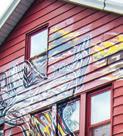








SEPTEMBER 15, 2022 - CHICAGO READER 5 sites 150+ 15 – 16 October neighborhoods 20+ discoveries ENDLESS A weekend of discovery awaits you during the Chicago Architecture Center’s free Open House Chicago festival. Keep the festivities going with programs and self-guided tours all month long. openhousechicago.org
BOOK PREVIEW
Food books are falling this month

Four Chicago books on pies, Palestinian cuisine, veggies, and bread
 By MIKE SULA
By MIKE SULA
Compared to last year, this autumn yields a relatively smaller harvest of books by Chicago chefs and food writers; there aren’t as many aspiring authors cooped up in quarantine, I suppose. But by any standards, four titles dropping over the next four weeks—by a quartet of heavy hitters—o er plenty of projects for the cold weather kitchen-bound.



Justice of the Pies, Maya-Camille Broussard
I don’t know if there’s ever been a sweeter cookbook published in Chicago history than social justice piepreneur Broussard’s debut. It’s as much a tribute to her late father—a self-proclaimed “pie master”—as it is to local food icons. Both serve as inspirations for the endlessly inventive chef, who creates pies (sweet, savory, and whoopie), tarts, and fetching miscellanea informed by everything from pizza pu s, to Italian beef, to Chicago hot dogs, to the lentil soup at the Nile, the churros at Xoco, and the carrot cake at Lawrence’s Fish and Shrimp. The pies are gorgeous and alluring, and include a collection inspired by activists Broussard admires and profiles at length. But stick to the headnotes alone and a bittersweet portrait of a loving but complicated father-daughter relationship emerges. (Clarkson Potter, October 18)

Dine in Palestine, Heifa Odeh
In 2019 the blogger behind Fufu’s Kitchen got a nod from Saveur magazine (“best food culture blog”), and now here’s the print expression of Odeh’s command of the breadth of traditional Palestinian cooking (“layered” fattet hummus; freekeh-stu ed chicken, olive oil-preserved labneh) and creative flexes (za’atar cake with olives and halloumi, chocolate almond baklava, fudgy pomegranate brownies with tahini). If, unlike Odeh, you don’t live in a paradise of Middle Eastern grocery stores such as Chicago, you might appreciate a glossary and online sources for some of the more uncommon ingredients. Not everyone can stroll down South Harlem Avenue and price sahlep powder for their homemade ice cream. But that’s what search engines are for. (Page Street, September 13)
6 CHICAGO READER - SEPTEMBER 15, 2022 ll
FOOD & DRINK
Images from Justice of the Pies PENGUIN RANDOM HOUSE
Images from Dine in Palestine PAGE STREET PUBLISHING
Find more one-of-a-kind Chicago food and drink content at chicagoreader.com/food
.
The Monteverde chef and Top Chef runner-up is best known for pasta supremacy, so this encyclopedic 432-page collection (from artichoke to tomato) is a glorious surprise—even if it comes at the end of the growing season. Grueneberg is trained in the Italian aesthetic of simplicity and superior product, but even with that the variety contained within is exhaustive and a mine of useful tips and techniques (ex: don’t oil your vegetables before grilling). You probably don’t think you need eight asparagus recipes, but flip through them and you’ll see that you do. Bonus points for the unwritten assumption (Chapter 11) that pasta is a vegetable. (Harvest, October 25)




If (like me) you have a visceral distaste for the Grateful Dead, you might not want to give this a chance. Much like an endless Jerry jam, the Publican Quality Bread head baker’s Dead references are . . . gratuitous. But press on. Arising from the sourdough pandemic, Wade’s approach to bread and pastry is, at its core, clear, precise, and beginner-friendly, even when he wades into the weeds. A staunch advocate for local and sustainably grown grains, Wade makes even the most challenging projects (maple rye kouign amann, anyone?) seem like achievable—if long-term—goals. If you’re even a casual restaurant goer, you’ve probably eaten Wade’s bread, and if you have no intention of mastering his signature multigrain sourdough, Bread Head serves as engrossing liner notes to what you might find on the shelves any given day at PQB’s marvelous new West Town retail bakery. (Norton, September 27) v


SEPTEMBER 15, 2022 - CHICAGO READER 7 FOOD & DRINK
Images from Listen to Your Vegetables HARPER COLLINS
Images from Bread Head W. W. NORTON
Listen to Your Vegetables, Sarah Grueneberg and Kate Heddings
Bread Head: Baking for the Road Less Traveled, Greg Wade and Rachel Holtzman
@MikeSula
The choice is yours, voters
MAGA’s Illinois Supreme Court nominees are poised to outlaw abortion in Illinois—if, gulp, they win.
By BEN JORAVSKY
Content warning: This column contains a reference to sexual violence.
As I write, it’s Labor Day—traditionally, the start of the election season.
That means “normal” people start to sorta pay attention to what’s going on in politics, as opposed to political junkies, like myself, who never stop paying attention.
As such, it’s my pleasure to tell you voters who are not paying attention that this upcoming November election is not your typical mundane midterm affair. At least, not in regard to abortion rights.

At the moment, abortion is legal in Illinois, thanks to laws passed in 2017 and 2019 by
Democratic legislators. After Governor Pritzker signed the 2019 bill, a gaggle of antiabortion zealots filed a suit to overturn it. In all likelihood, they would lose if their case were to suddenly reach the Illinois Supreme Court.
That’s because the Court currently is composed of four Democratic and three Republican justices. But that could change after November because there are two contested seats—one in the second district, which is in Lake County, and one in the third district, which is mostly in DuPage County. If the Republican candidates win in those districts, the Republicans will be in a position to make favorable rulings favoring the zealots that will gradually, ruling by ruling, outlaw abortion
in Illinois. No matter who the governor is or which party controls the legislature.
They could, if they want, use those rulings to turn Illinois into the second coming of Mississippi. Or Texas. Or Ohio. Or Indiana. Or all the other MAGA-controlled states where abortion is outlawed even in the case of incest or rape.
Both sides realize those two Illinois Supreme Court elections are key—it’s about the only thing both sides agree on.
That’s why abortion rights backers strongly support the Democratic candidates—Elizabeth Rochford in the second district and Mary Kay O’Brien in the third. And why MAGA backs the Republicans—Michael J. Burke in the second and Mark Curran in the third.
It’s a pivotal moment in this fight. For about the last 30 years, antiabortion Republicans have had the momentum. They’ve taken over legislatures throughout the country enabling them to pass antiabortion laws, like the one in Ohio that would force a ten-year-old rape victim to carry her rapist’s child to birth.
But the tides may have changed since the Dobbs decision in June in which the U.S. Supreme Court overturned Roe. The first indication came last month in Kansas. It’s a red state that voted for Trump, yet almost 60 percent of the voters approved an abortion rights referendum.
It was then that Republican strategists realized they might have to tone down the stridency of their antiabortion rhetoric and positions, at least in swing districts. And that brings me to Mark Curran, who, as I said, is running for Illinois Supreme Court against Elizabeth Rochford in the third district up in Lake County. Very much a swing district.
Curran recently told WBEZ reporter Dave McKinney, “I’ve never called myself antiabortion.” Wow. If Curran were Pinocchio, his nose would have grown a foot after that remark. Formerly the sheri for Lake County, Curran began his political career as a Democrat. In 2008, he switched parties after former Governor Rod Blagojevich got arrested for bribery.
“I’m walking away from the party of corruption,” Curren said at the time. “To suggest that Rod Blagojevich is an aberration and is not typical of machine politics in the city is an outright lie.” Coincidentally, Blago has undergone his own political transformation since President Trump commuted his sentence and freed him from prison.
Like Curran, Blago’s a MAGA man. I wouldn’t
be surprised if Blago winds up endorsing Curran—maybe even doing a little campaigning for him. Anything’s possible in the wacky world of MAGA these days.
In 2020, Curran was the unsuccessful Republican nominee in the race against Senator Richard Durbin. And he was not shy about letting everyone know how antiabortion he was. Consider Curran’s comments from July of 2020, just after Congressman John Lewis died. Lewis, of course, was one of the most courageous heroes of the civil rights struggle. He led marchers across the Edmund Pettus Bridge in Alabama, where they were met by Alabama state troopers, who bashed Lewis in the head.
Here’s what Curran had to say about Lewis, the man who literally put his life on the line for civil rights.
“He might have been instrumental in the fight for civil rights at one time, but John Lewis got in bed with Planned Parenthood and the abortion industry . . . Three out of five pregnancies in the African American community end in abortion. If you want to know why there is violence in the streets of Chicago, why it’s the most violent city in America, it’s because there’s no respect for the sanctity of human life.
“So when you have a quote-unquote ‘civil rights leader’ saying ‘it’s okay to kill all these little Black and Hispanic babies in the womb, no big deal, let’s make it as easy as possible making these centers in the inner city,’ well, you’re not much of a civil rights leader.”
That’s a standard Republican counterattack. Anytime they want to pivot from positions they know are disgraceful—like not honoring John Lewis—they bring up abortion.
As if to say, bashing John Lewis in the head may be bad, but abortion is worse. Darren Bailey, the Republican candidate for governor, sort of did the same thing—only in regards to Nazi genocide.
I suppose I can’t blame Curran for trying to conceal his real views on abortion. If voters knew he was so zealously antiabortion, they might not support him. Except perhaps for Blago, whose zeal for MAGA apparently knows no bounds.
The point, dear voters, is that when it comes to abortion rights, you have a clear choice. Unlike the women of Illinois, should Republicans seize control of the state supreme court. v
8 CHICAGO READER - SEPTEMBER 15, 2022
ON POLITICS
@bennyjshow COMMENTARY
’Tis the season: a sign from the Women’s March in D.C. last October. GAYATRI MALHOTRA/UNSPLASH
Out of the Woods
On the way to water, I think, low moan, heat too deep for me to reach. A new noise from a vent in the paper palace. Before, I bounce off brick wall, begging for a change; the door swings open and unhinges me to the nail. I heard ssssSMH behind me; you not ready. As it turns out, ticks, like cops, have a taste for black blood.
The mosquitos made a meal of me for weeks—their walking Slurpee. One stuck his straw in my third eye. I spell him struck blind. My friends compile lists of things they never knew, read me for filth. I say in every language, I don’t have the answers. They don’t believe me. I stop buying tickets to the shit show, but no matter the distance, the smell is pervasive. In the woods, I learned baby wolves get high from the scent of hearts bursting on their Instagram feeds. Serotonin is a helluva drug. In the clearing, I strain to hear the echoes of men whose bodies drag the forest floor. Unfortunately, all the witnesses withered seventy winters ago. Blood is a potent fertilizer.
By Krista Franklin
Open Sept. 22
Krista Franklin is a writer, performer, and visual artist, the author of Solo(s) (The University of Chicago Press, 2022), Too Much Midnight (Haymarket Books, 2020), Under the Knife (Candor Arts, 2018), Study of Love & Black Body (Willow Books, 2012), as well as several anthologies, literary journals, and artist books. Her exhibition, Solo(s) at DePaul Art Museum, opens September 8, 2022 and runs until February 19, 2023.
Poem curated by Jacob Saenz. Saenz is the author of Throwing the Crown, winner of the APR/Honickman First Book Prize. His poetry has appeared in American Poetry Review, Memorious, PANK, RHINO, Tammy and other journals. A CantoMundo fellow, he’s been the recipient of a Letras Latinas Residency, a Ruth Lilly Poetry Fellowship and a Latinx Scholarship from the Frost Place.
A biweekly series curated by the Chicago Reader and sponsored by the Poetry Foundation.







SEPTEMBER 15, 2022 - CHICAGO READER 9
Chim: From Destruction to Resurrection is excerpted from We Went Back: Photographs from Europe 1933-1956 by Chim, organized by the International Center of Photography and made possible by the John and Anna Maria Phillips Foundation and National Endowment for the Arts.
Free Programming from the Poetry Foundation! Learn more at PoetryFoundation.org Hours Wednesday, Friday, and Saturday: 11:00 AM–4:00 PM Thursday: 11:00 AM–8:00 PM Poemtime (In Person) Weekly storytime for little ones and their caregivers that introduces poetry through fun, interactive readings, songs, and art projects. Saturday, September 17/24, 10:00 AM
COMMENTARY
ON CULTURE
The U.S. and the Holocaust
By DEANNA ISAACS
Starting Sunday, for three consecutive nights, WTTW will air a new six-hour Ken Burns documentary series, The U.S. and the Holocaust Burns and his filmmaking partners, Lynn Novick and Sarah Botstein, based the series on a United States Holocaust Memorial Museum exhibit curated by Chicago-area native and current Newberry Library president, Daniel Greene.
From 2014 to 2019, Greene, an American history and immigration historian (and University of Chicago PhD), commuted to D.C. to work on the exhibit, titled “Americans and the Holocaust.” It opened on the museum’s 25th anniversary in 2018 and will run there through 2024. Last fall, Rutgers University Press published a companion book of the same title, coedited by Greene.
The exhibition, book, and film are the result of research that sought the answers to two
major questions: What did Americans know about Nazi Germany? When did they know it? And the followup questions: What did (or didn’t) America do about it, and why? Is it true, as is often (and comfortingly) claimed, that people in the U.S. didn’t know what was happening to Jews and others in Europe early enough to be able to do anything about it?
Not exactly. One of the core revelations is that Americans had access to information about Nazi Germany and even about the persecution and murder of Europe’s Jews as it was happening, Greene told me last week. “In the media landscape of the time, which was newspapers and magazines, radio and newsreels, there was more coverage of Nazi Germany than people had assumed.”
Here, in one of many examples in the book, is what the Chicago Daily Tribune published on March 8, 1923, about Adolph Hitler’s admiration for American industrialist Henry Ford,
then considered by some a possible presidential candidate:
“I wish that I could send some of my shock troops to Chicago and other big American cities to help in the elections,” the young leader of the Bavarian Fascisti party said grimly. “We look on Heinrich Ford as the leader of the growing Fascisti movement in America. We admire particularly his anti-Jewish policy which is the Bavarian Fascisti platform. We have just had his anti-Jewish articles translated and published. The book is being circulated to millions throughout Germany.”
Wait, Chicago? Henry Ford? Ten years before Hitler became chancellor?
That was part of the challenge of putting the exhibit together, Greene said. “We were trying to tell a story about Americans’ response to Nazism, but we had to continually remind
visitors about the context in America at the time. That it’s America going through a Great Depression. That it’s an isolationist America. That it’s an America dealing with its own racism and segregation and Jim Crow laws. That it’s a xenophobic America. Those conditions shaped our response to Nazism in large part. We needed to tell the specific stories we wanted to tell while also reminding people of that context.”
Among the stories they wanted to tell were those about ordinary Americans who did help. “While you see, in the exhibition, that the United States government and, for the most part, Americans, did not prioritize or do enough to aid the Jews and other targeted groups in Europe, there are some who did take extraordinary risks to do so,” Greene said.

“We tried to tell those stories so people don’t exit the encounter with this history feeling hopeless but can see that individual actions do make a di erence.”
They’re also hoping something can be learned from it. “One of the di cult questions is why didn’t the United States do more? And, especially, why didn’t they let more refugees from Nazi Germany and other Nazi-occupied areas into the country? As an immigration historian I’ve always been interested in this fundamental tension: we are a nation of immigrants, and we often close our doors to immigrants.”
“This tension between the humanitarian ideal and political realities on the ground is one of the most fascinating stories in American history,” Greene said. “We debate it, generation after generation. Who’s included? Who’s excluded? Who gets to decide? The geography and the groups might change, but those questions get asked over and over again.”
Greene and Northwestern University professor emeritus (and eminent Holocaust historian) Peter Hayes, both of whom were advisers on the documentary, will preview and discuss it at an in-person event on Monday September 19, 6 PM, at the Illinois Holocaust Museum and Education Center, 9603 Woods Drive, Skokie. It’s free, but reservations are required at ilholocaustmuseum.org. v
10 CHICAGO READER - SEPTEMBER 15, 2022
did we know? When did we know it?
What
@DeannaIsaacs
A German policeman checks the identifi cation of Jewish people in the Krakow ghetto. NATIONAL ARCHIVES IN KRAKOW


SEPTEMBER 15, 2022 - CHICAGO READER 11 You have a goal, and City Colleges of Chicago has the resources and support you need to achieve it. ccc.edu/apply HAROLD WASHINGTON • HARRY S TRUMAN • KENNEDY-KING • MALCOLM X • OLIVE-HARVEY • RICHARD J. DALEY • WILBUR WRIGHT Make your dream your career. Iliza Shlesinger Award-winning comedian shares her takes on the exasperating issues of everyday life. Get Tickets: chicagohumanities.org Thursday, October 13 | 7:00pm
BASIC INCOME
Cash assistance o ers stability to formerly incarcerated people
Many struggle to find employment because of the stigma of a criminal record. To help, one organization is offering cash.
By LESLIE HURTDAO, BRIAN YOUNG JR., AND CITY BUREAU

Pyon, the Chicago Future Fund program manager.
Under the program, 30 formerly incarcerated people are receiving $500 per month for 18 months without any restrictions or work requirements. The participants—mostly men, all between the ages 18 and 35—say they have spent the money on everything from rent to bills to Christmas presents for their kids to child support, according to Pyon and Nik Theodore, a professor of the Department of Urban Planning and Policy at the University of Illinois at Chicago and the director of the Center for Urban Economic Development, which is evaluating the program.
Theodore said the majority of participants in the program face multiple barriers of unemployment, economic insecurity, and hardships. Participants earn less than $12,000 per year and while a few have part-time, temporary, or full-time jobs, “a lot of folks are still pretty much in and out of the labor market and relying on informal work and hustling to try to make ends meet,” he said.
Theodore expects that the cash assistance will help stabilize participants. That stability, he said, would allow them to seek housing that better fits their needs and jobs that better fit their skills—as opposed to whatever they can get in a crisis.
“I think a big piece of this is strengthening the autonomy of individuals to start to make decisions, not based on just sheer economic necessity, but from a slightly more comfortable position where better decisions can be made,” Theodore said.
and Transformation’s Chicago Future Fund comes in.
The idea of giving unrestricted cash to formerly incarcerated people might give some people pause. Critics argue against such programs because they believe participants will use funds to engage in illicit activity, incentivizing them to remain unemployed.
However, Richard Wallace, founder and executive director of Equity and Transformation, said his organization follows a prison abolitionist model that focuses on the individual. The organization neither tracks the criminal charges of its participants nor sets stipulations on how the money is spent, he said. That’s because Wallace believes giving cash to Black Chicagoans impacted by mass incarceration and the War on Drugs is an essential step toward rebuilding people’s sense of community and individual dignity.
Wallace sees guaranteed income as a solution to the recidivism and economic inequality that many formerly incarcerated people face. Unconditional cash, he said, may not solve systemic racism or rectify centuries of anti-Black oppression, discrimination, and criminalization, but it can act as a lifeline that enables formerly incarcerated people to focus on their well-being, families, and careers without worrying about unexpected expenses.
For people who have been incarcerated, monthly cash assistance could be the support they need to rebuild their lives.
“When I got out, I had to go to a shelter,” said Corey Randall, 51, who has spent years incarcerated. “Nobody helped me do anything and I’m by myself so everything I got now, I had to work for it.”
He has struggled to find full-time employment with benefits. So, he’s focused on the jobs that he could get—temporary service jobs and minimum wage employment without benefits. He now works at a corner store in West Garfield Park, where he prices and restocks items.
Randall is not alone. Formerly incarcerated people often face discrimination when they apply for jobs, which contributes to people reoffending and going back to prison, also known as recidivism. The discrimination is more acute for Black people with a criminal record. To help change that pattern, organizations across the country are o ering cash— with no strings attached.
In Chicago, Equity and Transformation, a west-side nonprofit founded by and for formerly incarcerated people, launched the Chicago Future Fund last year with a simple idea—to alleviate the hardships of life after prison or jail by giving individuals cash for them to spend how they see best, said Rachel
The program is widely praised as Chicago’s first privately funded guaranteed income pilot program. To select participants, Equity and Transformation, which also goes by the acronym EAT, used a randomized process for people who met criteria.
Popular support for guaranteed income has grown since the federal government gave Americans stimulus checks to stay afloat during the pandemic. Chicago and Cook County each started their own cash-assistance pilot programs earlier this year, which are now the largest in the U.S. While neither program excludes people based on their criminal history, nor tracks their individual charge or conviction, they are not specifically for formerly incarcerated people, which is where Equity
According to a 2021 press release, the first round of the Chicago Future Fund was supported by several organizations, including BLM Global Network Foundation, The Movement for Black Lives, and Black Freedom Collective. That same year, the organization reported to the federal government it received $1.6 million in gifts, grants, and contributions in its fiscal year 2020, which ended in July of 2021.
“There are more than 100 pilots in the nation, and some of them are funded by private dollars,” said Harish Patel, director of Economic Security for Illinois and a manager of the Chicago Resilient Families Initiative Task Force, which studied the scope of the city’s guaranteed income pilot. The Chicago Future Fund “is prioritizing a certain group of people who need cash the most, and I’m hoping that there are a lot more privately funded organizations that prioritize certain groups of
12 CHICAGO READER - SEPTEMBER 15, 2022 ll
NEWS &
DAVID ALVARADO FOR CITY BUREAU
POLITICS
UNIVERSAL








































SEPTEMBER 15, 2022 - CHICAGO READER 13 SECOND-CHANCE PROMOTION Enter for a chance to win up to $50 MILLION in Las Vegas! See Ticket for Details The Price is Right®/© FremantleMedia Netherlands B.V. 2022 Licensed by Fremantle. All Rights Reserved. www.fremantle.com See O icial Rules, which govern, for complete details.
people who may get left behind by a massive city pilot.”
If successful, the Chicago Future Fund could provide advocates the argument they need to ensure people with criminal records have a financial safety net after being released.
Equity and Transformation plans to expand the program in the fall to service 100 additional people. The first round focused on participants from West Garfield Park. This round, the nonprofit will also focus on people who live in Austin and Englewood. The expansion is being funded by FTX, a Chicago-based cryptocurrency exchange, which promised to provide recipients with a zero-fee cryptocurrency bank account and financial literacy education—an innovation that Mayor Lightfoot lauded.
“Through this new FTX pilot, we will be able to ensure that residents from underrepresented backgrounds can access cash assistance, an innovative financial service, and financial education in one place,” Lightfoot said in a May press release announcing the expansion.
“I thank FTX for partnering with EAT on this important initiative, which will ultimately

make our post-pandemic recovery that much more equitable and inclusive.”



Randall, who works at the corner store in West Garfield Park, said such a program would have been life-changing when he’d been released from incarceration. He’s served nonconsecutive sentences on drug-related o enses. But he still could use the help. Randall, who plans to apply for the program when applications open in the fall, said he would use the money on “needs for my house.”
“I don’t have much, but I try to help a lot of people and try to save because it’s hard out here,” he said.
Since 1979, an estimated 3.3 million adults in Illinois have been arrested or convicted of a crime and may be living with the stigma and limitations of a criminal record, according to Never Fully Free, a Heartland Alliance report published in 2020. The report found more than 1,000 “permanent punishment laws” in Illinois that restrict the rights of people with records. The majority of those laws prevent or hinder access to employment by, for example, requiring background checks. Research shows applicants with criminal records are about
half as likely as those without records to hear back from employers.
“We’ve seen so many people in our program actually applying for many jobs but not seeing any results,” said Pyon. Stable employment can reduce recidivism. But because people with records have difficulty finding employment, they often end up in temporary, low-paying jobs. Pyon said unrestricted cash can help people who have been incarcerated attain some financial stability to turn around their lives and avoid reo ending.
Forty-three percent of people released from prison in Illinois recidivate within three years of their release, according to a 2018 report by the Illinois Sentencing Policy Advisory Council, a nonpartisan sentencing advisory group created by the state’s General Assembly in 2009. Recidivism is costly: Illinois taxpayers pay around $151,000 when someone reo ends and goes back to prison. In 2018, the council estimated recidivism would cost Illinois some $13 billion over five years.
Marlon Chamberlain, project manager of Fully Free, a Heartland Alliance campaign that pushes to eliminate permanent punishments

in Illinois, said guaranteed income programs also alleviate the psychological burden of having to go from being incarcerated to being self-su cient and supporting a family.
“When most people come home from prison, they don’t have anything. They’re pretty much starting over,” he said, adding that individuals often need basic essential items such as hygiene products, bus fare, and clothing.
Chamberlain said that knowing that there is a financial cushion gives people returning home from prison a sense of stability, more room to explore their passions and pursue work that they value.
“I think it gives you the opportunity to breathe and think about what you want to do [after incarceration] without the worry of ‘I need to take care of myself now,’” Chamberlain said. v
Leslie Hurtado and Brian Young Jr. are 2022 City Bureau Summer Civic Reporting Fellows. Sarah Conway, City Bureau’s senior reporter covering jobs and the economy of survival in Chicago, contributed to this report. You can reach her with tips at sarah@citybureau.org.
14 CHICAGO READER - SEPTEMBER 15, 2022 ll NEWS & POLITICS
Freefor Everyone Yourfuture,yourchoice APPLYNOW! Developyourcareerwithour Manufacturingprogram! WOMENIN Formoreinformationvisit:www.jane-addams.org Weofferfinancialassistancewith coveringthecostofdaycare,rent,utilities andtransportation.Nottomention employmentandfinancialcoaching! MANUFACTURING Startyourcareer! FREEtrainingcoursesin Welding,CNCandmore! @JARC_Chicago continued from 12
TTheCityofChicagoTreasurer’sOfficeandBMOHarrisBankareproudtopresentthe BuildingWealthTodayforTomorrowFinancialEmpowermentWeekend.Thistwo-day eventisopentoallChicagolandresidents,entrepreneurs,andsmallbusinessownersand isfreetoattend.JoinusattheUICForumonFriday,September30fortheFinancial ServiceCareerFairandonSaturday,October1fortheFinancialEmpowermentSummit toimproveyourfinancialknowledge,kickstartthenextstepinyoureducationorcareer, andtakethereinsofyourfuture.
FinancialServicesCareerFair
Friday,September30,2022·10AM-3PM

UICForum|1213SHalstedSt.
RSVPHere:chicagocitytreasurer.com/financial-services-career-fair
Ifyou’vebeenlookingtolaunchorretoolyourcareerthisfall,theFinancialServices CareerFairisanexcellentplacetogetstarted.Morethan50representativesfrom financialservicecompanies(includingsomefromFortune500firms)andrecruiting agencieswillbeonsitetoanswerquestionsaboutthefinancialservicesindustry.They willalsooffereducationalandcareeradviceforavarietyofindustriesincludingbanking, assetmanagement,investments,financialtechnology,andmuchmore.Afteraprolonged periodofpandemicisolationand,formany,remotework,thiseventistheperfectexcuse toturnoffthecomputerandconnectwithpotentialemployersandpeersinperson, practiceinterviewskills,revampyourresume,andmakeatruefirstimpression.

Nomatteryourprioreducationorexperience,you’reinvitedtoattendandtakeyourcareertothe nextlevelinthisexcitingindustry.Andwithsomecompaniesconductinginterviewsthroughoutthe day,youcouldpotentiallywalkawaywiththenextchapterofyourcareeronthehorizon.
FinancialEmpowermentSummit
Saturday,October1,2022·10AM-3PM
UICForum|1213SHalstedSt.
RSVPHere:chicagocitytreasurer.com/financial-empowerment-wealth-summit
TheFinancialEmpowermentSummitisafree,in-personeventopentoallChicagoresidents,small businessowners,andentrepreneurswhoarelookingtoempowerthemselves,learnaboutcurrent trendswithinthefinancialservicesindustry,andrevuptheirfinancialfuture.Throughouttheday you’llbeabletomeetwithfinancialserviceindustryprofessionals,attendfinancialplanning seminarsandworkshops,andlearnfromguestspeakersincludingDaymondJohnfromABC’s "SharkTank"andBillRancic,NBC’sfirst"Apprentice"winner.Youcanalsogetpersonalizedadvice onimprovingFICOscoresandreducingdebtfromtheHopeInsideinitiative,whichoffersfree creditandmoneymanagementresourcestoallChicagoans.Inaddition,youcanvisittheFinancial EmpowermentExhibitHall,whichfeaturesmorethan50financialorganizations,products,and services.Whetheryou’reinterestedinlearningthebasicsof financialplanningandinvesting, seekingtoreducedebtandmanageyourcreditscore,orpreparingtopurchaseahomeorexpand yourbusiness,yourroadtofinancialsuccessstartshere.
TolearnmoreabouttheBuilding WealthTodayforTomorrow Weekendorregistertoattend,visit www.chicagocitytreasurer.com/bwtt
ThissponsoredcontentispaidforbyCityofChicagoTreasurer’sOffice

SEPTEMBER 15, 2022 - CHICAGO READER 15
RevampyourcareerandplanyourfutureatBuildingWealth TodayforTomorrowFinancialEmpowermentWeekend PaidSponsoredContent
PAID FOR BY THE CHICAGO FEDERATION OF LABOR
PRISONS
Postincarceration resources
Where to find support
BY LESLIE HURTADO, CITY BUREAU
advocacy training. Formerly incarcerated women and gender-expansive people are welcome to attend biweekly meetings that alternate between in-person and virtual settings. For more information, email contact@womensjusticeinstitute.org or program director Colette Payne at colette@womensjustice. net. You can also fi ll out this request form at bit.ly/ReclaimRequest if you need support or referrals to other services.
Monetary Support
Cook County Promise Guaranteed Income Pilot, Cook County Government This guaranteed income program will provide monthly $500 stipends with no strings attached for two years to 3,250 Cook County residents. The program does not exclude people with criminal convictions and there is an optional survey that includes questions about past criminal convictions that will be anonymized for research purposes. To qualify, you must be at least 18 years old, a resident of Cook County, experiencing fi nancial hardship, and not participating in another guaranteed income program. Applications will open this fall. For more information, visit engagecookcounty.com/promise.
Training to Work Program, Safer Foundation This workforce development program (saferfoundation.org/training-to-work-program) is open to everyone, including people on electronic monitoring or those who have been incarcerated. The program offers job-readiness training and employment services. To join the program, call Cynthia Fulks at 312-9135436 to schedule an appointment, or the main o ce at 312-922-2200 for more information.
Community Re-Entry Center, Westside Health Authority This center specializes in helping individuals charged with or convicted of a felony. Services include job placement and job readiness training. Veterans, those with special needs, and people who are experiencing homelessness can register for this free program. To register in person, visit the center’s location Monday to Friday at either 9 AM or 11:30 AM. You must bring an ID and Social Security card. If you don’t have an ID, contact 773-786-0226.
from prison, people who are disabled, and those applying for Social Security disability benefits. They also represent people who have been denied housing because of their criminal records. For additional information about their services, go to uplcchicago.org/ what-we-do/prison or call 773-769-1411.
Reentry Services
Community Re-Entry Support Centers, Department of Family and Support Services These centers offer reentry services that include housing support, food assistance, and record expungement. To connect with a counselor, or to schedule an appointment at one of the centers, contact 773-664-0612 at the Westside Health Authority, or call 773-4886607 at Teamwork Englewood.
For formerly incarcerated residents, accessing resources is vital to surviving when reintegrating back into society. Most face challenges when applying for jobs due to the stigmatizing e ects of their criminal record. We’ve compiled a list that includes employment programs and legal aid resources to help those making a transition from incarceration to community.
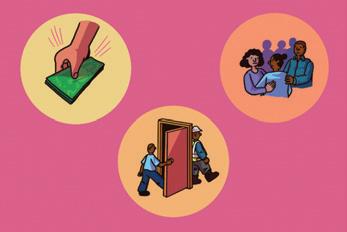
Community Healing
Communities & Relatives of Illinois Incarcerated Children, Restore Justice This program connects families who have loved ones who are incarcerated. Monthly meetings allow people to serve as a sounding board on different topics including current legislative changes, litigation, and personal stories. Email info@restorejusticeillinois. org for more information.
The Reclamation Project, The Women’s Justice Institute The Reclamation Project is a women-led initiative that supports women whose lives have been impacted by the criminal justice system. The center o ers a variety of programming including peer-led programs, community healing events, and
The Chicago Future Fund, Equity and Transformation (EAT) The Chicago Future Fund is a guaranteed income pilot program that provides $500 in monthly cash for 18 months to formerly incarcerated people. EAT plans to expand the program to 100 additional people this fall. Applications are expected to be released in the fall to formerly incarcerated residents of West Garfield Park, Austin, and Englewood. Information will be available on EAT’s website (eatchicago.org/ chicago-future-fund-1). Email Rachel Pyon at r.pyon@eatchicago.org if you have any questions or need help with the application. (See story, page 12.)
Emergency Fund, Love & Protect This fund (loveprotect.org) o ers $200 in fi nancial support to formerly incarcerated people of color who identify as women, trans men, and gender nonconforming people. The fund is only for people who have experienced domestic and interpersonal violence and who were prosecuted for self-defense. For immediate cash assistance, contact gailtsmith@ gmail.com or contact@loveprotect.com to receive the application form.
Employment and Training
Community Economic Development, Breakthrough Urban Ministries This program helps formerly incarcerated people in East Garfield Park access housing, employment, and help with launching a small business. Those 18 and older can join the program. If interested, contact Wilonda Cannon at 773-346-1745, or send her an email at wcannon@breakthrough.org.
RiseKit This business partnered with the city to create a resource hub (risekit.co/ dfss) for job seekers. It also collaborates with Teamwork Englewood to give formerly incarcerated residents access to jobs, training, and entrepreneurship opportunities. To look for job opportunities, sign up here for free.
Legal Aid
Crime Records Program, Cabrini Green Legal Aid This program helps people remove criminal records through expungement, petitions, and waivers. For those seeking employment, the legal center partners with job agencies and community-based organizations to help people find jobs. Other resources offered include virtual and in-person Know Your Rights presentations. To apply for expungement and criminal defense services, visit cgla. net/get-legal-help. Call 312-738-2452 if you need legal help, assistance with the application, or help finding a job.
Prisoners’ Rights Program, Uptown People’s Law Center The Uptown People’s Law Center represents people who are released
Green ReEntry, Inner-City Muslim Action Network (IMAN) High-risk youth and those returning from prison are o ered transitional housing, education, and construction opportunities through a 12-month program where they will learn electrical and carpentry. Returning adults and youth (ages 18 to 25) can apply for housing (18-month stay). For the housing application, click here. To apply for the Green ReEntry Program, visit bit.ly/ GreenReentry.
Re-Entry Services, Target Area This program offers an in-person community advisory council that provides community support and resources every Wednesday at 1 PM, as well as prison reform workshops. IDs are not required when requesting services. Call 773-651-6470 or email lcoakley@targetarea.org.
Reentry Support, Coalition to Decarcerate IL A variety of reentry resources are listed on the organization’s website, including workforce development, expungement, and housing assistance. For help with expungement and criminal record assistance, email CEICexpungement@gmail.com. Contact the Precious Blood Ministry of Reconciliation to learn more about their Workforce Development Program at 773-952-6643.
Illinois Reentry Services, Education Justice Project The group provides a list of more than 1,000 reentry resources in Illinois. Services include employment support, housing, health resources, and legal assistance. To view the complete list, visit their website at reentryillinois.net/resources. v
16 CHICAGO READER - SEPTEMBER 15, 2022 ll
&
BUREAU
NEWS
POLITICS DAVID ALVARADO FOR CITY
@LessHurtMedia
THEATER & ARTS THEATER & ARTS FALL PREVIEW







OPERA REVIEW

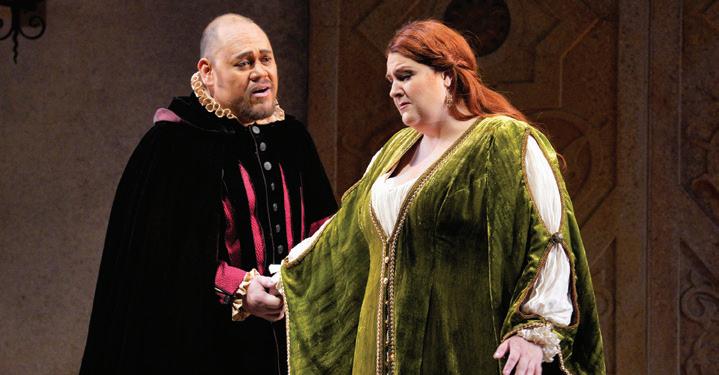
A note from an editor
Maybe it’s a given for a paper so rooted in Chicago culture, but the theater and arts preview special issues are a big deal for us here at the Reader.
Lately, we’ve been pu ing out almost one per season, which means that by the time we wrap up one, we’re nearly due to start planning for the next. It can feel exhausting to editors like me who cover the arts, but it can also be uniquely invigorating. These preview issues always remind me that things are happening in our city. Writers send extra pitches, eager to call dibs on covering upcoming events; advertisers are extra engaged, booking far in advance with the anticipation of a supersized print issue; and readers across the city pick up extra copies, knowing that each one is a comprehensive and reliable schedule for the season. The fall edition, in particular, helps provide some solace at a time when I, for one, am completely in denial about the impending turn of the weather. But a er creating this jam-packed issue, which teases film screenings, book releases, art exhibitions, and more, I’m in no hurry to hunker down indoors and wait for winter—Chicago is calling.
—Taryn Allen, Culture Editor

When melodrama meets breaking news

The rise of a new monarch makes Lyric’s Ernani topical.
By DEANNA ISAACS
Thanks to CNN, this weekend I went right from Lyric Opera’s season-opening production of Ernani —featuring Charles V of Spain—to the pomp and circumstance surrounding the launch of Charles III of England.
Castles, crowns, cannons—it was all of a piece.
And that did something I hadn’t anticipated: it brought an evening of seldom-seen Verdi to life.

1844 opera was their first collaboration. They might not even be responsible for the pop-up ghost. But the story is so ludicrous, they might as well have had their King Charles imagining life as a tampon.



Who would believe it?



As we’ve had occasion to note before, sometimes, when things are rarely seen, there’s a reason. In this case, following Lyric’s relatively new music director Enrique Mazzola (in his second season) down the rabbit hole of all things early Verdi takes us to an opera plot so blatantly melodramatic it had some in the audience snickering when they should have been shocked.

Through





Sun 9/25 2 PM, and Sat 10/17: 30 PM, Lyric Opera, 20 W. Wacker; lyricopera.org, 312 827 5600, $ 40 -$ 330
This is the dreaded territory of unintentional humor. Victor Hugo, who wrote the play that inspired Ernani, , couldn’t disassociate himself fast enough.
Laughable fealty to irrelevant codes of honor? Yes. Unbelievable reversals? Yes. A king so smitten he risks an empire just to get into the pants of his (seemingly pretty ordinary but o -limits) object of desire? Yes!
We should no doubt cut Verdi and his librettist, Francesco Maria Piave, some slack; this
There’s no chemistry in this stand-andsing production, directed by Louisa Muller. But there’s some fine singing of a difficult bel canto score, especially by tenor Russell Thomas as the title character, and two familiar alumni of Lyric’s Ryan Opera Center: baritone Quinn Kelsey as the king, and bass-baritone Christian Van Horn as a villainous uncle. All three aspire to bed, er, wed, the woman in question, Elvira, who’s powerfully, if not always sweetly, sung by soprano Tamara Wilson. The Lyric Opera chorus looks as good as it sounds in sumptuous costumes by production designer Scott Marr, and the excellent Lyric Opera orchestra is conducted by Mazzola.
Thank you Brits! Long live the King! (And if you’re leaving a bouquet in honor of your “late sovereign of happy memory,” as I heard it put this morning, please remove the wrapper. Flowers are beautiful; wrappers are trash. Critics can’t stop noticing.) v
SEPTEMBER 15, 2022 - CHICAGO READER 17
@DeannaIsaacs
Quinn Kelsey as Carlo and Tamara Wilson as Elvira in Lyric Opera’s Ernani CORY WEAVER
ERNANI
10/1: Fri 9/ 16 7 PM, Wed 9/21 2 PM,
KIRK WILLIAMSON
THEATER & ARTS THEATER & ARTS
A new home, a new energy
Artist Carmen Neely and gallerist Mariane Ibrahim found community in Chicago.
 By KAYLEN RALPH
By KAYLEN RALPH
When I first set out to profile gallerist and art dealer Mariane Ibrahim, she didn’t exactly decline, but she didn’t immediately say yes, either.
After being heavily profiled over the past couple of years—both for her curatorial style as well as her unconventional path to Chicago’s gallery scene via Seattle—the gallery’s focus was understandably on its artists and program in general, versus Ibrahim herself. Her roster of represented artists is indeed magnificence rising, and she’s been praised for “championing young artists of the African diaspora.”
In September 2019, after seven years in Seattle, Ibrahim moved her gallery to Chicago. Two years later, she inaugurated a second gallery in Paris (which is where Ibrahim lived before moving to the United States).
I visited her gallery in Paris in January of this year. In reconsidering my approach to this profile, I found inspiration in the work of artist Carmen Neely, whose paintings were included in the Paris gallery’s second show, a dual exhibit of Neely’s large-scale abstract paintings alongside artist Ferrari Sheppard’s figuration works.
I had seen Neely’s paintings online prior to making Ibrahim’s gallery a destination while in Paris, and I was immediately enamored with the writerly energy she brings

to her work. Neely’s practice of collecting memories and conversations—in sweeping brushstrokes of fuschia, purple, and cyan concealing underwritten layers of journal entry and personal archives—is the purest form of storytelling.
Neely’s own story mirrors Ibrahim’s in many ways, which is why fulfilling the technical subject of this profile’s wish to do so through her artists and their work first and foremost is actually really easy.





In 2020, Neely left a job in academia to pursue her practice of painting full time.
“I came to Chicago with that goal and intention, really not knowing anything else,” she said. “I immediately put feelers out and requested support from literally anyone I knew who had any connections to anybody [here].”
She ended up meeting Ibrahim through some mutual acquaintances not long after arriving in Chicago.


“I had known about her gallery and sort of been following what she was doing, but it wasn’t even necessarily that I moved to Chicago for that to happen. I just felt pulled towards [Chicago] . . . in some weird universal
way I was also pulled to the gallery. I think everything that’s happened has been part of that sort of invisible attraction, because it has all felt so—sort of—seamless, and the fit feels so natural, and it’s been easily supportive and not just from [Ibrahim] and the gallery, but from the community in Chicago. Now I’ve been here for two years.” What initially made me want to write about Ibrahim was an interview I read with her in ARTNews magazine, specifically this quote about Chicago and why she chose this city when considering where she’d relocate her gallery: “Chicago appealed to her for its particular kind of American-ness. ‘I felt like for the first time I was in America,’ she said of her first visit a few years ago. ‘New York is so international—it’s its own country, in a way—but in Chicago I felt like, this is the capital of America, with all its history and architecture and economy and politics.’”












Ours is a city that is getting increasingly widespread attention for its gallery scene, and West Town specifically is quickly emerging as Chicago’s emergent gallery district. Mariane Ibrahim Gallery’s location at Paulina and Hubbard is a stone’s
throw from the Monique Meloche Gallery and just a short walk to Chicago Avenue, i.e. “gallery row,” now home to the “Grand Dame’s” eponymous Rhona Hoffman Gallery, PATRON—all of which Ibrahim noted as galleries she admired in her ARTNews interview—ARC Gallery, and so many more.
Now having had a presence in Chicago for three years, and in the midst of increasing coverage of Chicago’s art scene, Ibrahim said she still feels like Chicago has been the best decision for her gallery and program.
“The city has not failed to continue to garner the gallery’s vision, while also continuing to be a key advocate for the importance of culture,” Ibrahim told me via email.
Neely moved to Chicago from Oklahoma, “a very conservative space.”
“I felt like I was the only dark-skinned person in [my work] department and surrounding departments on faculty,” she said.
“And during that time COVID really hit, and we started isolating, and then George Floyd was murdered, and I’m kind of feeling like I’m on an island . . . I came to Chicago not knowing a lot about it—just knowing that there was an arts community and that there were some really successful people who kind of built a practice there and then stayed for a long time, and I thought that must mean something.”
18 CHICAGO READER - SEPTEMBER 15, 2022 ll
All destined to become our mothers , a 2022 painting by artist Carmen Neely (right) L: COURTESY MARIANE IBRAHIM ; R: NOLIS ANDERSON
VISUAL ARTS
FALL
MARIANE IBRAHIM GALLERY 437 N. Paulina, 312-8775436, marianeibrahim. com. Closed until 9/ 17 when “Theater of Dreams,” a solo show by Ian Mwesiga opens (on view through 10/29)
In the same 2019 interview with ARTNews about her move to Chicago, Ibrahim also noted the sense of community within Chicago’s art scene as a factor in her decision. When I asked her how she perceives that community now, she said the same sense of congeniality continues.
CARMEN NEELY carmeneliz.com
of the community in Chicago that attracted both her and Ibrahim.
THEATER & ARTS THEATER & ARTS











originally inspired me, about Chicago as the capital of America.
“We continue to embrace each other, in ways you don’t see in other cities,” she said via email. “It is common for dealers to have dinner, to attend one another’s openings, to recommend clients and visitors to each other’s spaces. We emphasize our success is each other’s success, it is a fluidity that attracts people to Chicago, and what the city stands for.”
Neither Neely nor Sheppard were officially represented by Ibrahim at the time of their group show in Paris. Now they both are. And when Ibrahim’s official representation of Neely was announced in late March of this year, Neely once again spoke
“Mariane and I both took major leaps of faith investing in this city as transplants, and have found so much support and community here,” she said in an internal press release. “It’s truly energizing to be aligned in this way. I’m excited to continue expanding with the gallery in our growth outside of this space, but there’s something that feels really special about having an anchor together in Chicago.”
“Carmen is poetic,” Ibrahim said via email. “She has an ability to express emotive energy through strokes, color and composition in a way that is esoteric, and beautiful. We are thrilled to have her in our program, and as our first local Chicago artist.”
When I spoke with Neely for this piece, she had just returned to the States after a seven-week stint in Europe, including Paris. I shared with her Ibrahim’s quote that
“Especially since I’m just coming from this seven-week long stint in Paris and in Europe, which is a space in which she grew up in and was from . . . I understand maybe in this moment that particular contrast that’s resonating with her that maybe I wouldn’t have in the same way if I hadn’t just had this experience,” Neely said.

“I understand the contrast between Chicago and Paris and how they actually work interestingly together. The fact that she has galleries in these two cities that have these very different feelings . . . it feels very balanced in a way. And . . . Mariane has mentioned to me how she also feels like she hasn’t been in Chicago for very many years, but it’s a home to her, too.”
Throughout her time in Europe, Neely journaled. She sees writing as a natural extension of her painting practice, which is not only an exercise in documenting, but translating.
“When you’re in a space that is unfamiliar
or you’re confronted by people’s interpretation of you . . . that is something that [we’re] not necessarily used to living with every day, you suddenly have this heightened sense of awareness of new things about yourself and other people. That inevitably, I think, stimulates growth, but also makes you become even more aware of the ways that you live day-to-day in the familiar space that you occupy.”

For now, and hopefully for always, Neely and Ibrahim both occupy Chicago.
“Really just in two years I’m like, ‘I’m sure that this is the place that I should be and I want to be,’” Neely said. “And I am so excited and energized by the spirit of the arts community in Chicago.”









Neely’s first gallery solo exhibition will take place in Chicago at the Mariane Ibrahim Gallery during Spring/Summer 2023.
v
SEPTEMBER 15, 2022 - CHICAGO READER 19 -------
@kaylenralph
FALL
GRAPHIC NOVELS










The moon—it’s for the birds

Michael DeForge’s new graphic novel paints a human-free utopia.
 By MEGAN KIRBY
By MEGAN KIRBY



On the moon, there are no humans. The birds that populate the lunar planet don’t get caught up in ideas like weekends or “the economy.” They stay connected via a vast fungal network, and there is plenty of universal worm (there’s one big worm that they all eat) to keep everyone fed.

Michael DeForge’s latest graphic novel, Birds of Maine, chronicles this utopian avian society with his usual deadpan humor and surreal drawing style. DeForge’s book tour for Birds of Maine will hit Pilsen Community Books on October 14. The prolific comics artist and former Adventure Time illustrator began serializing these comics on social media in April 2020. In August 2022, publisher Drawn & Quarterly dropped the book.
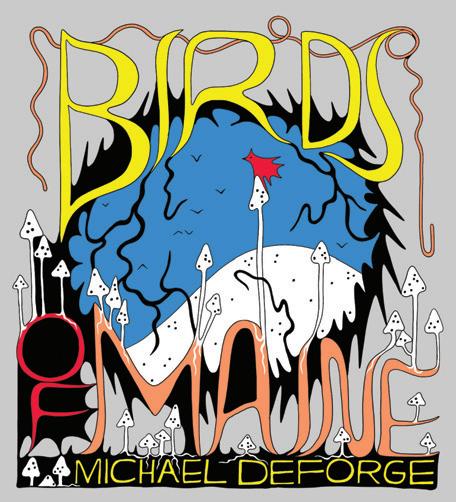

In Birds of Maine’s moon setting, the birds have abandoned Earth traditions as arcane and laughable. Instead, they have roosted into an easy socialist existence. The systemic conflicts of capitalism may be gone, but there is still room for plenty of plot. A kiwi bird and a penguin attempt a long-distance love. An angsty group of teen birds start a punk band. A young cardinal strikes up an email correspondence with a human stuck on Earth—throwing into obvious light how much bird society reflects and refracts our modern dilemmas.



We talked to DeForge about utopias and dystopias, alternate technological histories, and what goes into building a fully realized fantasy world.
Megan Kirby: How did you start building the world of Birds of Maine?
Michael DeForge: I’d been thinking about ideas around technology for awhile. One of the things that happens when you read the history of computing or the Internet—and
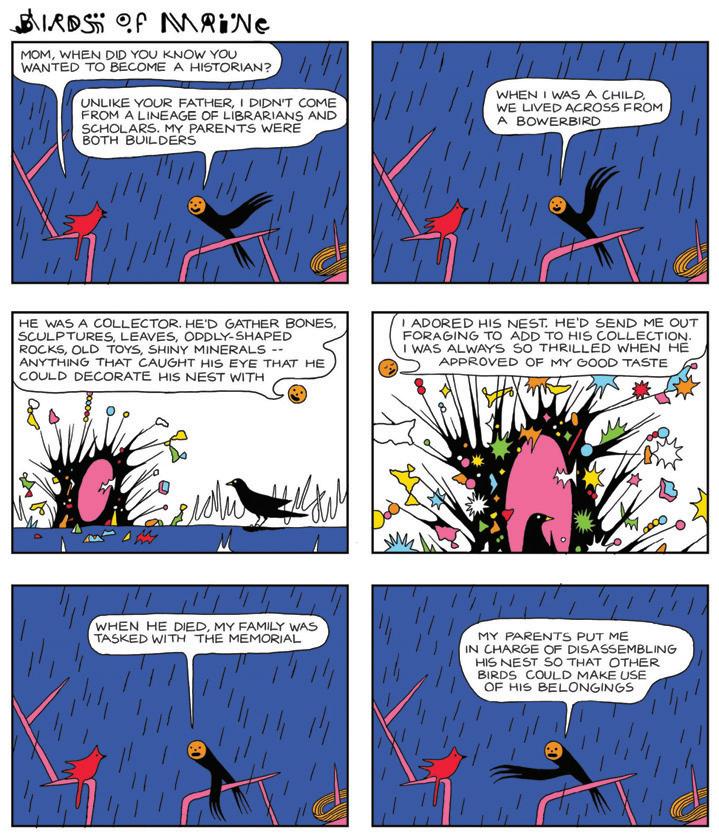
you see how both of those things have wound up fairly dystopian—is that you end up seeing this alternate history of technology where things didn’t have to develop according to the whims of capitalism or imperialism. The infrastructure of the Internet is built on those two things, but you can imagine this alternate history of something like the Internet that is built to be as egalitarian and liberatory as some of its biggest cheerleaders were saying at the dawn of the Internet. I wanted to write about technology that was built on a di erent infrastructure.
At the same time, I remember reading about the ways people have talked about mushroom computing, within fungal networks. I thought that was a really good starting point to build a whole world out of. A lot of the world-building was just me trying to figure out how they developed this technology. They’re not built for humans, they’re built for bird use—and mushroom use. I wanted the mushrooms and bugs to be as involved in the creation of the Internet as the bird. I also wanted it to seem alien and foreign to us. I spent a lot of time thinking about mushrooms, which was a pleasant way to pass the time.
Was there a moment you realized this was the project you wanted to pursue?
There was always this issue of Kamandi by Jack Kirby. It’s a future where there’s not very many humans, a Planet of the Apes-style future where animals all have their own kingdoms and technologies and stu . There’s one where he goes underwater, and he sees dolphin technology. Because they’re dolphins and they’re all underwater, there’s no up or down to them. It’s just a series of connected boxes with little buttons that are pulls, because the only way that dolphins would be able to interact with technology is
20 CHICAGO READER - SEPTEMBER 15, 2022 ll
Toronto artist Michael DeForge started posting the comics that would eventually inform the creation of his book Birds of Maine in 2020.
THEATER & ARTS THEATER & ARTS FALL
OF MAINE BY MICHAEL DEFORGE Drawn & Quarterly, hardcover, $ 34 95, 464 pp., drawnandquarterly.com
COURTESY DRAWN & QUARTERLY
BIRDS

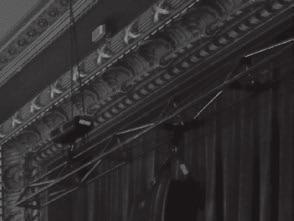











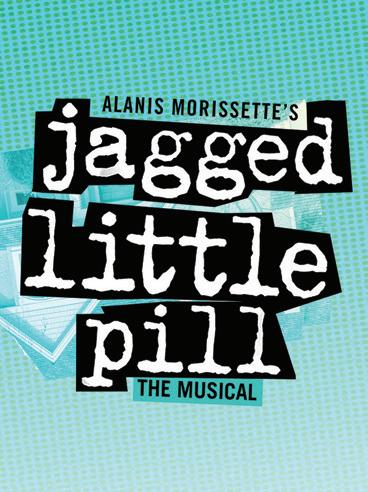













SEPTEMBER 15, 2022 - CHICAGO READER 21
THEATER & ARTS THEATER & ARTS FALL

continued from 20
with their noses. As a kid I thought that was really funny, and as an adult I kept thinking about that. I reread the issue as an adult, alongside an Ursula Le Guin story where in the future people are deciphering ant poetry that’s been written on germinated seeds. When I put those two things together, that was the spark to really delve into thinking about bird communication, bird technology, and what that might look like.


challenge to write about alternatives than to just write about how things suck.


I loved the way the book explores the Internet. Can you tell me a little bit about your relationship to the Internet as an artist?

Fri 10/ 14, 7 PM, Pilsen Community Books, 1102 W. 18th St., pilsencommunitybooks. com

The book really explores capitalism and imperialism through their absence. How did you form the tenets of bird society?
One of the rules I set out at the beginning was that I knew there was going to be conflict and friction within the book, but it needed to all remain interpersonal. I didn’t want there to be scarcity or some war. I wanted to depict a world where there was still conflict and problems and tragedy and grief and despair, but they’ve built a utopia that is sturdy enough to hold all of those things. I didn’t want it to be so rooted in humans and our present culture. I didn’t ever want the birds to explain exactly what type of communist they are.
You’ve explored dystopias and the idea of chasing paradise before. What draws you towards those themes?
I’m interested in the way people try to build up structures for themselves and then fail. There’s been so many utopian projects, especially in contemporary western history. And I think there is a tendency to write o their failures, or if they dissolve, to write o the whole experiment like a failure without maybe properly looking at the things that were successes. Some of the reasons that these attempts maybe collapse is that it’s very hard to build something new within an infrastructure that is already there, and sucks, and is working so hard to destroy you.
Because I do focus so much on our present calamity, I wonder how—not that art needs to be productive, but it can feel a little unproductive to always be fixated on disaster. Because we live in disaster. I don’t always think it’s that helpful for art to explain the disasters. Everyone knows everything sucks. No matter where someone is on the political spectrum, I think most people feel that deeply. I find it more a
It’s weird because I sometimes feel like I should be more grateful for the Internet. I grew up online, and I developed as an artist online. And career-wise, I’m quite reliant on something like Instagram or Twitter. But alongside all that, I’m of course extremely resentful that we are all beholden to these companies that do not really care about the artists using their platforms for their livelihoods. The whims of some company can change and then suddenly you’re out of work. It hits me less hard than if I was drawing more pornography or if I was involved in sex work. You can see these cases of all these people and their livelihoods just getting decimated by these choices.
Are you working on anything right now?
I just started serializing a new comic on Twitter that is about a touring pop group. It’s going to be weekly. I’ve been reading a lot of pop memoirs. Maybe it’s because I haven’t traveled in the pandemic yet, so the idea of touring is interesting to me.

If you were a bird, what kind of bird would you be?
I think I’d be a kiwi . . . That’s been my answer for favorite bird, but I also feel like that’s a very niche bird. Not for everyone, that’s my type of bird. v
@megankirb
22 CHICAGO READER - SEPTEMBER 15, 2022 ll
FOR TICKETS PLEASE CALL 773.975.8150 OR VISIT SGTHEATRE.ORG/STEW
MICHAEL DEFORGE AND SADIE DUPUIS IN CONVERSATION WITH JES SKOLNIK
MICHAEL
DEFORGE
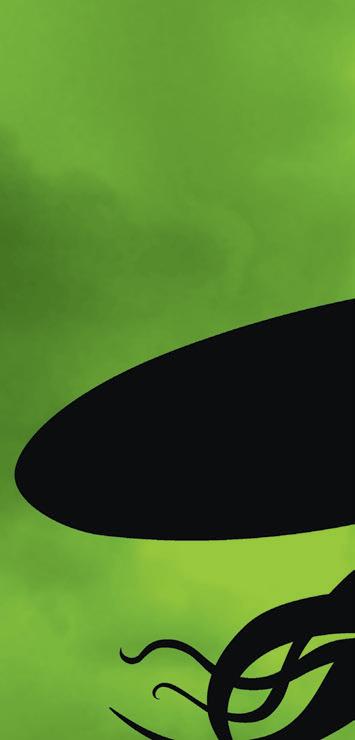






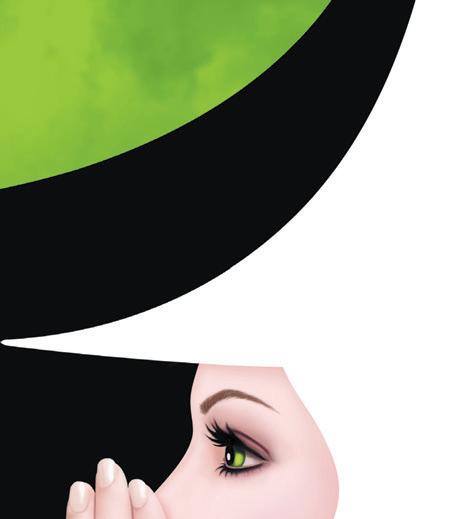







SEPTEMBER 15, 2022 - CHICAGO READER 23
THEATER & ARTS THEATER & ARTS













Living on luck

 By DMITRY SAMAROV
By DMITRY SAMAROV
Westley Heine never dreamed of singing for change on the streets of Chicago but life sometimes o ers only stark choices. Getting by as a musician, artist, or writer is uphill barefoot through snowdrifts on a good day. Add a recession, a relationship going sour, some substance abuse, and a generous helping of self-doubt and few would bet on a guy’s chances. Yet Heine perseveres. Grounded in street-level observation and faith in his muse, his story isn’t always pretty but rings that much more true for its rough edges.
Busking Blues opens in early 2010s Chicago as the Great Recession is in full swing. Heine leaves a longtime girlfriend after their volatile relationship becomes untenable and finds himself homeless and underemployed. Sporadic shifts at a supermarket situated on the dividing line between the mostly demolished Cabrini-Green housing projects and upscale Old Town aren’t enough to pay rent on his own place, so he decides to try his hand at playing music on the streets while squatting on friends’ couches.
When I call Heine in LA—where he’s moved with his wife for a change of scenery and to escape the harsh midwestern winters—we talk a lot about the line between fiction and memoir. Both Busking Blues and his 2021 chapbook, 12 Chicago Cabbies, tell stories that Heine experienced. The only changes or enhancements, according to Heine, are a few altered names; most other inaccuracies, he chalks up to the limits of memory. As a writer who’s never leaned much on imagination, Heine’s approach is familiar and welcome to me. There’s little the human mind could conjure to match the chaotic randomness of lived experience.
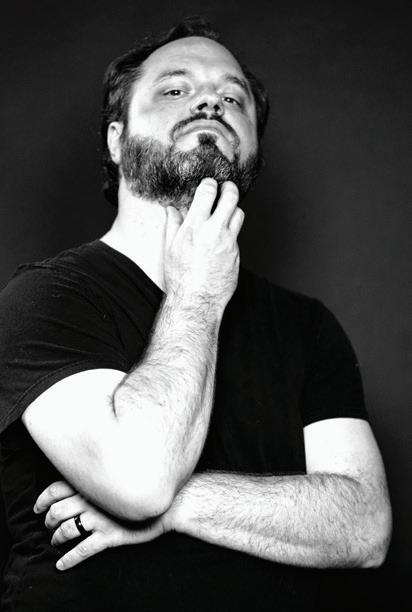
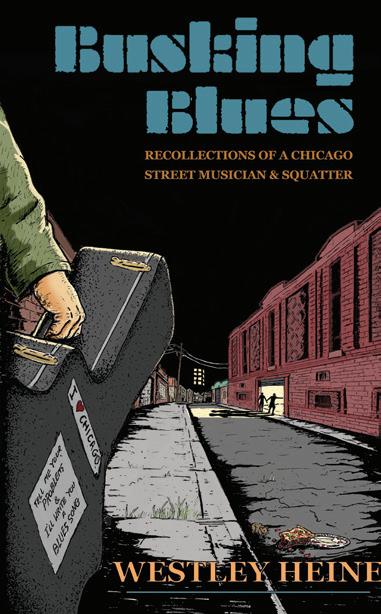
Heine is a heart-on-his-sleeve seeker. Taking lessons from veteran buskers, seasoned
grocery store coworkers, and former professors seriously, his path towards life lived for art is a treacherous one but always tinged with beauty and hope. No matter the obstacles or reversals, he keeps saying yes to any opportunity that comes his way. Sometimes that means a few days cat-sitting for a friend with access to a shower and a comfortable bed; other times it’s a nebulous relationship with an older woman that rides the line between chaste friendship one day and being stalked by her the next. It all adds up to a crazy quilt of urban experiences that a self-described country boy from Wisconsin could scarcely have imagined.





The thing Heine keeps coming back to in our talk is how much of the things that happened to him were the result of chance. “As a person who has a pretty scientific worldview I found it unsettling during the busking period because I found myself living on luck, the chance encounters on the grid. To start thinking in terms of fate, karma, superstition was troublesome to me.”
The starkest case of kismet comes toward the end of the book. I’d assumed it was poetic license, but Heine tells me otherwise. “I
intended to win that nice guitar and then I did. This freaked me out and I started going o the deep end with mind over matter/ free will concepts. Then, I lost the guitar in the taxi. This really happened as well. Easy come easy go before it was returned to me by the driver. Should I have taken this to mean that everything is random and meaningless?”
In between relating anecdotes, Heine grapples with how to tell his story. “If you just say bleakly what happened is it art or reporting the news? Is journalism or documentary an art or is it not? If the work is pure fantasy does it do anyone any good in the real world? Does art have to have a moral? Or is it better to have some moral ambiguity?”
While he may not have arrived at a definitive answer on how to present his experiences in his writing, I responded most to the parts of his book which present his life with little commentary or philosophizing. A problem for any writer plumbing everyday life for material is that there’s rarely a clear narrative arc. But a story needs a beginning, middle, and end so we must improvise or invent. Heine’s solution is a dream sequence that flashbacks much of the novel’s main points and adds a
heaping dollop of spiritual wondering. During our phone interview, he freely admits to making this part up. I wish he hadn’t. This tendency to make sense of or wrap up lived moments in a neat bow aren’t necessary when the anecdotes are strong and can resonate under their own power, without the addition of “morals” or “meanings.”
To my way of thinking, art works like a mirror pointed outward at the viewer. You take your life and that of those around you and tell it with whatever means at your disposal, be it a pen, a guitar, or a brush. You watch and listen to your environment and put it into words, notes, and images and your audience will see themselves rather than the artist. When Westley Heine writes about singing blues at a CTA stop, working the deli counter at Jewel, or riding the Green Line to the west side to sleep in his practice space, it’s a life and locales I recognize. There’s no need to explain or grasp for any larger lesson. But I also understand well the doubts that creep in at low moments, voices that whisper all your efforts are in vain. That’s a struggle that never goes away. Perhaps that’s the true subject of this vivid and engaging ramble through the Chicago of a decade ago. v
24 CHICAGO READER - SEPTEMBER 15, 2022 ll
FALL
BOOKS
A former Chicago busker’s new novel based on his time on the streets
“To start thinking in terms of fate, karma, superstition was troublesome to me,” Westley Heine refl ects on his unhoused time in Chicago. COURTESY THE ARTIST
@Chicago_Reader
RECOLLECTIONS OF A CHICAGO STREET MUSICIAN
Roadside
com
BUSKING BLUES:
& SQUATTER BY WESTLEY HEINE
Press, paperback, $15, 274 pp., magicaljeep.
























































































































SEPTEMBER 15, 2022 - CHICAGO READER 25 ©Disney GROUPS (10+) 312-977-1710 NOV 17, 2022 - JAN 14, 2023 ROARING INTO CHICAGO FOR NINE WEEKS ONLY!
THEATER & ARTS THEATER & ARTS
ART LISTINGS





A feast for the eyes
Fall exhibitions and events for Chicago’s corner of the art world
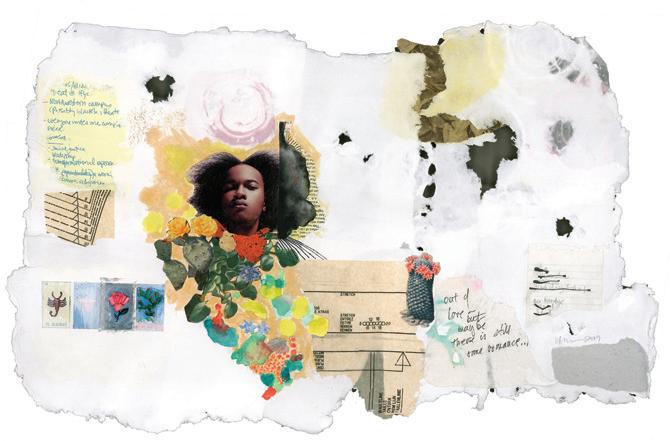
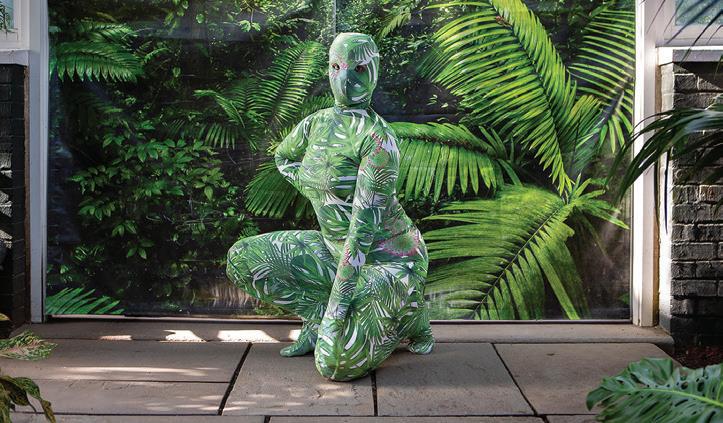

 By SALEM COLLO-JULIN
By SALEM COLLO-JULIN
COMING SOON
Hyde Park Art Center
Joseriberto Perez, “Bobo Deco” 5020 S. Cornell hydeparkart.org 10/15-2/11/2023
Western Exhibitions
Jessica Labatte, “Knee-deep in the cosmic overwhelm” 1709 W. Chicago westernexhibitions.com 9/16-10/29
Wrightwood 659
“The First Homosexuals: Global Depictions of a New Identity, 1869-1930” 659 W. Wrightwood wrightwood659.org 10/1-12/17




ON VIEW NOW

Adds Donna Martha Poggioli, “Impossible Garden” 3252 W. North addsdonna.com
Through 10/8: Sat noon-5 PM and by appointment (email addsdonna@gmail.com)



DePaul Art Museum
Krista Franklin, “Solo(s)” and “A Natural Turn: María Berrío, Joiri Minaya, Rosana Paulino, and Kelly Sinnapah Mary” 935 W. Fullerton resources.depaul.edu/art-museum/
Through 2/19/2023: Wed-Thu 11 AM-7 PM, FriSun 11 AM-5 PM
Gallery 400 at UIC


“For Each Other” featuring work from GnarWare Workshop, Kennedy Healy and Marley Molkentin, and more 400 S. Peoria gallery400.uic.edu

Through 12/17: Tue-Fri 10 AM-5 PM, Sat noon5 PM
Museum of Contemporary Photography

“Beyond the Frame,” work from the museum’s permanent collection Columbia College 600 S. Michigan mocp.org

Through 10/30: reservations requested (through Tock, see gallery website for details) but limited capacity walk-ins accepted during the following hours: Tue-Wed and Fri-Sat 10 AM-5 PM, Thu 10 AM-8 PM, Sun noon-5 PM
The Renaissance Society
“Fear of Property” featuring work by Karrabing Film Collective, Pedro Neves Marques, Christopher Williams, and more University of Chicago, Cobb Hall, 4th Floor 5811 S. Ellis renaissancesociety.org
Through 11/6: Wed-Thu noon-6 PM, Fri 1-7 PM, Sat-Sun noon-6 PM
Roman Susan Chloe Munkenbeck, “Interior Motives” 1224 W. Loyola romansusan.org
Through 10/9: Fri and Sun 4-7 PM, and by appointment v @hollo
MORE LISTINGS: chicagoreader.com
26 CHICAGO READER - SEPTEMBER 15, 2022 ll
FALL
Top to bottom: Krista Franklin’s Out of Love But Maybe There’s Still Some Romance (2019) , Container #7 (2020) by Joiri Minaya, and Kennedy Healy and Marley Molkentin, from the 2021 series Care COURTESY THE ARTISTS
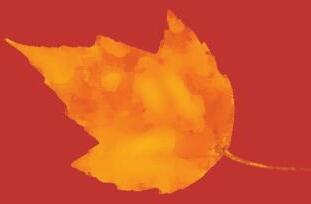
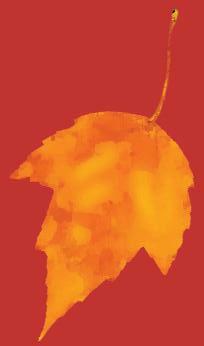


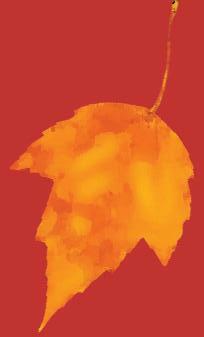

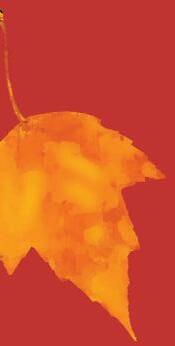
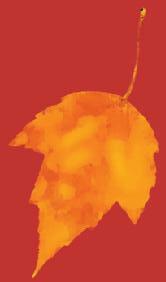



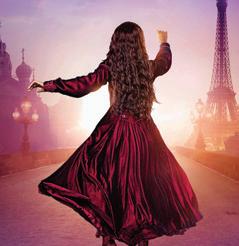





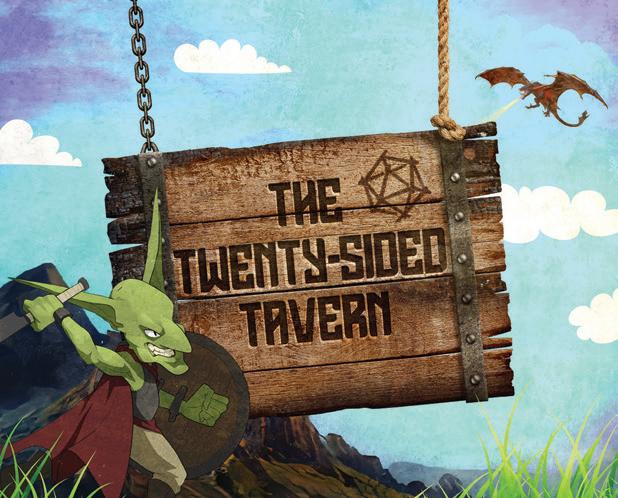






SEPTEMBER 15, 2022 DECEMBER 6 — 31, 2022 SEPTEMBER 20 — 25, 2022 Our audiences are recommended (not required) to wear masks throughout the theatre. For more information visit BroadwayInChicago.com/COVID19. DECEMBER 6 – 11, 2022 ON SALE NOW FOR CHICAGO READER READERS! Use code READER when ordering OCTOBER 27, 2022 – JANUARY 15, 2023 BROADWAYWORLD The Theatrical Adventure You Have Been Waiting for. The story’s in your hands & YOU decide our heroes’ fate!
THEATER & ARTS THEATER & ARTS









From the Loop, you’d need at least an hour and a transfer to get close enough to the North Shore Center to walk the final blocks, which include a heavily tra cked intersection that has proven extremely hazardous for pedestrians in the past.
“We’re looking at a time when the next generation doesn’t have, doesn’t want, cars. So moving right next to the el is a big, big deal in making theater more accessible to more people,” says Jones.
Lepri-Stringer says.
“I was humbled by the life stories these individuals were willing to share. And it wasn’t about crafting a perfect scene or plot. It was more about opening a room where they could write and thankfully present feedback to each other.”
On Church Street, Jones and Northlight executive director Timothy Evans envision a home where classroom space is available for seniors and students alike, where concerts and TED talks light up dark nights, and meeting rooms turn the place into a community hub.
Northlight’s Evanston homecoming
By CATEY SULLIVAN
It’s a fool’s exercise, listing the Chicago theaters that have come and gone over the past quarter century. I tried but gave up when I hit 24 at 17 years in. From Angel Island to Zebra Crossing, it’s a list that speaks to the ephemeral nature of both the art form and the waves of artists that come and go in a brutal business.
Then there’s Northlight Theatre, launched in 1974 by Northwestern grad student Gregory Kandel, whose final thesis—as Northlight’s artistic director B.J. Jones remembers it— essentially required him to create an Equity theater from scratch.
Actor Mike Nussbaum (please take a moment to google if you do not know this name) served as artistic director in the early days of the then-named Evanston Theatre, which found a home at Evanston’s Coronet movie theater.
But the Coronet was razed years ago, and for the past 25 years, Northlight Theatre (recollections vary as to when the name changed) has been a tenant in Skokie’s North Shore Center for the Performing Arts. Its next 25 years are hinged on its pending move back to downtown Evanston.

After five years in the works, plans seem to be falling together. This summer saw the demolition of a long-vacant Thai restaurant on the 87,500-square-foot parcel at 1012-16 Church Street where Jones plans to build the new Northlight, a three-story building slated
to start construction in October 2023.
But new construction is hardly the only building driving Northlight’s Evanston-based endeavors. The theater’s teaching artists and educators have spent years building connections with Evanston, tending the theater’s local roots even as its brick-and-mortar presence remained out of town.
“We don’t have a conservatory. We don’t teach acting to professionals. Our programming is about helping people use theater in everyday life,” says Christina Lepri-Stringer, Northlight’s director of education and community engagement.
By the theater’s count, outreach efforts engaged some 4,000 people in 2021, including hundreds of students from Evanston’s public schools through programs ranging from playmaking workshops in elementary school classrooms to creative writing classes for grandparents.
“If you’re not engaging with your community as a theater, you’re a tourist attraction. And those are great, but that’s not who we are,” says Jones, an Evanston resident of over 30 years who took on the artistic director’s position in 1998, just as the theater moved to Skokie. “Theater as civic engagement. It’s a concept that goes back to the Greeks.”




Meeting the ideals of ancient Greece will be easier when your theater is within a block of the el and the Metra stations, something Northlight has lacked since it moved to Skokie.
He’s also keen to run his own box office and autonomously schedule the season’s programming. Northlight is the Center’s o cial resident company, but its schedule must accommodate other North Shore Center tenants who use the same space the theater does.



But frustrations with scheduling and box office transit haven’t dimmed Northlight’s attempts to engage. The company is now in its fourth year working with the Evanston Scholars program, wherein Evanston Township High School juniors apply to join a multiyear program aimed at helping them navigate the process of applying to college, then college itself, and ultimately the transition to the working world.
Northlight’s teaching artists have been crucial toward helping students succeed in college and beyond, says program director Demisha Lee.
“Folks might wonder how a theater artist can help with the college process. They can help with everything—how to use your voice in an admission interview. How to meet new people, how to deal with roommates,” Lee says.
“I’ve seen students on the quieter side realize they could speak up, talk loudly, even talk to a stranger, and get through it. We’re about to launch these students into a whole new world, and the teaching artists make a space where they prepare for that in a way,” Lee adds.
It’s a two-way street, says Lepri-Stringer, who began her career with Evanston’s Mudlark Theater. Some of her work at Northlight involved the Grandmothers Raising Grandchildren group, which is o ered through the Levy Senior Center in Evanston.
“When I taught that class—no, taught isn’t the right word. When I facilitated that class I remember being intimidated walking in, wondering what I could possibly teach people who had so much more life experience than me,”
The theater will reportedly generate an eye-popping $56 million within five years of completion, according to a financial study done by Hunden Strategic Partners. That figure includes everything from a year’s worth of construction work to an uptick in nearby dining, Evans says. The city stands to benefit as well, to the tune of some $644,000 in increased local tax revenues, according to the Hunden study.
Northlight has raised roughly half of the $25 million capital campaign it needs to complete construction, but the theater’s opening isn’t projected until 2024. Before the pandemic, community resistance derailed initial plans for a theater inside a 37-story building on Sherman Avenue. Northlight returned in 2019 with plans for the Church Street address.

The building designed by Eckenho Saunders includes rehearsal rooms, community rooms, a 300-seat thrust theater, and no condos. (The Barn Steakhouse, an upscale eatery located on an alley that borders the property’s southern edge, remains in place.) Evanston’s city council signed off in April 2019. Everything was on track—until it wasn’t.
“When the pandemic hit, of course, we put all that on the back burner. The priority became surviving,” Evans says. Now, the focus is expanding back to include building. In April, Evanston awarded Northlight $2 million toward the move from its $43 million in federal pandemic relief money.
Lee has high hopes as well for the future of her young scholars.
“I see the di erence the teaching artists can make. You see the scholars at the beginning of the day and the end, and you can tell something’s been shaken loose. They’re more open. We get a lot of tickets for them too, and that’s wonderful. Having a building right here where they can access that theater—that’s going to make a di erence.” v
28 CHICAGO READER - SEPTEMBER 15, 2022 ll
Rendering of the exterior for Northlight Theatre’s upcoming new venue in Evanston
COURTESY ECKENHOFF SAUNDERS BREAKING
GROUND
A new location will offer more room for community engagement.
FALL
@SullivanCatey


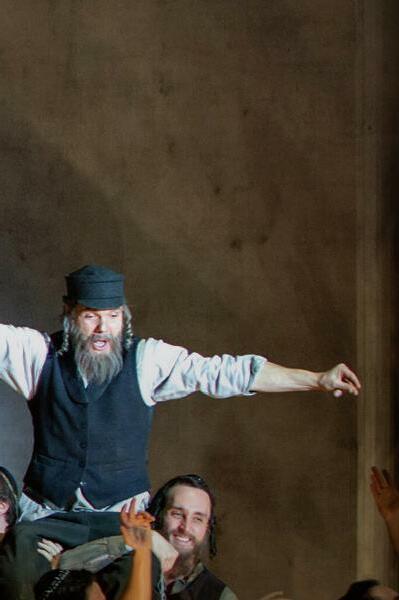
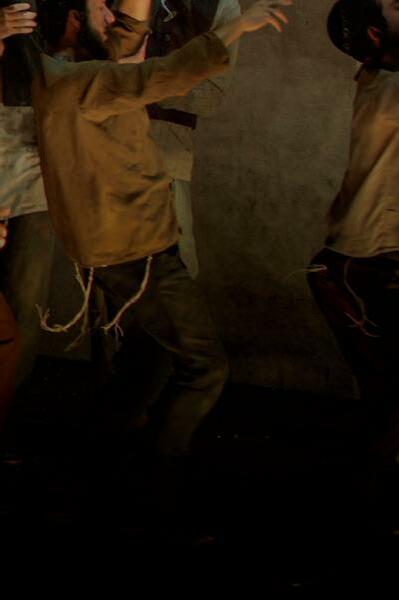



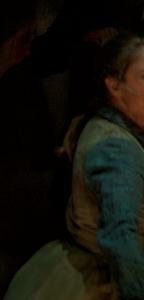


















SEPTEMBER 15, 2022 - CHICAGO READER 29 Ernani Sep 9 - Oct 1 Fiddler on the Roof Sep 17 - Oct 7 Don Carlos Nov 9-25 Le Comte Ory Nov 13-26 Hansel and Gretel Jan 25 - Feb 5 The Factotum Feb 3-12 Carmen Mar 11 - Apr 7 Proximity Mar 24 - Apr 8 West Side Story June 2-25 2022 | 23 Season Experience the joy of live performance Tickets on sale now starting at $39 lyricopera.org Lyric Opera of Chicago thanks its O cial Airline, American Airlines, and acknowledges support from the Illinois Arts Council Agency Season Sponsor
Photo: Iko Freese/Komische Oper Berlin
THEATER & ARTS THEATER & ARTS

MURDER ON THE ORIENT EXPRESS
Beyond the mustache
Larry Yando balances the comic and tragic in Hercule Poirot.
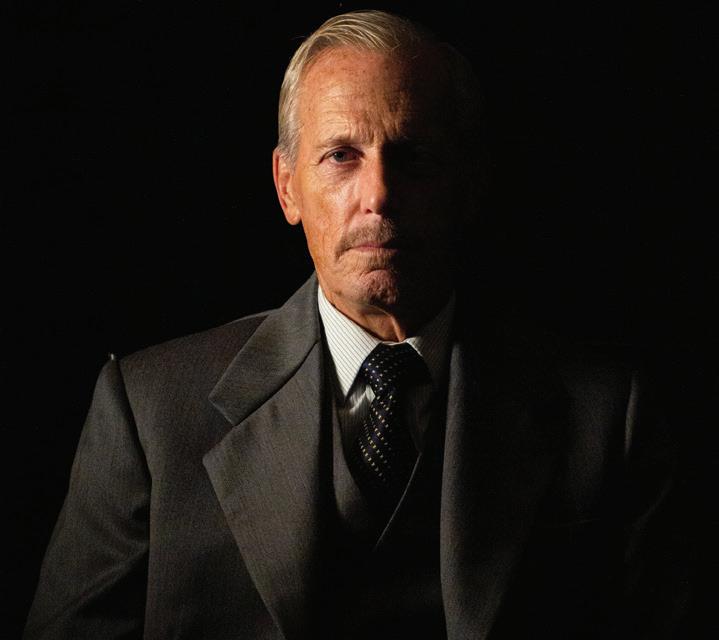 By EMILY MCCLANATHAN
By EMILY MCCLANATHAN

Larry Yando has been a prominent presence on stages in Chicago and beyond for many years, including as Ebenezer Scrooge in the Goodman’s annual production of A Christmas Carol (this year marks his 15th outing). He plays Hercule Poirot in Ken Ludwig’s adaptation of Agatha Christie’s Murder on the Orient Express at Drury Lane Theatre through October 23. This interview has been edited for brevity and clarity.
Emily McClanathan: You’ve played a variety of roles on stage that are already well-known from literature, film, or history—Scrooge at the Goodman Theatre, Scar in The Lion King national tour, and Nixon at Writers Theatre. What’s your approach when you’re playing a famous character on stage? How do you make the role your own?
Larry Yando: I don’t think I approach it any differently than I would any other role. The first thing I do is try to understand why this particular playwright wrote this particular play. I start with what the playwright’s take is on that character, whether he’s famous or a totally fictional character.
But when there’s source material to pull from, I like to know as many intricate, intimate details about a character that I can. I read as much of the source material as possible, but I always keep in mind that we’re not doing the source material, and we’re not doing another person’s idea of Scrooge, Nixon, Scar, or Poirot. We’re doing this particular playwright, so I think you have to always return to what serves this playwright’s vision.
Also, some actors are very good mimics. I’m not really a good mimic, so I don’t even
attempt it. What’s more important to me is the content of this human being, not the form. Sometimes the form is slightly important because the audiences need to believe that you’re playing Nixon or believe that you’re Scar in that movie they saw a long time ago. It’s a balancing act, for me, of just enough hints of something familiar or iconic about the character. And then, I treat it like any other role and assume that what will make this particular event unique is it being filtered through Larry Yando, as opposed to another actor.
What attracted you to the role of Hercule Poirot, and what has the process of developing this role been like?







Through 10/23 : Wed 1: 30 PM, Thu 1: 30 and 8 PM, Fri 8 PM, Sat 3 and 8 PM, Sun 2 and 6 PM, Drury Lane Theatre, 100 Drury Lane, Oakbrook Terrace, 630 530 0111, drurylanetheatre.com, $ 69-$ 84 ($ 5 discount for seniors Wed and Thu matinees) LOCAL LEGEND

I love British mysteries and British crime drama, so, for Poirot, I’d been aware of him for a very long time. In the books, he’s immaculately described. He’s a bit self-absorbed and very vain, so I already had all that information in my head.
Murder on the Orient Express was adapted by Ken Ludwig, a playwright who writes farces normally. Now, I believe that nothing is ever all funny or all tragic; there’s always both. I think that’s what human beings are, and I think that’s what every great character in a play is. What I love about Poirot is, in this particular story, he does not remain above this particular crime, and he is deeply a ected by it. This is a major, unusual, specific, extraordinary case for him that changes him irrevocably—and that, to me, is what happens in great plays to great characters, so I latched onto that. And then, it’s just like doing King Lear—he makes one mistake, one thing happens in the beginning, and he’s haunted forever.



My process is not trying to be funny, not trying to imitate previous Poirots, but digging deep within myself to find something large enough that would haunt you for the rest of your life, because that’s what I think this play is about for Poirot.
And yes, there’s a Belgian accent, which is basically French. What’s funny is that Poirot is constantly correcting people that he is not French, he’s Belgian. There are, of course,
some requirements when you play a famous character. They usually have to do with form, what people expect to see, and you have to decide which ones are important to you and help you find the human being behind this iconic character, and which ones you can drop.





I do not think you can drop the French accent; I do not think you can drop the mustache. He’s also an “odd little man,” as described by Agatha Christie and other characters all the time, in all the books. I can’t be a little man— I’m not little—but I certainly can be odd. I certainly can have a mustache, and I can have the French accent. So, it’s about picking the iconic traits that feed the character, feed the dramatic action, and feed the three-dimensionality, and not worrying about those characteristics that don’t matter. Just trust the audience will go with you because you’re being honest, and you’re exposing something that reflects them in some way, like any great play.
Murder on the Orient Express is one of the most popular Agatha Christie novels and has been adapted many times for film and TV. Why do you think this story has such enduring appeal?
In our American culture, film is a very powerful medium. I remember the 1974 film vividly; I loved it, and I’ve seen it about 40 times. Once a film adaptation happens, at least in America, I believe it reaches many more people, and then people will go read the book.
Also, in my opinion, it goes to what I said interests me about playing Poirot—it’s an unusual case for the lead detective. It a ects him in a di erent way, and it a ects him in a way that all of us can relate to—having to make a di cult decision in our lives and living with it forever, and never knowing if it was the right decision. I believe—with a film, with TV, with theater—when an audience is faced with something that goes very deep into their own history and their own lives, that stays with them.
Could you tell me more about Ken Ludwig’s stage adaptation? Why do you think this

30 CHICAGO READER - SEPTEMBER 15, 2022 ll
Larry Yando as Hercule Poirot MCKENZIE CARTER
FALL










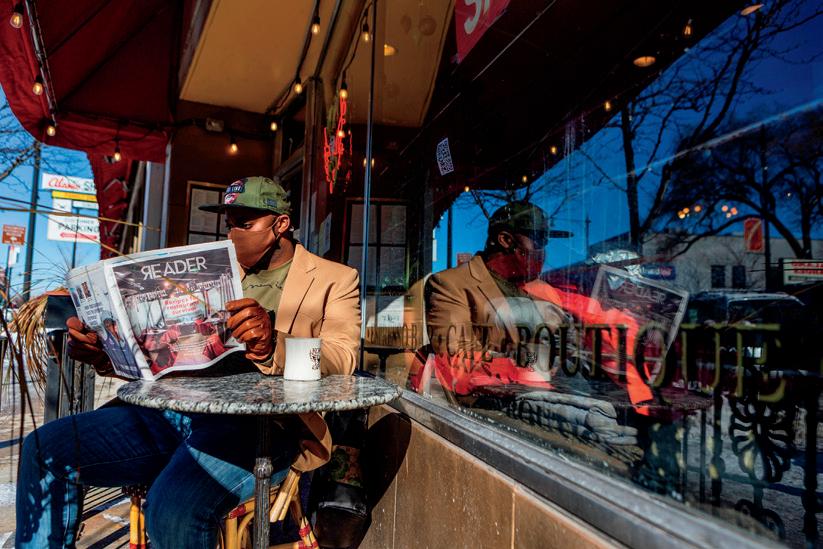

SEPTEMBER 15, 2022 - CHICAGO READER 31 Introducingournew membershipprogram Paywhatyoulike,startingat$5amonth— orbecomeanannualmemberandsave20%. Freeordiscountedentryto Reader sponsoredevents AnadvancePDFofeachnewissue Anexclusivemembershiplapelpin Extrasandsurprises Allmemberswillreceive: The Readerisembarkingonanewchapter,with anewnonprofitmodelthatputsreadersatthe heartofeverything. Helpkeepthe Reader freeforeveryone—in print,online,andeverywhere—bybecominga membertoday. Becomeamemberat chicagoreader.com/member Help Keep the Free Reader
THEATER & ARTS THEATER & ARTS FALL











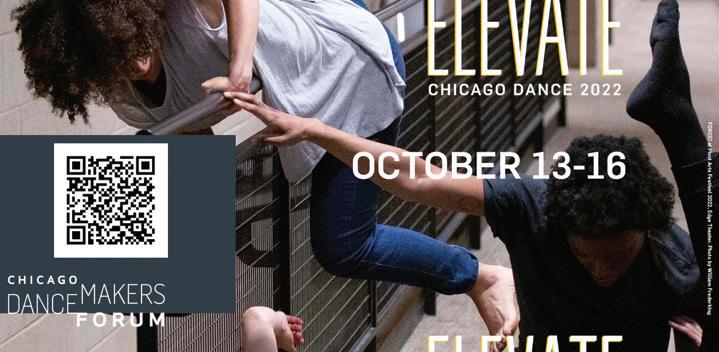

continued from 30

story works well on stage?
I know Ken Ludwig as writing Lend Me a Tenor—farcical stu . Agatha Christie’s Poirot series are not farces; you must take them seriously or you won’t find the comedy when you read the books. They’re very funny, but what’s brilliant about all the Poirot stories—or any good British mystery—are the hysterically odd, funny, recognizable characters, with a very dark vein of evil running underneath the entire story. She’s brilliant at making those two things exist side by side. And those two things, side by side, are what always excite me about any good play.
What I love about this adaptation is that it absolutely has all the comic possibilities because of these extravagant characters, and people get to laugh. Then, at the center is a very confl icted witness to something tragic and potentially evil and wrong. I think Ken Ludwig got both elements in the play, and
that’s why I think it works on stage because, to me, that’s what theater is, that tug-ofwar between two very opposing forces. The audience gets to be surprised at every turn, because you don’t know which one of those two extremes is going to rear its head at any given moment.
Finally, I have to ask about Poirot’s iconic mustache. On a scale from 1 to 10, how large of a mustache does your Poirot wear?
I would say my mustache for this production, on 1 to 10, would be a 7, maybe 8. It’s enough to call attention to itself, and it’s impeccably groomed—because it could be no other way with Hercule—and it doesn’t obliterate anything else on the stage. It’s believable and slightly extreme. I really love having it, because all of a sudden, you go, “Now I am complete.” v
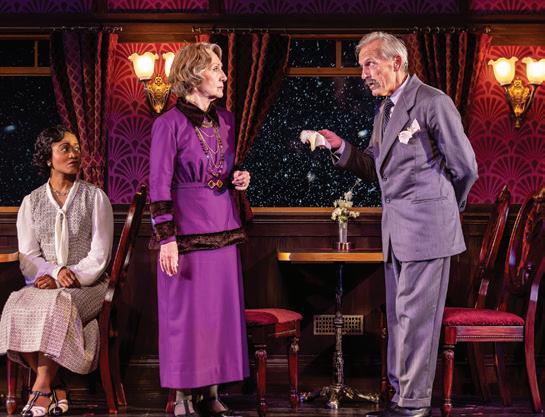
32 CHICAGO READER - SEPTEMBER 15, 2022 ll
@Emily_221B
Larry Yando in Murder on the Orient Express at Drury Lane BRETT
BEINER PHOTOGRAPHY

SEPTEMBER 15, 2022 - CHICAGO READER 33
THEATER & ARTS THEATER & ARTS



tally fragile granddaughter that her care may be doing more harm than good. A single mother pours all her own problems out to a son who’s too young to understand and may later be crippled by her lack of boundaries. “Just don’t turn on me the way I had to turn on my parents. This situation will be totally different,” she begs as she rocks him to sleep. She must know it isn’t di erent, that whatever flaws she inherited keep getting passed down generation to generation.
lives are not going so well that they couldn’t use a change. As one man remarks to a new trainee at his job, which involves mindlessly personalizing dolls and other souvenirs with names written in a variety of fonts, “I learned a long time ago not to hang too much selfesteem on a job.” What John o ers instead of the drudgery of their everyday lives is a kind of mindfuck that takes on cultic overtones. Each week’s class seems to take in a different location and doesn’t conform to any set format.
ACTING CLASS BY NICK DRNASO

Drawn & Quarterly, hardcover $29 95, 248 pp., drawnandquarterly.com. Drnaso appears Wed 10/26 7 PM with Ling Ma (Bliss Montage) at Women & Children First, 5233 N. Clark, womenandchildrenfirst.com.















BOOK REVIEW
Performance anxiety
Nick Drnaso’s unsettling graphic novel blurs the lines between acting and life.
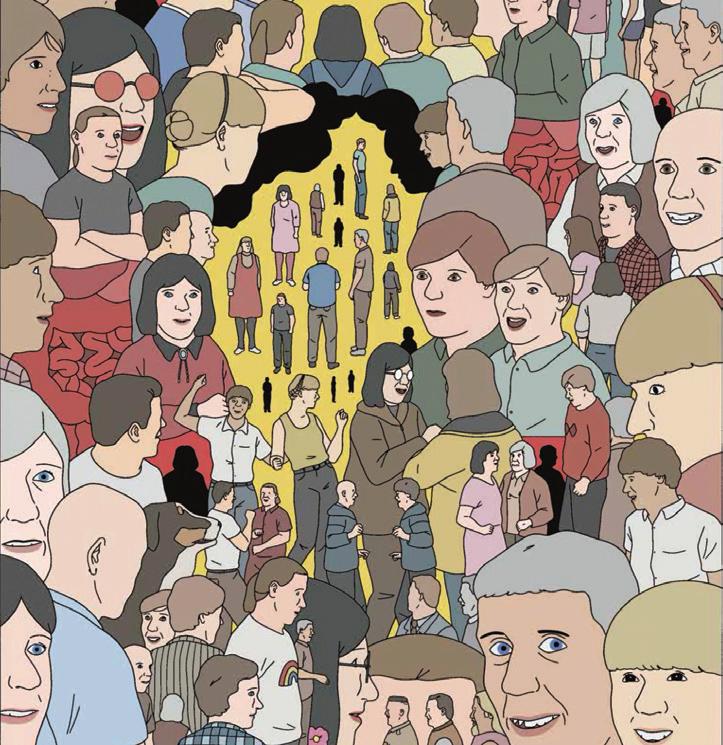 By DMITRY SAMAROV
By DMITRY SAMAROV
“The people who pick up flyers and show up to free classes tend to be restless searchers,” John tells his students, after remarking that there must be something wrong with them if they’re here. When one student takes o ense, John assures her he means this as a compliment. This scene takes place early on in Nick Drnaso’s unsettling new graphic novel, Acting Class . What starts out as a low-key portrait of a group of ordinary unsatisfied people trying something new winds up a sometimes sinister but always philosophical meditation on the quest for
deeper meaning.
Drnaso nimbly sketches in the lives of the acting class participants before they each see the flyer and make the fateful decision to see what it’s all about. A longtime couple tries to reignite their faltering relationship by playacting dinner as strangers. A man bakes cookies for his coworkers that they’re afraid to try because none trust him. Another must fundraise door-to-door as community service for an unrevealed crime while fighting his cripplingly negative inner monologue. A grandmother worries so much about her men-
As the teacher said, each of these people is looking for something. The question, which Drnaso wisely keeps close to his chest, is what they’re actually getting in this generic institutional basement. On the face of it, these strangers gather in a community center in the evening to try out some acting exercises. It’s a thing to do with your free time instead of watching TV, a way to be creative, to be engaged. None in this group comes o as aspiring thespians. This is not a first step to their new career on stage or screen. It’s more like therapy: an attempt to look deeper into themselves.
Drnaso’s drawing style is somewhere between Mike Judge’s King of the Hill and those airplane evacuation card graphics. His people are lumpy with small, barely rendered features. There were many times while reading the book that I got mixed up about which character was being depicted. But this isn’t a criticism. By leaving them half-realized and vague, his heroes become universal and also easily relatable to a variety of readers. They’re like unfinished costumes anyone could slip into. The acting exercises do nothing to lessen the characters’ interchangeability.
“It may seem like we’re moving unreasonably fast, but I don’t believe in building up all this suspense around performing. I’ve found it’s best to jump in awkwardly and work it out as we go. And again, it doesn’t matter, and yet it does, but it doesn’t, if that makes sense.”
To explain his approach, John says he’s trying to break down his students’ barriers and inhibitions. But to what end? Clearly their
RAs the book goes on, the line between everyday life and make-believe blurs, then vanishes. For some in the class, this is a dream come true. They like the characters they’ve invented much more than the personalities they’ve been saddled with up till then. For others, it’s a nightmare they’re increasingly desperate to escape. The gap between polar-opposite perceptions of the same event will be familiar to anyone engaged in the online world. The ending may be a bit too Twilight Zone for its own good in being weird for the sake of weird but if I ever see a flyer for a free acting class, I will run the other way. I might even tear it off the wall and throw it in the trash as a public service. Some doors are best left unopened. v
34 CHICAGO READER - SEPTEMBER 15, 2022 ll
Cover of Nick Drnaso’s Acting Class COURTESY DRAWN & QUARTERLY
@Chicago_Reader
FALL
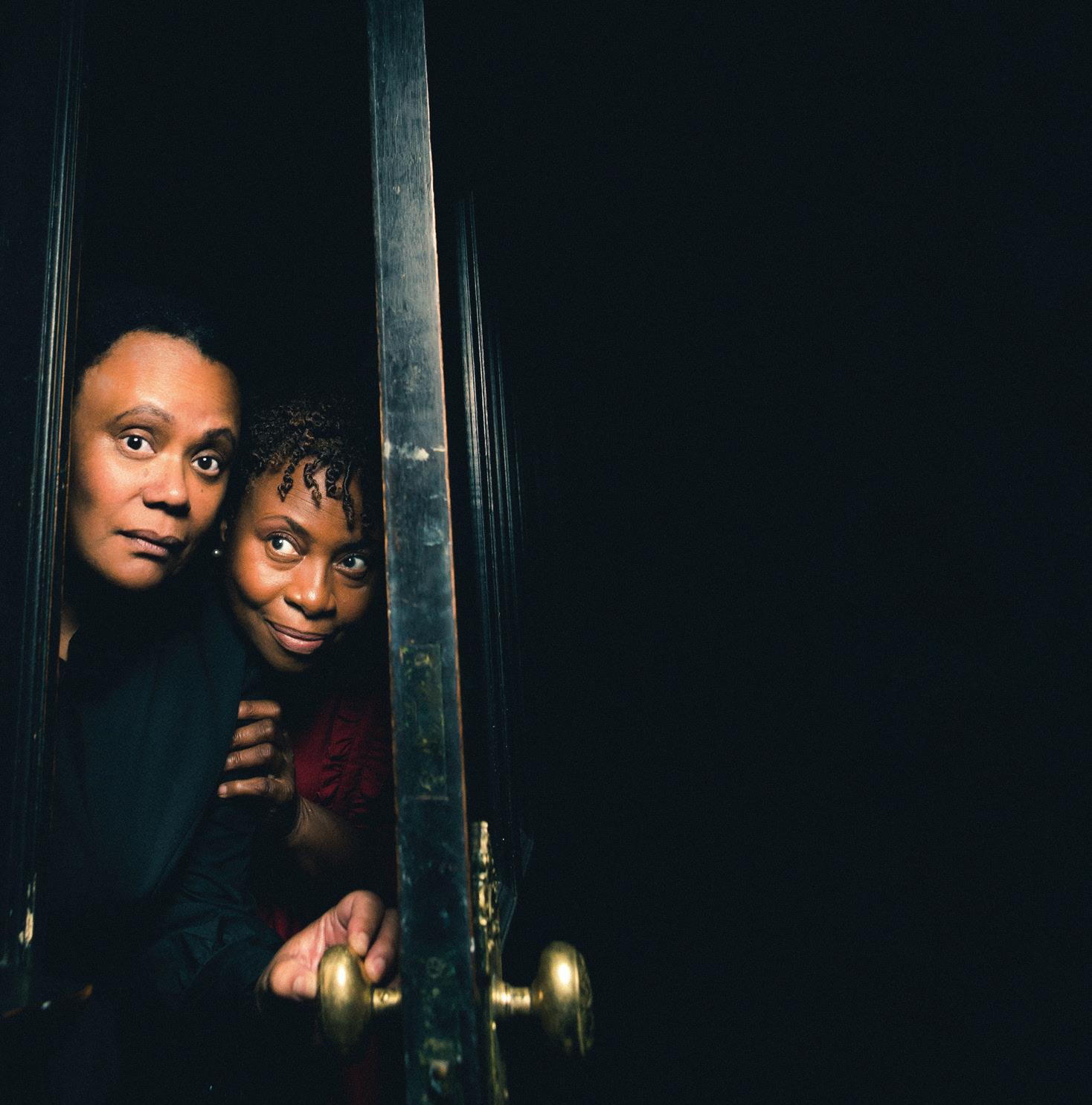
SEPTEMBER 15, 2022 - CHICAGO READER 35 Sponsored by Allstate and Gustavo Bamberger and Martha Van Haitsma Ron OJ Parson’s residency is supported by The Joyce Foundation 2022 TONY AWARD REGIONAL THEATRE ARSENIC OLD LACE AND sept 2 –oct 2 original broadway production by howard lindsay and russel crouse directed by ron oj parson by joseph kesselring 5535 S Ellis Ave, Free Parking (773) 753-4472, CourtTheatre.org
Photo: Celeste Williams and TayLar (Mazza).
THEATER & ARTS THEATER & ARTS
 SKETCH COMEDY PHOENIX
SKETCH COMEDY PHOENIX











iO improvises its rebirth
The comedy giant returns with help from old hands and fresh talent.
By WANJIKU KAIRU
After the comedy revolution during the COVID-19 pandemic, when many performers began speaking out about toxic culture in the sketch and improv world, iO was one of the many theaters that had to close its doors, seemingly for good. Upright Citizens Brigade, which began its life in Chicago, closed its longtime New York venue; they also faced charges that they had fostered institutional racism. While many theaters remained open, mainstays like Second City had to completely rethink their mission towards diversity and inclusion.
After the iO space was purchased by real estate executives Scott Gendell and Larry Weiner in 2021, it, too, needed such a makeover. Annoyance Theatre’s Jennifer Estlin and
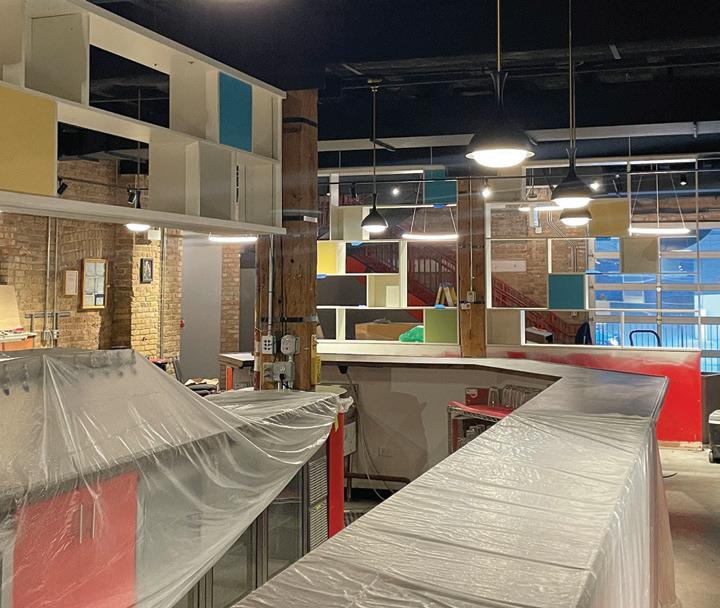
Mick Napier stepped in to help guide iO into the comedy future.
For Estlin and Napier, the most important step was hiring a core management staff. These newest staff members are an integral part of the conversation in filling in the blanks on what is happening with the new iO.

Under Charna Halpern’s management, iO faced allegations of institutional racism, leading to a petition from BIPOC performers that circulated prior to Halpern’s decision in summer of 2020 to close the theater. There had also been earlier allegations that Halpern had not done enough to address a culture of sexual harassment both in Chicago and at the now-shuttered iO West. Halpern and iO weren’t alone in facing such allegations; Sec-
ond City’s former owner, CEO, and executive producer Andrew Alexander stepped down in 2020 after Black performers went public with what they experienced there, and SketchFest founder Brian Posen stepped down in 2018 from the festival and as executive director for Stage 773 in the wake of widespread allegations of sexual harassment. (That venue is in the process of reinventing itself as Whim, an “experiential theater” with cocktails.)
The familiar pattern is that theaters caught in these controversies often hire “diversity consultants,” but, for those who have followed the scene for a while, it often feels like a never-ending trail of “woke-washing” in hopes of convincing us that these institutions are actually trying to do better.

All that being said, much rests on the backs of new iO artistic directors Katie Caussin and Adonis Holmes. Caussin has been around the improv scene for many years as a performer at iO, Second City, and the Annoyance and knows the nuances and history of the community, their performers, and producers. Holmes is newer on the scene but has been highly involved in both the Annoyance and iO. He is currently a Bob Curry fellow at Second City (a program designed to foster diverse talent, named for the first Black member of Second City’s resident company).
Not every team member is new to iO. Managing director Steven Plock worked at the theater before they closed their doors in 2020. Plock’s institutional knowledge means he is very familiar with how the business was run previously, for better or for worse. During the pandemic, Plock went out west and worked at a “cowboy bar,” so he’s surely ready to wrangle whatever needs wrangling. His food and beverage experience is a plus, since that’s a major area of revenue for the for-profit theater.
Classes are also a major revenue driver, and Rachael Mason, known as one of Chicago’s top improvisers and instructors, will be leading classes as director of education. Mason will be managing the entire class program. Online classes, taught by longtime veterans such as Susan Messing, have been running for around three months already.



When Estlin met Kim Whitfield, she was doing a show at the Annoyance. Subsequently Estlin hired her to direct a show Annoyance was coproducing with Dispensary 33. Whitfield joins iO as managing producer, along with technical director Kyle Anderson and
Jesse Swanson, executive director, special programs/content. Swanson was formerly a production manager at Second City and producing artistic director at O -Color Comedy in Philadelphia.
It appears that diversity among staff is a priority and will continue to be for the new iO. Racist trends die hard, and have been known to kill theaters in the past in addition to alienating incredibly talented performers of color. What is also clear is that the new sta assembled with the input of Estlin and Napier all have deep roots in the improv and comedy scene.
By contrast, the new owners Weiner and Gendell do not, though they excel at the “business” side of running a business. The ownership team now also includes Steve Sacks, who recently sold his family’s truck-parts business and has put his focus and interests into iO. Sacks does have a history with comedy performance himself, having performed stand-up in Chicago and New York. Of the three owners, Sacks will be serving as iO’s CEO. He has become the most involved on a day-to-day basis, maintaining an office in the iO building on Kingsbury. When Sacks got involved, he read the petition that so many people had signed, and this was the driving force to his involvement in the investment process. Sacks says, “What a great thing if we can actually pull o an iO that has all the good stu and gets rid of the bad stu .”
In regards to how exactly Sacks and the team will combat years-old discrimination issues, Sacks had this to say: “It’s not enough to set up a diversity, equity, inclusion, and accessibility (DEIA) team and say, ‘Yeah, we checked that box.’ We really do want them to help us with concrete steps necessary to make performers and audience members feel safe. BIPOC performers didn’t feel comfortable, and we want to make sure they do feel at home and that this is a place they can thrive.”
In contrast to the way iO used to be run, Sacks states, “We’re not doing what was done before, which is one person deciding who does or doesn’t go on stage. One person deciding who is and isn’t paid. These decisions are going to be made collaboratively, and ownership is going to stay out of those decisions because we don’t want it to be a colonized management system. I think the DEIA is going to hold our future to the fire. Mistakes will be made, but we’re going to have to figure things
36 CHICAGO READER - SEPTEMBER 15, 2022 ll
iO undergoes interior renovation before reopening this fall. COURTESY IO
FALL

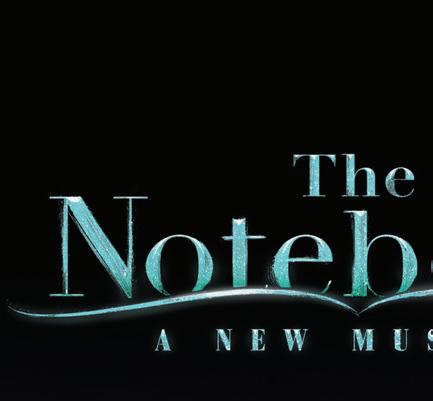










SEPTEMBER 15, 2022 - CHICAGO READER 37 CHICAGO SHAKESPEARE THEATER A World Premiere Musical based on the bestselling novel that inspired the iconic film NOW PLAYING IN A LIMITED ENGAGEMENT music
e Kenneth C. Gri n Charitable Fund LEAD PRODUCTION SPONSORS ADDITIONAL SUPPORT Production elements supported by the Anstiss and Ronald Krueck Stage Design Fund opera three penny the Mar 10 - Apr 30 refuge Oct 7 -Nov 13 Dec 2Jan 29 Jun 9 Jul 30 For tickets and more visit theo-u.com • 773.939.4101
and lyrics by INGRID MICHAELSON book by BEKAH BRUNSTETTER based on the novel by NICHOLAS SPARKS choreographed by KATIE SPELMAN directed by MICHAEL GREIF & SCHELE WILLIAMS
continued from 36

out as we go along. We are doing it in the spirit of collaboration and healing, the spirit of equity. That’s our objective.”
When it comes to working with owners who largely aren’t from comedy backgrounds, Estlin has found collaborating with them to be quite refreshing, as they are the first to admit they don’t know anything about theater.
“These are great people, and they have been super nice to work with, very supportive,” says Estlin. “It’s always amazing when someone says they don’t know anything about a topic. They are like sponges, soaking up every bit of knowledge,” adding, “They’ve put a lot of trust in Mick and I. It’s nice when someone asks you for help and actually trusts the help you are o ering.”
Building renovations are still underway and started about a month and a half ago under the direction of longtime Chicago scenic designer Bob Knuth, who has been generally working to make the bar area warmer and more conducive to hanging out with lots of people. Audience members should expect to see a refreshed and enlivened space.


Renovations at iO are expected to be finished by the second week of September, at which point they’ll begin hiring support staff for hosting, bartending, and box office. Sacks says, “Ownership believes that we can add value on the renovation of the building in creating a cozy and relaxing vibe and in allowing and facilitating our team to create hilarious shows. These creative decisions will be made in the most collaborative, equitable way possible.” Though construction and permit delays are always part of the equation, iO aims to have a soft open by early fall, with hopes of having an opening celebration closer to winter.

As far as growing postpandemic, Estlin
says, “We’re constantly having to remind ourselves that the old is the way things were, and this is what we do moving forward. We want to make sure it’s an equitable space that provides opportunities for as many types of people as possible. That is super important to all of us.”

Sacks and the team are committed to producing high-quality comedy. “The shows have to be funny. The quality has to be very high, and we believe there are enough talented diverse BIPOC and para-ability comics alike. We want it to be funny; we want it to be edgy. We want it to be challenging! We want to be proud of what we’ve done, and we all want to do something good for the community. If it can be a place of momentary joy and belonging, then we’ve done something. It’s an amazing, fun challenge for us. I get to hang out with these talented people, it’s like a blessing. Our goal is to earn the trust of improvisers, work sta , and audience members who may not have felt safe or comfortable at iO. We’ll strive to create a supportive, inclusive atmosphere, and we want people to hold us accountable to that. There was a lot of trauma, and we have to gain the trust of talented improvisers that would like to perform here.”
It’s yet to be determined what iO’s place will be in this new comedy landscape, but, given its long roots in Chicago, it’s a safe bet that expectations will be high. The theater has already started programming shows that will be ready to go up toward the beginning of fall. With the help of Estlin and Napier, and the business savvy of these new owners, iO looks to be on the road to make amends for decades of damage. With so much riding on the necessary changes to its previous exclusive culture, audiences and performers alike are eager to see the future of iO. v
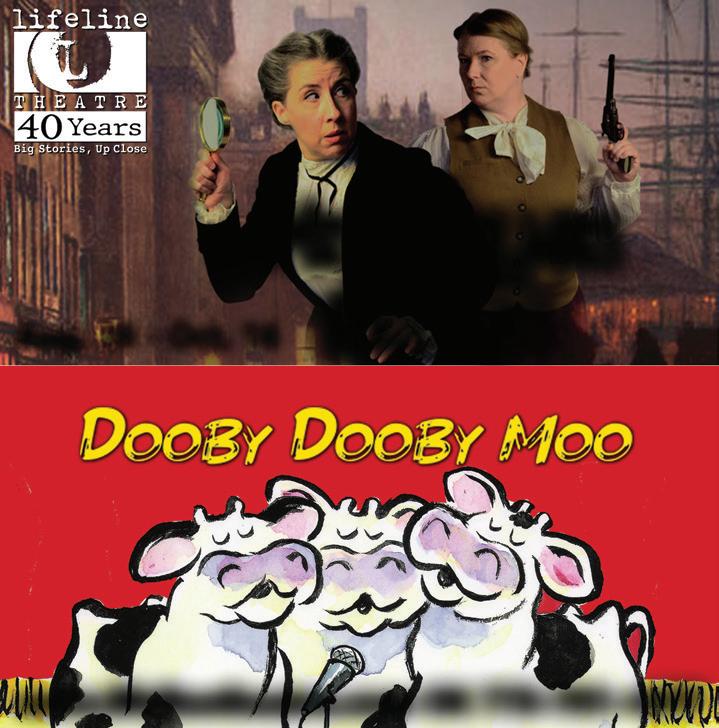
38 CHICAGO READER - SEPTEMBER 15, 2022 ll
@HolyBarbie
FALL
THEATER & ARTS THEATER & ARTS
A “cozy and relaxing vibe” is the end goal for the newly renovated iO. COURTESY IO







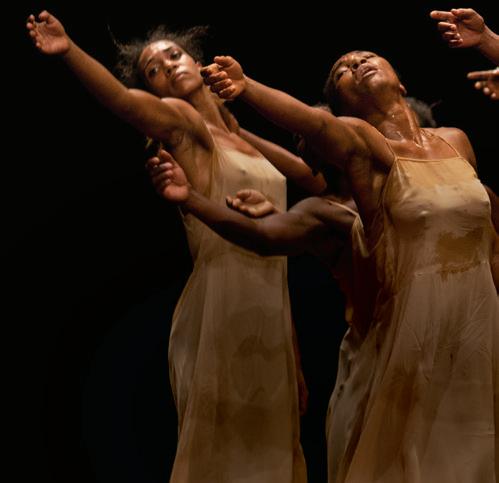
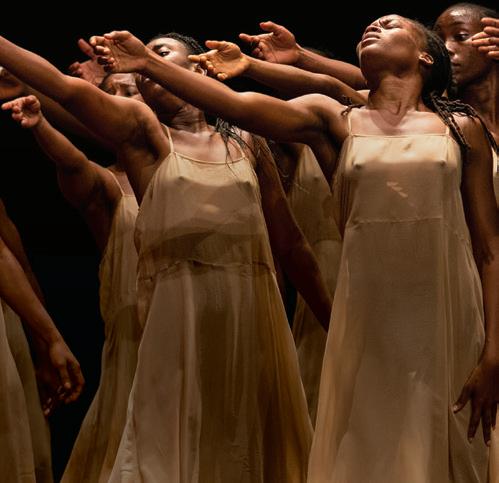
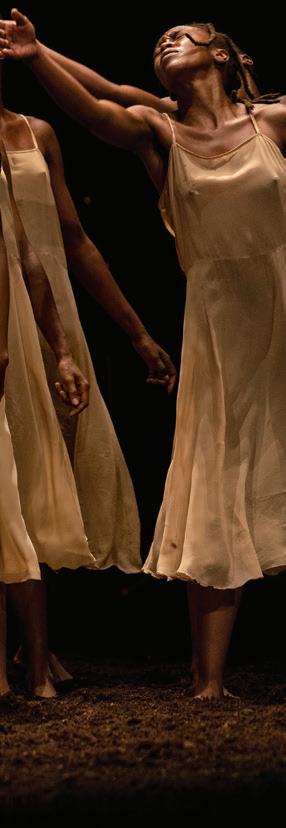


SEPTEMBER 15, 2022 - CHICAGO READER 39 HARRIS THEATER PRESENTS 22/23 DANCE Corporate Presenting Dance Sponsor The Irving Harris Foundation, Joan W. Harris HTP Mainstage Sponsor 312.334.7777 | harristheaterchicago.org | 205 East Randolph Street THE RITE OF SPRING / COMMON GROUND[S] PINA BAUSCH / GERMAINE ACOGNY + MALOU AIRAUDO October 27 + 28, 2022 / 7:30PM
The Rite of Spring .
Abby McCormick O’Neil and D. Carroll Joynes Engagement Presenting Sponsor
Photo by Maarten Vanden Abeele © Pina Bausch Foundation.







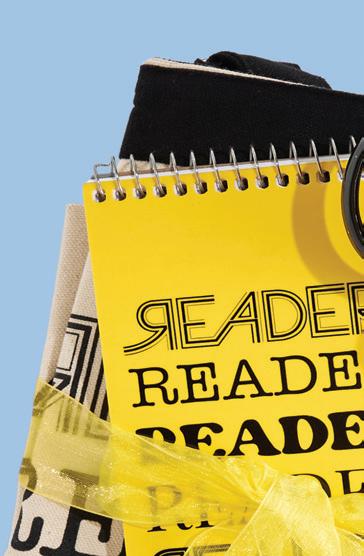


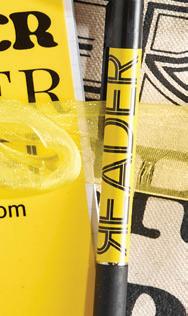
















40 CHICAGO READER - SEPTEMBER 15, 2022 ll SEASON SPONSOR 847-242-6000 I WRITERSTHEATRE.ORG FIVE WEEK RUN ONLY! SEPTEMBER 29 - OCTOBER 30 TICKETS ON SALE NOW: A critically acclaimed comedy about belonging, succeeding—and who we blame when we fail. PICTURED: DEANNA MYERS AND AURORA ADACHI-WINTER. PHOTO BY SAVERIO TRUGLIA. All $ spent on any resale items benefits the environment. By slowing virgin resource extraction, you help birds, bees, butterflies, and ALL WILDLIFE HABITAT! SOMETHING READER FOR EVERYONE! store.chicagoreader.com













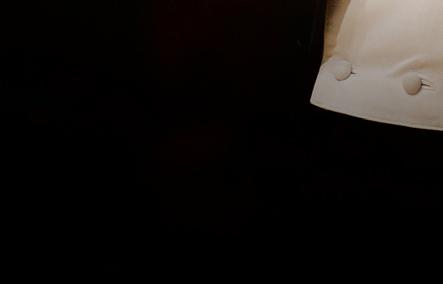





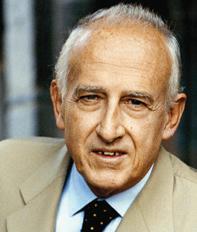

















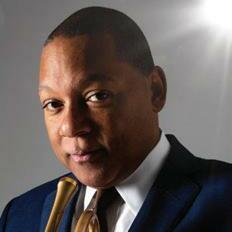









SEPTEMBER 15, 2022 - CHICAGO READER 41
Mavis Staples Daniil Trifonov Itzhak Perlman Don’t miss a moment of the spectacular 2022/23 Season! SCAN TO LEARN MORE CSO.ORG | 312-294-3000 Official Airline of the CSO Maestro Residency Presenter
Joshua
Bell Hilary Hahn Maurizio Pollini
light up
Wynton
Marsalis Riccardo Muti, the Chicago
Symphony
Orchestra and the world’s leading musicians and ensembles
Symphony Center.
GET YOUR TICKETS TODAY!
Jessie Montgomery
Evgeny Kissin
THEATER & ARTS THEATER & ARTS
Season of the witch
Karla Galván calls on old friends for her newest show at Teatro Tariakuri.
By JACK HELBIG
Karla Galván fell in love with performing when she was five, appearing in a public celebration of a Mother’s Day performance her mother had put together. “She’s like, ‘OK, mija, you’re going to dance,’” Galván remembers. “And so I danced to this song and I’ll never forget the adrenaline of the nerves going on stage, the nerves backstage, when you’re like, ‘Oh, it’s almost my turn.’ And then you cross that threshold. The stage back then looked huge with a full house of parents and students, and all these eyes were on me.”
Her love of performing flowered at Carl Schurz High School, where she was part of the drama and speech team. “We were the only school [in the speech competitions] that had







Latinos on their teams.” But her dreams were almost dashed by the cost of being a theater student at Columbia College. “‘You know what?’” Galván recalls her mother telling her. “‘I can’t afford to pay that. That’s way too much.’”
But her mother had a solution. Galván recalls her mother’s words: “‘What I can do is, I can send you to Mexico and learn as much as you can in Mexico City.’” Galván then adds, “My mom found a school in Mexico City and she said, ‘You know what? I’m going to send you there for a year.’”








She studied Method acting with Mexican actress Natalia Traven, a veteran of both the

most recently appeared as a leading character in Clint Eastwood’s 2021 film Cry Macho.) “I was fortunate,” Galván says. “Natalia Traven is a very important person to me because she’s the one that actually took her love and emotion and informed me as a creator.”
Galván returned to Chicago to break into the theater scene. “Every time I would go and audition, I would always get, ‘You sound great, but we need more Caucasian.’ I’ve literally been told that ‘You need to work on your accent.’ If I get cast, I am the maid, or I am the ex-con, and I would think, ‘Wait a minute. I know Meisner technique. I have learned Strasberg!’”
Finally, Galván reached the conclusion that the only way she was going to get work was if she started her own theater company.



“I was young, and stupid, and naive,” Galván laughs, “I was 24, 25.” She started her company in 2003 and decided on the name Tariakuri. “Yes,” Galván laughs. “Tariakuri is di cult to pronounce. I get it. And even my own husband
says that. But there is meaning behind that word.”
She named her theater in part in honor of one of her mother’s favorite performers, the Mexican singer Amalia Mendoza, nicknamed “La Tariácuri.” Mendoza, who died in 2001, was known for her highly emotional renditions of rancheras and boleros. She often cried as she sang. Galván jokes that her mother always said she was “a crybaby, too”— so much so that her mother jokingly compared her to Mendoza. But Tariakuri has another meaning. Tariácuri was also the leader of the Purépecha people, one of the last Indigenous tribes in Mexico. Galván is Peruvian and Mexican; the name Tariakuri honors her Mexican roots.
Tariakuri opened its first doors on 18th Street “right off Ashland” in Pilsen in 2004, and Galván produced shows there for four years. Her focus was on performing shows in Spanish by Mexican playwrights. She also favored doing comic plays with a family
GLOBAL DEPICTIONS OF A NEW IDENTITY
revealing look at same-sex desire.
The word “homosexual” was coined in Europe in 1869—unleashing stunning depictions of same-sex desire in the visual arts world. Discover how artists across five continents expressed queer identity in this pioneering survey of paintings, drawings, prints, photographs, film clips, and many national treasures—from public and private collections around the globe.

42 ll
FESTIVAL
DESTINOS
HIGHLIGHT
FALL
16
Sat
7
SUPPORT FOR THESE EXHIBITIONS IS PROVIDED BY ALPHAWOOD FOUNDATION CHICAGO IMAGE CREDITS: Roberto Montenegro, Retrato de un anticuario o Retrato de Chucho Reyes y autorretrato 1926, oil on canvas, 102.5 x 102.5 cm, Colección Pérez Simón, Mexico. (Detail)
BRUNA LA BRUJA BRUTA 9/ 17 10/
:
8 PM, Sun
PM, Teatro Tariakuri, 3117 W. 63 rd, teatrotariakuri. org, $ 35
A
ONLY
THE
AT WRIGHTWOOD 659 OCT 1 – DEC 17, 2022 wrightwood659.org
FIRST 1869-1930
CHICAGO WRIGHTWOOD PLEASE
The First
contains sexually explicit content. For mature
only.
NOTE:
Homosexuals
audiences
THEATER & ARTS THEATER & ARTS






music of the popular writer and performer of children’s songs, Francisco Gabilondo Soler, and a play about traveling theater troupes in Mexico, Tiempos de Carpa by Manuel Bauche Alcalde.




But the rising costs associated with the gentrification of Pilsen made it harder for businesses like hers to stay open. “I couldn’t keep afloat,” she says sadly. “It was heartbreaking. I was so upset. You close your business, your baby.”

After her first venue closed, Galván says, “I just got a regular job and was miserable for seven years. I was a medical biller, working collecting debts from patients. And then I also
do something. Is there any production going on?’”






Salas was doing a play, Las Vírgenes prudentes by Jesús Cotta, and he needed to cast the lead.
“And that’s when it all started again for me,” Galván enthuses. She revived her theater, moved into a storefront in Marquette Park, and then . . . “I started producing, producing, producing. I’ve done so many productions I already thought about. I redid a lot of my productions, a lot of everything, and I haven’t stopped since then.”
Her current production is a solo piece, Bruna la Bruja Bruta (which Galván translates

good teacher; I needed somebody that still has that sparkle of true Mexico because she lives there [in Mexico City].”
“Bruna is a single mom. She talks about being a single mom, and her three little witches, and how she survived with her three little witches. We’re talking about a witch that’s lived more than 200 years, so long that she has seen everything that’s going on in the world— feminism, machismo, Salem and the witches. And it does it all with comedy. I want to say it’s similar to John Leguizamo’s Latin History for Morons.”
Galván did much of her rehearsing with Traven in Mexico City. “I just came back from
Michiko Itatani has grappled with the mysteries of the universe in her work throughout her prolific career. This exhibition of 50 works celebrates the Chicago-based, American artist’s determination to “know the unknown.” Spanning two floors and myriad decades, the exhibition includes breathtaking, never-before-seen works

FALL SUPPORT FOR THESE EXHIBITIONS IS PROVIDED BY ALPHAWOOD FOUNDATION CHICAGO IMAGE CREDITS:“Collection Sol III” painting from Celestial Maze 22-B-1 Michiko Itatani, 2022, 78” x 96,” oil on canvas, courtesy of Michiko Itatani (Detail)
Explore mysterious portals to the unknown.
ONLY AT WRIGHTWOOD 659 OCT 1 – DEC 17, 2022 wrightwood659.org CHICAGO WRIGHTWOOD
THEATER & ARTS THEATER & ARTS


laidback, uninhibited, sometimes unhinged conversation that felt like an early hangout podcast or a midnight improv set. It served as a revolving door of upcoming talent and—just as importantly—a test-range comedy hub that made New York feel smaller and the improv nerd community feel bigger.
on-one form of the podcast is a complete 180 from TCGS’s carousel of madness, the heart of intimacy, authenticity, and risk is the same.
Chris Gethard tiptoes into uncharted territory


The comedian and podcaster finds comfort in his own skin.
By DAN JAKES
Comedian, author, and volunteer ambulance driver Chris Gethard may be a fully Boylan-blooded New Jerseyan, but he’s not shy about the extent to which his improv and stand-up DNA has been imprinted by the comedy scene here in Chicago.

“Years ago, I was booked to host a stage at Lollapalooza,” remembers Gethard as we talk, ahead of his back-to-back stand-up and live podcast recording shows next month at The Hideout. “I stopped by The Annoyance to see what was on, and it was The Holy Fuck Comedy Hour. It was Conner O’Malley, John Reynolds, Carmen Christopher, Gary Richardson, Annie Donley,” most of whom went on to contribute to The Chris Gethard Show in one form or another after moving out to New York during the late-night variety show’s formidable run. “That Chicago influence was really heavy on my show. It’s one of my favorite cities to perform in.”
The storyteller and comic gained mainstream visibility with his critically-acclaimed 2016 solo show Career Suicide—a frank, funny, and challenging monologue that laid bare his lifelong relationship with mental health crises—and as a standout talking head in Seth Porges and Chris Charles Scott III’s hit 2020 documentary Class Action Park. But for those in the know, Gethard, now 42, has been a prominent fixture of the alt comedy scene and a Pied Piper of punky weirdos for nearly two decades.
Following a multiyear run at New York’s now-defunct Upright Citizens Brigade, The Chris Gethard Show became a rebellious, inventive, sometimes anarchic Wednesday night Manhattan public access television staple (eventually picked up for a multi-platform, multi-season cable hinterlands cult run) that featured call-in segments, musical guests, characters, games, sketches, and the sort of
“When I look at my work, and I look at the stu people have responded to the most, if I’m being honest, I’ve spent a lot of my life feeling very alone, very much like I’m living in my own head,” says Gethard, “And I think a lot of the stu that I’ve done has kind of appealed to other people who feel that same way.” Stu ed with more bodies than could fit in frame in any given shot, TCGS was a full house both literally and in its programming, featuring no fewer than a half dozen gags or threads or inside jokes to cut away to or introduce at any given moment. And, for Gethard, most of them involved pushing himself or others outside their comfort zone.






“ Beautiful/Anonymous has been so empowering to me. I think listeners often feel empowered because they get a platform, but I actually feel like it’s kind of released me from some of the more gross, ego-driven sides of comedy. I’m able to let that attention go. So, a lot of that is just because I wound up in this project where it asked me to prioritize listening more than talking. And the long version of that is, it asked me to prioritize other people over myself.”


CHRIS GETHARD







Sat 10/8: Beautiful/ Anonymous taping 7 PM, stand-up set 9 PM, the Hideout, 1354 W. Wabansia, 773 227 4433, hideoutchicago.com, $20 ($ 30 both shows)
“Back in my old public access days, I felt really compelled to, you know, hire a kickboxer to come beat me up on TV. See what the crowd thinks of that. Do stu that put me in harm’s way, stuff that made people uncomfortable. Definitely, you know, some Andy Kaufman in there. Definitely some David Letterman in there. Like, let’s just shake it up. See how they deal with it.” Even during the show’s earnest, character-breaking 100th episode celebration, the cast delivered teary-eyed heartfelt testimonials to one another under the headphone duress of a Speech Jammer that added a comedic, gently humiliating wrench in the feels.
Now married to longtime collaborator Hallie Bulleit, living in the New Jersey suburbs, and the father of a three-and-a-half-year-old, Gethard’s work has adopted a stripped-down but still raw sense of risk, both in his stand-up and the Beautiful/Anonymous podcast, where unnamed callers have an organic, uninterrupted or edited chat about whatever is on their mind. A woman in Canada plans a wedding. Foster parents discuss the emotional maturity necessary to live in a state of uncertainty. A woman in the midwest prepares to turn herself in to federal prison. A barber talks cowlicks and says hey. Even though the one-
Part of the brilliance and bravery of Beautiful/Anonymous , like Gethard’s stand-up, is a willingness to let reality breathe a little, to favor authenticity over airtightness. “What I’ve noticed is a lot of times, when people call up, they have a little bit of an outline that they’ve gone over in their head, right? I think sometimes it’s actually been very cathartic for people to realize, like, ‘Oh, you called up, and you want to tell me about something that caused great trauma in your life, and it didn’t even fill an hour.’ Isn’t that kind of an encouraging thought?” Often, that format translates to the caller vocalizing the most pressing issue of their lives, feeling a bit lighter, and then engaging in a more truly off-the-cuff, in-the-moment conversation.
crowd thinks of that. Do stu that put me in feeling a bit lighter, and then engaging in
And if that sounds like it might get a little boring sometimes: yes. And that’s OK.
“There’s this idea out there [that] it’s a lot braver to be boring onstage than exciting all the time. With those boring moments, it can be pretty intimidating. You can feel the crowd’s restlessness, but, if you can push through them, you might get something pretty great on the other side that’s not going to be dominated by this desperate need to make sure everybody’s doing great all the time.
“In fact, some of my happiest moments are the moments where I’m most bored, because it means there’s no drama in my life. It means that there’s no worries. It means that my to-do list isn’t running over, and I’m not dropping the ball and stuff. Being boring is actually, oftentimes, a reflection that things are going well. I’ve lived through a lot of excitement. It was my 20s and 30s. Now? Boring feels awesome.” v
44 CHICAGO READER - SEPTEMBER 15, 2022 ll
Chris Gethard COURTESY THE ARTIST
COMEDY PODCAST
@DanEJakes
FALL



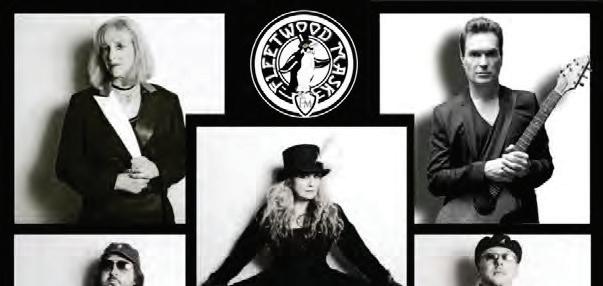







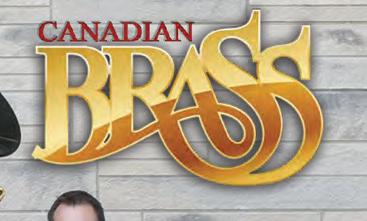












SEPTEMBER 15, 2022 - CHICAGO READER 45
THEATER & ARTS THEATER & ARTS

Tools for new movement
 By IRENE HSIAO
By IRENE HSIAO
On September 24, Toolbox @ Twenty opens at the Hyde Park Art Center (HPAC) to celebrate the Seldoms’ 20th anniversary with an exhibition and performances in a large-scale experiment in collaboration among dancers, visual artists, and the alternative visual arts exhibition space. Curated by the Seldoms’ founding artistic/executive director Carrie Hanson in collaboration with HPAC director of exhibitions and residency Allison Peters Quinn, Toolbox @ Twenty pairs Hanson with multidisciplinary artist Edra Soto, Damon Green with sound artist Sadie Woods, Maggie Vannucci with painter Jackie Kazarian, and Sarah Gonsiorowski with fiber artist Jacqueline Surdell to create new works. Over the course of six weeks, the Seldoms will o er six free live performances, followed by conversations with the artists.

The Seldoms was founded in 2001 by Hanson, choreographer Susan Hoffman, and visual and performance artist Doug Stapleton. “The Seldoms name, we found it in a book of photography about bodies,” recalls Hanson. “The original Seldoms did tableau vivant-style performance in the 1800s in London—we just liked the name.” Under Hanson’s direction

















after the first two years, the Seldoms has retained an interdisciplinary focus, occasionally still in collaboration with Stapleton, who helped facilitate the first Toolbox, which launched in Glasgow in 2017.
Visual art is “in the DNA of what we do,” says Hanson. “It’s not usually the starting point, but we’ve always paid attention to set design and to the extension of the idea through video and animation. One of my favorite projects, Marchland [2010], came out of working with artist Fraser Taylor. He’s in Glasgow now, but taught at SAIC. He collaborated with a video artist and made marks directly onto film. I responded to Fraser’s piece and his practice of markmaking. Bob Faust has worked with us on just about every project since Power Goes [2014]. For Rockcitizen [2016] my piece about the 1960s, I was thinking I wanted something psychedelic that changes form and shapeshifts. He started thinking about stretchy materials, and he was like, ‘What about bras?’ So we had somebody sew together 208 bras to create what he called ‘the brascape!’”
Hanson turned to Toolbox as a means to reinvigorate her own creative process. “I’d already been choreographing a long time,

feeling stale and knowing that I work with a formula,” she says. “So what can we do to disrupt that?” She developed a method that starts with a conversation about process with a visual artist. Together, they decide on a single word, usually a verb, to describe the process. Using this word as a “tool” or prompt, the dancemaker then creates new movement.
“The outcome is less important than the dialogue,” says Hanson, who has taught the method in her composition courses at Columbia College and the University of Wisconsin-Madison, where the students expanded the process to include any kind of practitioner. “One of my students interviewed a PhD student in ethnomusicology who was in Mongolia working with sheepherders. The sheepherders sing to their sheep. So this got translated into something the dancers could do together: people are paired up, one is vocalizing or generating sound, knocking your fist against the floor, snapping, rubbing your hand on your knee or whatever, and the person listening is improvising and moving. It gets you thinking in a di erent way.”
sound elements, all these supporting things that tell me more that it’s about the topic, but I don’t see it in the movement.’ I want to push movement to be as explicit and carry as much content as it can, so the choreographers aren’t always relying on spoken word or set or surrounding environment to give the movement meaning.”

For Toolbox @ Twenty, Hanson worked with Quinn to select the four visual artists, three of whom have collaborated with the Seldoms in the past and all of whom have exhibited work at HPAC. “I had been to the first collaboration with Fraser Taylor, an artist we showed in the past,” says Quinn. “I remember being blown away that the dancers integrated the artist’s work into their movements. I was interested in how that process worked. It felt like a new way to think about creative collaboration where both people have agency. [In Toolbox ], the dancers are not responding directly to the work you’re seeing; they’re responding to the gestures and process of the artist.
TOOLBOX @ TWENTY 9/24 11/ 13 : Mon-Thu 10 AM-7 PM, Fri 10 AM- 4: 30 PM, Sat 10 AM- 4 PM, Sun 10 AM-1: 30 PM; performances Sat 9/24 1: 30 and 3 PM, Thu 10/6, 10/20, and 11/36 PM, Sat 10/ 15 1 PM, Hyde Park Art Center, 5020 S. Cornell, 773 324 5520, hydeparkart.org, theseldoms.org, free.
The first time dancers will see the work is next week when they do a rehearsal in the space for the performance. It’s crazy but so exciting!”
While primarily used to spark new ways
While primarily used to spark new ways of devising movement, the tools they have found sometimes find their way into finished choreography for the Seldoms. “We’ve used ‘lift’ quite often,” says Hanson. “‘Lift’ came from Fraser Taylor. He does prints: he paints a surface, then puts down a piece of paper and presses it, then lifts it o the plate. You can do multiple prints, and the paint becomes lighter and lighter. A lift—in our translation—you have to do two things: you have to reverse it (if the ‘plate’ starts on the right side of the body, you do it on the left side), and you do it repeated times—and every time you do it, it diminishes a little bit. In a way, some of these tools have quite strict rules to them!
“When we first started this in Glasgow with five artists, trying to translate, it was very heady. I was not only wanting to invigorate my practice but also thinking about evidence. I’m guilty about it like anyone else. But when the choreographer says, ‘This dance is about this,’ and you’re looking at it, like, ‘I don’t see that. I see you’ve given it a title, a costume, some
Toolbox has also created an opportunity for HPAC to reconceive curation, their exhibition space, and the parameters of collaboration. “With this project we’ve made it so there’s a generous amount of room in the gallery to make room for bodies and to make distinct shifts between the pieces,” says Quinn. “This is not a group show where we’re talking about a theme or something consistent in everybody’s work—everybody’s work is so di erent!”
Looking back on 20 years of the Seldoms, Hanson says, “I feel both fortunate and responsible for this house that I’ve built, where people can come in and assemble, and we invite di erent people in at di erent times to spend some time. I like that our creative processes are a year or two years. I feel good that the ensemble members, even those who have left, have been like a family. I feel loyal when I find collaborators that I want to work with. I feel this combination of fortune, responsibility, and gratitude. It really is about collaboration. It’s about these other artists I’ve been lucky to work with.” v
46 CHICAGO READER - SEPTEMBER 15, 2022 ll
The Seldoms ANDREW GLATT DANCE
“The outcome is less important than the dialogue.”
@IreneCHsiao
FALL























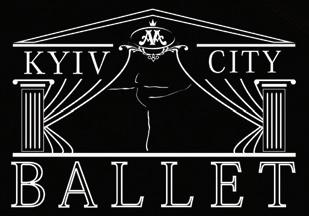


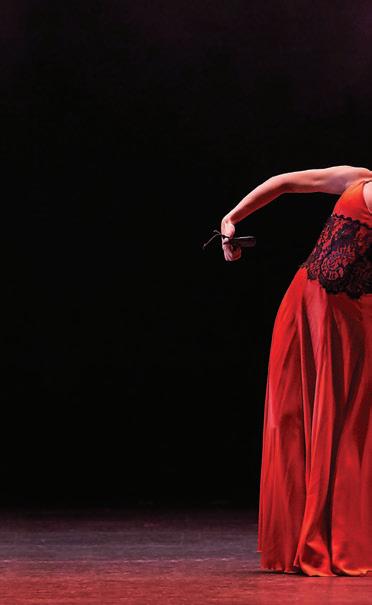


SEPTEMBER 15, 2022 - CHICAGO READER 47 BECOME A MEMBER Tickets start at just $20 steppenwolf.org 312-335-1650 2022/23 GRAND BENEFACTORS 2022/23 BENEFACTORS for the 2022/23 season. Great seats, great deals and great vibes. THE MOST SPECTACULARLY LAMENTABLE TRIAL OF MIZ MARTHA WASHINGTON NOW THROUGH OCTOBER 9 By James
Directed by Whitney White A BOLD, FANTASTICAL AND UPROARIOUS REMIX OF AMERICAN HISTORY
Adapted
OCTOBER 4 – OCTOBER 29 A HOPEFUL, LYRICAL EXPLORATION OF BLACK CHICAGOAN’S RESISTANCE STEPPENWOLF.ORG/MEMBERSHIPS THIS FALL AT Vladyslav Dobshynskyi, photo courtesy of Kyiv City Ballet. 2022–23 SEASON SPONSORS O cial Hotel Partner 2022–23 SERIES SPONSOR Florian Fund Global and Chicago Dance KYIV CITY BALLET SPONSORS Presenting Sponsors The Polsky Foundation SEPT 24 + 25 AuditoriumTheatre.org 2022–23 SEASON SPONSORS O cial Hotel Partner 2022–23 SERIES SPONSORS Florian Fund Global and Chicago Dance Chicago Dance Joyce Chelberg Pamela Crutchfield Patti Eylar and Charlie Gardner Flamenco Passion ONE NIGHT ONLY | OCT 1 Feel the fiery spirit of España! AuditoriumTheatre.org 312.341.2300 Monica Saucedo in Horizonte, photo by Dean Paul.
Ijames
By Eve L. Ewing
by J. Nicole Brooks
Directed
by Gabrielle Randle-Bent and Tasia A. Jones
RTHE MOST SPECTACULARLY LAMENTABLE TRIAL OF MIZ MARTHA WASHINGTON Through 10/9: Tue-Fri 8 PM, Sat 3 and 8 PM, Sun 3 PM; Wed 9/28, 2:30 PM only, Steppenwolf Theatre, 1650 N. Halsted, 312-335-1650, steppenwolf.org, $20-$96
First Lady fantasia
The Most Spectacularly Lamentable Trial of Miz Martha Washington presents a comic historical nightmare.
By KERRY REID
Right before the pandemic shutdown in 2020, TimeLine Theatre presented James Ijames’s sorrowful and powerful Kill Move Paradise, in which a group of Black men murdered by the police gather in a purgatorial afterlife, where a fax machine spits out an ever-growing list of more Black people killed by the state. At the same time that Kill Move Paradise was in production, Steppenwolf was preparing to open Ijames’s The Most Spectacularly Lamentable Trial of Miz Martha Washington , starring Nora Dunn as the first First Lady facing her own hallucinatory hellscape on her deathbed.
The difference, of course, is that Martha Washington deserves the mental damnation she’s caught up in. She owned other human beings, after all. Sure, it’s possible to parse the historical record to find the loopholes that tell us that gosh, she just didn’t have the legal right to manumit the people she inherited from her first husband’s estate. And Queen Elizabeth II couldn’t single-handedly grant independence to countries colonized by the empire, but that
doesn’t stop those oppressed in her name from celebrating her demise. (See Black Twitter, Irish Twitter, etc., etc.) The Black people in Martha’s household are ready to party when she goes. But first, they’re determined to hold their “mistress” accountable through a series of visitations and interrogations.
Ijames’s play, now finally making its long-postponed Steppenwolf premiere, isn’t about making nice with White Woman Tears. When Cindy Gold’s Martha resorts to that tactic at one point in the show, it feels like watching any of numerous Karens-Caught-onCamera videos on social media of nasty racist women pleading white innocence. His 90-minute piece draws on pop culture, from game shows to The People’s Court , where Martha tries to plead her case, to tease out the historical record. Director Whitney White’s superb ensemble leans into the anachronistic anarchy and hilarity of these interludes without losing sight of the characters’ underlying rage.
What’s really on trial here (and this was also a theme in Kill Move Paradise, where our func-
tion as spectators to injustice was interrogated by the characters) is white complicity. Martha could free the slaves that George left her (and that he instructed in his will would be freed upon Martha’s death) at any time. All her hemming and hawing and poor-poor-pitiful-me posturing doesn’t cover up one simple fact: she doesn’t want to do it. She enjoys having other people in her power.
More outrageously, she wants to continue the fiction that they actually love and care about her. Even as her deathbed nightmares (which at times evoke the visit of Ethel Rosenberg to Roy Cohn in Angels in America) convince her that the people she owns are plotting to kill her, she won’t do the obvious thing to fix that problem. As the chorus of slaves tells her near the end, “FREE us. Damn!”
It’s monstrous. It’s America. And Ijames’s play is about laughing bitterly in the face of the comforting myths constructed around the Founding Fathers and Mothers. That might seem like a bit of an easy target, but given how much of a price we’re still paying for coddling
those who would rather have white supremacy than democracy . . . well.
The great strength of Ijames’s script is that it’s not merely a jeremiad about the evils of slavery. It’s about how the foundational ideals we claim as a nation have all been tainted by that original sin. Including the notion of “family.” Victor Musoni’s William visits Martha’s dream early on, reminding her that he is both her nephew and her grandson; his mother, Ann Dandridge (Nikki Crawford) is Martha’s half-sister, and his father was Martha’s stepson. Rape was one of the bedrocks of slavery; denial of family bonds came easy for those who profited by it.
Gold’s Martha is a marvel of fluttery toxicity, playing up her self-imposed victimhood like a bird pretending to have a broken wing. Crawford’s Ann provides the moral center as a woman forced into the role of Martha’s boon companion. The pain of that grotesque relationship comes through clearly in quieter moments amid the madcap satirical narrative.
Donovan Session and Carl Clemons-Hopkins as Sucky Boy and Davy, two of Martha’s slaves, deconstruct old minstrel tropes in their comic interactions. (Clemons-Hopkins is familiar to fans of Hacks as Marcus, the assistant to Jean Smart’s demanding comic diva; they also make a hilarious cameo as George, telling Gold’s Martha “That booty is checked and balanced!”)
Sydney Charles and Celeste M. Cooper work in similar tandem as Priscilla and Doll, two of Martha’s slaves, and also as Abigail Adams and Betsy Ross (Izumi Inaba’s costumes provide their own running comedic commentary throughout).
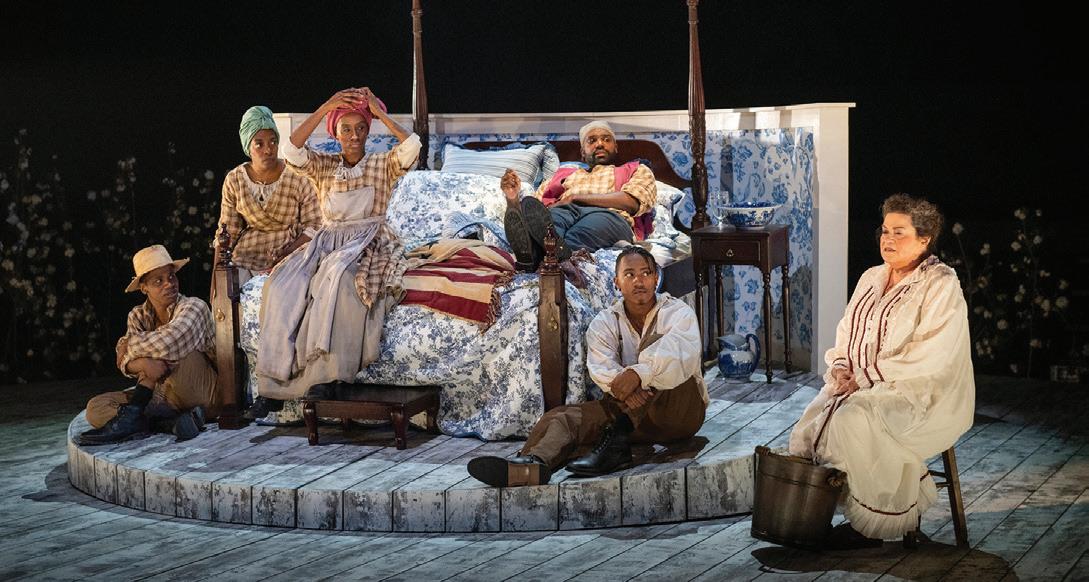
It’s crucial to understand that Ijames has framed this story as a dream/nightmare. But underneath the scattershot historical tidbits, righteous anger, and harsh laughter is a larger question: how much are we collectively responsible for each other and for the dream of the nation we share? And how long will it be till we do the right thing? v
@kerryreid
48 CHICAGO READER - SEPTEMBER 15, 2022 ll
The Most Spectacularly Lamentable Trial of Miz Martha Washington at Steppenwolf Theatre MICHAEL BROSILOW
THEATER
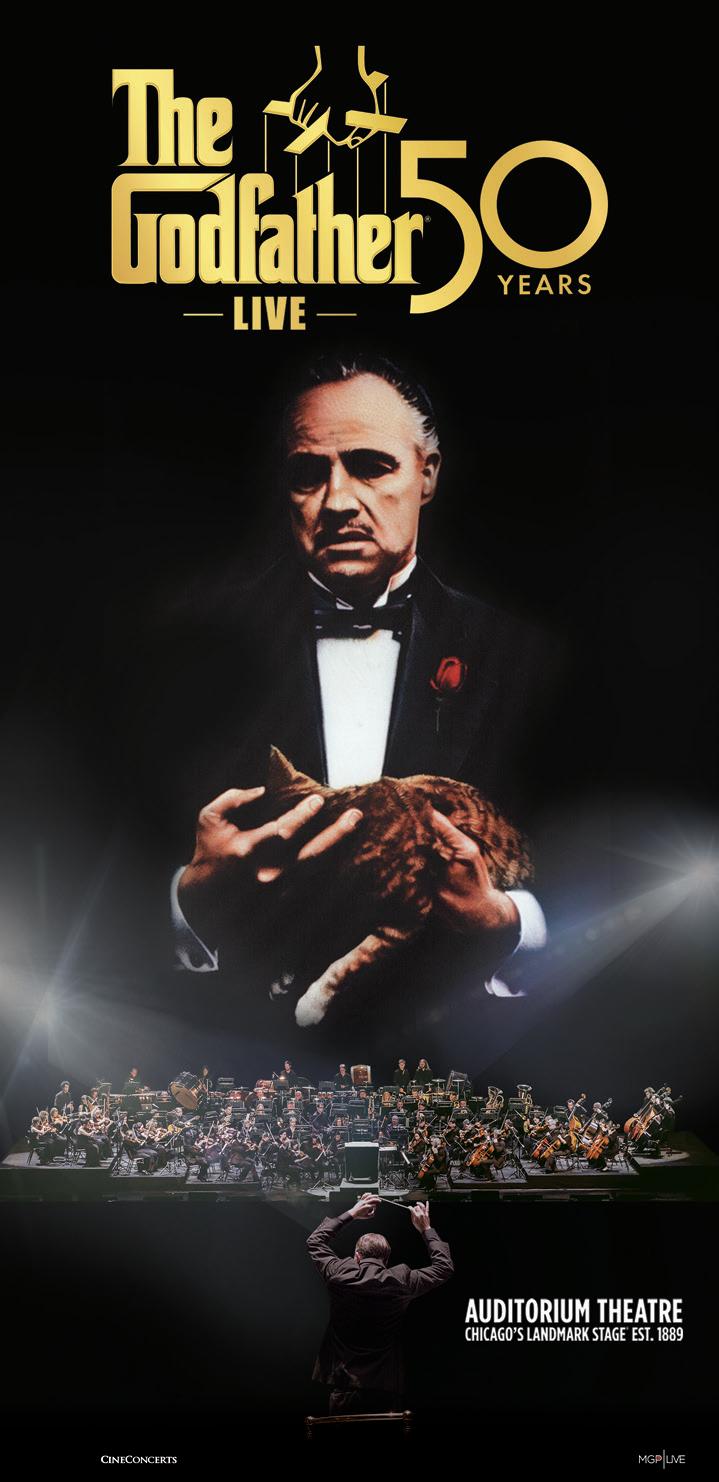



SEPTEMBER 15, 2022 - CHICAGO READER 49
OPENING
R Elderberry wine in new bottles
Court’s Arsenic and Old Lace is crazy fun.
Long before the term “meta” entered common parlance there was Arsenic and Old Lace, a 1939 play by Joseph Kesselring about how plays are ridiculous. It’s also a play about the difference between reality and appearance, embodied by the saintly Brewster sisters and their killer elderberry wine.
But don’t let my interpretive flourishes put you off: Arsenic and Old Lace is still the comedy you remember about crazy people who think they’re sane driving genuinely sane people crazy. Mortimer Brewster (Eric Gerard, charming and preternaturally graceful) discovers that his aunts have been poisoning old men and having them buried in the cellar by their nephew Teddy (an appropriately stentorian Allen D. Edge), who imagines he’s Teddy Roosevelt digging the Panama Canal. The aunts (TayLar and Celeste Williams, each with her own perfectly-rendered version of old-maidhood) don’t see that they’re doing anything wrong, despite a strict moral code which frowns on Mortimer’s exposure to the sinful world of theater. When long-lost nephew Jonathan (A.C. Smith, in a comically terrifying high state of pissed-ivity) shows up toting a body of his own, complications—more complications!—ensue.
Director Ron OJ Parson handles this multi-ring circus with the perfect light touch. The ensemble plays the text’s outlandishness as if it were ordinary behavior and couples it with superb bits of physical comedy. John Culbert’s scene design conjures a Victoria dream house, complete with a staircase sturdy enough for Teddy’s
repeated charges up San Juan Hill and a window seat capacious enough for several bodies at a time. —KELLY KLEIMAN ARSENIC AND OLD LACE Through 10/2: Wed-Fri 7:30 PM, Sat-Sun 2 and 7:30 PM; audio description Sat 10/1 2 PM (touch tour 12:30 PM), open captions Sun 10/2 2 PM, ASL interpretation Sun 10/2 7:30 PM, Court Theatre, 5535 S. Ellis, 773753-4472, courttheatre.org, $40.50-$82
RFlawlessly in tune
Dreamgirls delivers at the Paramount.
Originally conceived in the mid-70s as a vehicle for Nell Carter but opening on Broadway in 1981 with Jennifer Holliday in the role that might have been Carter’s (if Carter’s Hollywood career had not blown up), Tom Eyen and Henry Krieger’s musical about the rise of an African American girl group the Dreams (modeled on the Shirelles and the Supremes) is remarkably fresh and cliché-free for a showbiz bio. Even the score, which intentionally mimics tunes of the era (early 60s to mid70s), never for a moment feels fake, forced, or recycled.
My current enthusiasm for this show is all the greater because of the flawless, full-throttle revival I saw this weekend running at Aurora’s Paramount Theatre. There is not a slow minute or false step in this glorious production. Eyen and Krieger pack a lot of musical history into the show’s two and a half hours—which includes references to payola, cultural appropriation, the rise of rock ’n’ roll, the breaking up of showbiz segregation—and at times two or three plot lines are playing out in a single musical number. But under Christopher D. Betts’s direction and Amy Hall Garner’s powerful choreography, it all unfolds gracefully, flowing from one vivid number to the next on Jeffrey D. Kmiec’s inventive, eye-pleasing set.
The ensemble couldn’t be tighter, led by Taylor Marie Daniel as the Diana Ross-like Deena Jones and Lorenzo Rush Jr.’s Berry Gordy-ish Curtis Taylor Jr. And Naima Alakham simply kills as Effie, the cast-off member of the Dreams who must find her own path to greatness.


—JACK HELBIG DREAMGIRLS Through 10/16: Wed 1:30 and 7 PM, Thu 7 PM, Fri 8 PM, Sat 3 and 8 PM, Sun 1 and 5:30 PM; ASL interpretation Fri 10/14 8 PM, Paramount Theatre, 23 E. Galena, Aurora, 630896-6666, paramountaurora.com, $28-$79
Trash talk
The Garbologists could afford to dig deeper into the mess.
Lindsay Joelle’s The Garbologists, now in a local premiere at Northlight under Cody Estle’s direction, is a slice-of-life two-hander about an odd-couple pair of New York sanitation workers. Marlowe (Tiffany Renee Johnson) is a Black woman with multiple degrees in art history from Columbia. Danny (Luigi Sottile) is a brash motormouth from Staten Island, bent on showing off his street smarts to the new hire with garbage-collector inside jokes about “disco rice” (maggots) and “urban whitefish” (used condoms), as well as “mongo” (the trash that the collectors repurpose for themselves; one of those items becomes a plot point). Over 90 minutes of short scenes, played out on Collette Pollard’s cunning set (including a facsimile of the business end of a garbage truck), the two come to understand some things about the detritus of each other’s lives as well as that of the strangers along their route.
It’s a good-hearted piece, with exceptionally fine performances from Johnson and Sottile, but the revelations feel a little too forced and contrived to carry
the narrative weight for the show. The small off-the-cuff jokes and exasperated reactions from Sottile and Johnson, respectively, offer comfort-food familiarity for anyone who has been stuck in a small space for hours with someone they’re not sure they want to get to know better. I just wish that Joelle’s story had taken a few more risks, rather than relying on what ultimately feels like a formulaic approach to unpacking the messy black plastic bags of personal loss for Marlowe and Danny. —KERRY REID THE GARBOLOGISTS Through 10/2: Wed 1 and 7:30 PM, Thu 7:30 PM, Fri 8 PM, Sat 2:30 and 8 PM, Sun 2:30 PM; sensory-friendly performance Wed 9/21 7:30 PM, captioned performance Fri 9/23 8 PM, open caption and audio description Sat 9/24 2:30 PM, Northlight Theatre, North Shore Center for the Performing Arts, 9501 Skokie Blvd., Skokie, 847-6736300, northlight.org, $30-$89
R Monster mash-up
Manual Cinema and Chicago Children’s Theatre bring Leonardo! to stage and screen.
Chicago Children’s Theatre’s 18th season kicks off with Leonardo! A Wonderful Show About a Terrible Monster!, an innovative production from the Emmy Award-winning multimedia performance collective, Manual Cinema.
Based on two books by children’s author Mo Willems, Leonardo! follows a young monster who is woefully terrible at being a monster. Despite his best efforts, he’s simply too adorable to scare anyone. But when he finds the opportunity to scare Sam, the “most scaredy-cat kid in the world,” Leonardo learns an equally heartening and humorous lesson about finding his voice, the power of friendship, and using his strengths for good. The story was adapted for the stage by Manual Cinema
50 CHICAGO READER - SEPTEMBER 15, 2022 ll
THEATER
Arsenic and Old Lace at Court Theatre MICHAEL BROSILOW
Dreamgirls at Paramount Theatre LIZ LAUREN
THEATER






codirectors Sarah Fornace (who also directs the show) and Drew Dir. (The third Manual Cinema codirector, Ben Kauffman, created the music, lyrics, and sound design with Kyle Vegter).














As the production company’s name suggests, the show’s four-person cast executes the story as a DIY film, projected onto a screen set above the stage. Each performer helps bring Leonardo’s story to life using a carefully thought-out fusion of lively puppetry, intricate paper cutouts, and amusing character work, complete with playful costumes and Kauffman and Vegter’s live music. While the story is well-suited for young children (the company recommends it for ages 2-11), audiences of all ages can appreciate Manuel Cinema’s immersive visuals and impressive technical setup that seamlessly blends the stage and screen.



—KATIE POWERS LEONARDO! A WONDERFUL SHOW ABOUT A TERRIBLE MONSTER Through 10/16: Sat-Sun 9:30 and 11:30 AM, Chicago Children’s Theatre, 100 S. Racine, 312-374-8835, chicagochildrenstheatre.org, $25-$36








R Mystery train

Larry Yando shines as Hercule Poirot.



It is 2022 still, so . . . a nostalgic romp through a bygone era with a whodunit twist? Bring it!



Playwright Ken Ludwig has transformed Agatha Christie’s Murder on the Orient Express into a riveting stage text. This timeless mystery is an examination of the limits of a justice system, which may account for its eternal appeal. I will say no more about the plot, for what is a murder mystery without the intrigue?

Christie’s willingness to put Hercule Poirot through moral quandaries creates the real tension: Larry Yando’s Poirot (see Emily McClanathan’s interview on page 30)
reveals himself with every sigh and glance, showing Poirot’s weariness with the privileged upper-class shenanigans that unfold on board and his fascination with untangling the bewildering trail of clues le for him. Yet he is vulnerable to criticism and vain, as persnickety about details as he is witty in a pinch. Poirot is an observer and an outsider, a workaholic just trying to have a nice vacation, only to discover that his work is never done and drama pursues him wherever he goes.
With the fortitude of a steam engine, the plot chugs briskly along under Jessica Fisch’s direction as the 11 actors stridently deliver punchlines with their plot twists, building tension amongst themselves and giving Poirot a run for his money. Standout performances include Janet Ulrich Brooks, playing Helen Hubbard, the officious midwesterner who speaks her mind and unapologetically demands her space, and Diana Coates, her opposite as a reserved Hungarian countess who beguiles Poirot with her unflappable assistance during the gory moments on the journey. Another impressive performance comes from Sean Blake (playing Monsieur Bouc) who captures the unctuous cordiality anyone who has ever worked in the travel industry is forced to epitomize.
Murder on the Orient Express is a classic mystery that conveys our hunger for justice and truth. Since those two commodities are never in great supply, it is unlikely this play will ever go out of fashion. All aboard for mystery and surprises. —KIMZYN CAMPBELL MURDER ON THE ORIENT EXPRESS Through 10/23: Wed 1:30 PM, Thu 1:30 and 8 PM, Fri 8 PM, Sat 3 and 8 PM, Sun 2 and 6 PM, Drury Lane Theatre, 100 Drury Lane, Oakbrook Terrace, 630-530-0111, drurylanetheatre.com, $69-$84 ($5 discount for seniors Wed and Thu matinees) v
SEPTEMBER 15, 2022 - CHICAGO READER 51
“IT’S A PEACH” EXTENDED! MUST CLOSE SEPTEMBER 25 615 W. Wellington Avenue (at Broadway), Chicago 773.281.8463 timelinetheatre.com In Concert SATURDAY, OCTOBER 8 | 7:30PM AuditoriumTheatre.org 312.341.2300 The Garbologists at Northlight Theatre MICHAEL BROSILOW
Tsai Ming-liang
 By KATHLEEN SACHS
By KATHLEEN SACHS
Some might think of slow cinema— admittedly a nebulous designation at best—as dry. The films of Malaysian-born, Taiwan-based Tsai Ming-liang are often termed with that polysemous classification and thus may be considered as such.
Though his films embody the technical definition of that word (another descriptor applied to his films, “minimalist,” also means to lack embellishment), there’s a benevolent irony to the fact that they’re usually quite wet. That is to say, in most of them either steady rainfall or another slaver tends the otherwise arid proceedings, at once a welcome interloper in its waterlogged enrichment and a manifestation of unrelenting heaviness inside and out.
In Goodbye, Dragon Inn (2003), which takes place in an old movie palace in Taipei, rain pours down outside as various characters inside the theater watch (or don’t) the last 90
minutes of King Hu’s titular 1967 wuxia film Dragon Inn . Though the characters are free to enter and leave at will, the rain serves as a partition of sorts, keeping both them and the viewers inside the damp and grimy theater, set to close after this final screening.
More than two years ago, there was a 12-film Tsai Ming-liang series (ten features and two shorts), undertaken by local independent programmer J. Michael Eugenio, at the University of Chicago’s Doc Films. In the months leading up to the onslaught of the COVID-19 pandemic here in the U.S., all but one film of the series was screened. The last, Face (2009), was likely the last film many Chicago cinephiles saw in a theater for a good long while; walking out of it like the characters in Goodbye, Dragon Inn, one was deluged by the sudden onset of reality and that which would define it for the next few years.






The plan was to bring Tsai to various film



organizations in Chicago, the first stop on a tour that would find the filmmaker in New York City and Washington, D.C. Alas, that trip was canceled, and for two-plus years we languished in a real-life scenario not unlike something from one of Tsai’s films. (Indeed, his 1998 film The Hole, which was rereleased in virtual theaters amid lockdown, centers on characters impacted by a sickness called the “Taiwan virus,” which causes people to go mad and seek refuge in tight, dark spaces.)



On September 12, however, the festivities resumed, with a screening of Goodbye, Dragon Inn at the Gene Siskel Film Center. This coming Monday his 2013 film Stray Dogs will screen at 8 PM, then his most recent feature, Days (2022), a week later at the same time. Films from Tsai’s Walker series— Journey to the West (2014) and No No Sleep (2015), two among the several projects that feature Lee as a Buddhist monk walking slowly in
various spaces—will screen at Northwestern University’s Block Cinema, Friday, September 30, 6:30 PM, with Tsai and Lee Kang-sheng (a Taiwanese actor who has appeared in all of the director’s features and may be considered his muse) appearing in person for a post-screening discussion moderated by Dr. Jean Ma, professor of film and media studies at Stanford University.
The Chicago premieres of his short film Light and feature Your Face (both 2018) will screen at Doc Films on Saturday, October 1, 6 PM, again with Tsai and Lee in person. University of Chicago professor Paola Iovene will moderate that postshow discussion. Finally, the director will give an artist lecture back at the Film Center on the following Monday, October 3, at 6 PM, rounding out almost a full month of Tsai-related screenings and events. The tour will continue to New York City and Washington, D.C., as planned, as well as Boston.





For the Reader in 2005, Jonathan Rosenbaum wrote about Goodbye, Dragon Inn that it’s “a Taiwanese Last Picture Show , a failed heterosexual love story, a gay cruising saga, a melancholy tone poem, a mordant comedy, [and] a creepy ghost tale.” Its myriad characters span the theater staff (a bashful female ticket taker with a limp, whose meanderings around the theater to find the elusive projectionist, played by Lee, give us the most visibility into the decrepit structure) and the film’s audience, from two elderly men intently watching the film to other, younger viewers (save an actual toddler, whose attention is rapt) less so.
The romantic notion of the dark movie theater is redirected from what’s going on onscreen to the goings-on of several male audience members who watch each other rather than the movie. (The latter almost becomes its own character, as its dialogue composes the majority of that in the film.) Tsai hadn’t initially intended to make Goodbye, Dragon Inn but came across the theater while scouting locations for What Time Is It There? (2001); he learned from its owner that attendance was down and it was mostly being used as a cruising spot for gay men. Something that one might expect to happen in a Tsai Ming-liang
52 CHICAGO READER - SEPTEMBER 15, 2022 ll
FILM FEATURE
Tsai Ming-liang CLAUDE WANG
Chicago A monthlong series of programming includes in-person events with the filmmaker.
(finally) comes to
THEATER & ARTS THEATER & ARTS FALL
THEATER & ARTS THEATER & ARTS FALL













film occured in real life first, a discretely humorous coincidence that enhances its tender wit.



In Stray Dogs , a man (Lee) and his two young children are houseless in Taipei, where the father works holding signs advertising luxury housing developments. While he does so his children roam the streets, gravitating toward a grocery store where the motherlike figure—who appears sporadically at first and then more frequently—works. She soon (again? One is unsure if this is their real mother) becomes a fixture in their lives, the four residing in a dilapidated house with stark white walls flecked with black crud. Like the urban settings in most of Tsai’s films, it’s stunning in its aesthetic beauty despite its apparent dilapidation.
The film’s title is evoked literally in a pack of stray dogs wandering around a derelict area that features a mural painted onto a building’s wall; the aforementioned motherlike figure brings expired meat to them. But the title applies to the characters as well: the father, whose job makes him a human billboard going largely unnoticed by the masses (a plot point reminiscent of Taiwanese filmmaker Hou Hsiao-hsien’s vignette in the 1983 film The Sandwich Man); his kids exploring freely with no parental oversight; and the motherlike figure, who may or may not be the children’s actual mother and who is played by three actresses (suggestive of Luis Buñuel’s That Obscure Object of Desire, which featured two actresses as the same character), and even symbolized by an anthropomorphized cabbage. Whoever she is, she trudges about in the pouring rain to help the kids after their father goes on a bender.
Tsai’s most recent feature, Days , begins with Lee’s Kang sitting in a barren room watching the rain outside his window and then languishing in a bath. Not much later, Non (Anong Houngheuangsy), a Laotian immigrant working in Thailand, laboriously rinses produce and fish in a bucket. These are but mere moments of how the two spend their time. Kang seeks treatment for his neck pain (this part of the film links it tenuously with Tsai’s 1997 film The River, in which Lee’s character has the same mysterious ailment) while Non goes about his day-to-day life somewhat aimlessly.



The two come together in a hotel room, where Kang solicits Non for an erotic massage.
Illness and unconventional sex are present in several of Tsai’s films (like The River) but never so tenderly as here. The fleeting moment of release between the men is underscored by Kang gifting Non a music box playing the theme to Charlie Chaplin’s Limelight . Where Tsai has made many films in which Lee is a Buster Keaton type, with a similarly imperturbable stone face, this film instead evokes Chaplin in its attenuated sentimentality. Gay sex aside, the broad strokes of Days aren’t too far o from how Chaplin sought to consecrate the human condition vis-à-vis the Tramp.
Light , a short companion piece to Your Face, takes place in Zhongshan Hall, a locale in Taipei with personal significance to Tsai (he volunteered there as a student) and historical significance to the country, as it’s where Japanese forces surrendered at the end of World War II, concluding a half-century occupation of Taiwan. This is an exceedingly minimalistic work, made up of shots of various spots in the hall upon which natural light falls beautifully. It’s a rather simple endeavor but one that Tsai does exceptionally well; it achieves something similar to what I imagine a compilation of the exterior shots in Frederick Wiseman’s documentaries might be like.
The longer film, also shot in the hall, has the distinction of being the first film Tsai has made with a musical score. After meeting Ryuichi Sakamoto, he asked the Japanese composer if he could have a look at the film, after which the latter sent Tsai some files. Your Face came to

fruition after a 2017 VR film, The Deserted, had made him want to film close-ups after working in such a protracted tableau. The film consists of 13 vignettes of Taipei citizens whom Tsai encountered on the streets.
Participation varies, from some of the subjects sitting in relative silence, the movement and expressions on their faces accounting for the action of their section, to those with stories to share. Relationships are a hot topic among the people who speak; one woman does tongue and facial exercises, a man performs a short musical number on a harmonica. The film concludes with Lee, who recalls stories about his father and being in school. It’s almost jarring to see the actor in such a relaxed context, as he disappears so naturally into Tsai’s films that it’s sometimes di cult to separate him from the characters.
Denis Lavant—who is to French filmmaker Leos Carax what Lee is to Tsai—appears in Journey to the West (2014), the fifth in Tsai and Lee’s Walker series. The films center on Lee as a Buddhist monk who slowly walks across various spaces around the world, in this instance Marseilles. The films were inspired by Tsai’s obsession with seventh-century Chinese Buddhist monk Xuanzang, who inspired a novel published during the Ming dynasty, Journey to the West, from which this film takes its name.
Along with slow cinema, the long, static takes are often remarked upon about Tsai’s films, as natural to their formation as Lee’s presence. Here awareness of such shots is heightened as Lee’s red robe-clad monk walks at a literal snail’s pace in various directions across a frame, the camera unmoving. Passers-
by sometimes acknowledge him, while some ignore him. Lavant, however, begins trailing him, walking at the same pace and mimicking his movements.
No No Sleep (2015), the seventh Walker project, takes place in Tokyo at night. Lee’s monk again moves amid the space slowly, though partway through the focus becomes a night train as it speeds, in stark contrast to the monk, across the cityscape, photographed to illuminate the bright neon colors inherent to the environment. Soon we find the monk at a spa, where he’s joined by Masanobu Ando, star of Kinji Fukusaku’s Battle Royale. The two don’t speak and eventually part ways, the rest of the film focusing equally on both of the men after they come to reside in what appears to be a micro-hotel of some sort. Where, in Journey to the West, the camera was at a studied distance from Lee and Lavant, it here takes a bold leap toward Lee in one provocative sequence with a gorgeous close-up of his face sheathed in red light.
Ultimately, the apparent dryness of Tsai’s films is but a facade, a layer under which a body of water—perhaps, like in one of his films, a river—is waiting to be found. “For me, water means a lot of things,” Tsai has said. “It’s my belief that human beings are just like plants. They can’t live without water or they’ll dry up. Human beings, without love or other nourishment, also dry up. The more water you see in my movies, the more the characters need to fill a gap in their lives, to get hydrated again.” The screenings and events in this series will furnish one similarly. v
SEPTEMBER 15, 2022 - CHICAGO READER 53
@Chicago_Reader
TSAI MING-LIANG AT THE GENE SISKEL FILM CENTER
Through October 3 164 N. State siskelfilmcenter.org/tsai
Lee Kang-sheng in Tsai Ming-liang’s Goodbye, Dragon Inn (2003) THE CRITERION COLLECTION
THEATER & ARTS THEATER & ARTS















cational films, and Daïchi Saïto’s Never a Foot Too Far, Even (2012), which is the only film on the program where its projections will overlap instead of appear side by side.

Embracing



 By JOSHUA MINSOO KIM
By JOSHUA MINSOO KIM
Since its inception in 2011, the Chicago Film Society has remained one of the most valuable arts institutions in the city. The organization is run by a small but impassioned group of cinephiles whose love for the medium has allowed for numerous screenings on analog film. They’re also behind one of the most exciting Chicago film events of the year: Celluloid Now, an ambitious nine-program extravaganza running from September 15 to 18. With dozens of short films playing at three different venues, Celluloid Now will showcase artists who are “pushing analog filmmaking in bold and exciting new directions.”
Such language hints at the type of films that define much of the programming: avant-garde experiments, nonnarrative curios, dazzling formal exercises. Nowadays, it’s easy for the average person to be completely unfamiliar with such films’ existences—they’ll appear in a small shorts program at the Chicago International Film Festival, or be presented on the Criterion Channel for the more daring viewer. There’s an inherent cordoning off of such
works from the general population that keeps the scene needlessly niche, and CFS is hoping to bring more people into the immediate, awe-inspiring pleasures that such films provide. “I want everyone to feel the enjoyment of being able to go out again and seeing some truly wild works,” says CFS archivist, programmer, and poster designer Tavi Veraldi.
Julian Antos, executive director of CFS, explains that his goal for Celluloid Now was to keep the event as inclusive as possible. “I really feel like there’s something everyone can enjoy in each of these programs,” he explains. “So many of these films are very direct and personal that it’s hard not to have a very human connection to them.” Take a few of the works that appear in the first program, which is titled “35mm: Industry Standard” and takes place at the Gene Siskel Film Center on September 15. There’s Jessica Dunn Rovinelli’s Marriage Story (2020), which uses dramatic reds, spo-
ken poetry, and sex to capture how intimacy delivers both ecstasy and domestic comforts. Alexandre Larose’s brouillard – passage #14 (2013) features 39 overlapping shots of a walk taken from the director’s family cottage to a lake, and the result is a hypnotic reproduction of a memory. Even Rainer Kohlberger’s keep that dream burning (2017), one of the more abstract films here, will provide dazzling sensory overload as flickers and TV-like static transform into a stirring, grandiose epic. Each of the nine programs in Celluloid Now has an overarching theme. The second, for example, is titled “16mm Visions”—it takes place on September 16 at Constellation. Traditionally a music venue, the space will allow for cello accompaniment during Kioto Aoki’s dance film 6018|Dance (2022). Also on the docket: a new 16mm preservation of Caroline and Frank Mouris’s Impasse (1978), which has simple but lively percussion to match its playful animations; Sasha Waters’s Burn Out the Day (2014), which provides a ruminative examination of a home burned to the ground alongside stately instrumentation; and Vicky Smith’s not (a) part (2019), whose flaring black-and-white splotches are made more invigorating because of the sparse but bracing soundtrack. In this program especially, it’s obvious how much sound can enhance the power of images.
Rebecca Lyon, who is a projectionist and programmer with CFS, notes that the weekly screenings they hold often include films that don’t make their way into traditional programming, such as educational films and trailers. “I think we’ve taken a similar approach here,” she says of Celluloid Now. “We’re screening more well-known filmmakers alongside first-timers.” One can see that in the must-see ninth program, “2x16mm: Double the Fun,” which will take place at the Chicago Cultural Center on Sunday, September 18. There will be four double-projection 16mm films, including a restoration of Razor Blades (1968) from avant-garde extraordinaire Paul Sharits. The film’s flashing images and colors will remind viewers of the enduring strength of scintillating juxtapositions. Also present is Hangjun Lee’s Why Does the Wind Blow (2012), which is taken from the Korean filmmaker’s archive of edu-
“Everybody loves to talk about Paul Thomas Anderson and Quentin Tarantino as analog standard-bearers,” explains CFS projectionist and programmer Cameron Worden. “But there are analog film artists working worldwide, most with significantly smaller budgets.” Indeed, Celluloid Now is lifting up independent artists from around the world, and those attending will witness how varied and thrilling the o ering is. Austrian filmmaker Antoinette Zwirchmayr’s two films at the event, Oceano Mare (2020) and At the edge of the curtain (2022), possess an acute understanding of space, staging, and color to be seductively beguiling. Typefilm an armory show (2021) sees Brazilian artist João Reynaldo typing onto 16mm film with a typewriter, constructing something akin to concrete poetry. And Tetsuya Maruyama’s ANTFILM (2021) forgoes the camera altogether, using dead ants and Super8 film to create an awe-inspiring spectacle.
Seven of the nine programs at Celluloid Now will take place at the Cultural Center, and Worden emphasizes how crucial this is to the bold vision they have for the event. Beyond offering these programs for free, this venue allows them to “try out some nontraditional formats for screenings, including a 20-minute shorts program and an ‘open mic’ where anybody who has a print of their work can show up and we’ll run it.” The former refers to the fifth program on Saturday, titled “A Miniature Screening of Miniature Films,” which focuses on 8mm films. The latter is a “celluloid open mic” which will take place on Sunday morning. Also welcome is a program later that afternoon where a “16mm projector dissection” will take place for anyone interested in learning the ins and outs of the machine. Test films will be shown during this educational program, though it should be noted that unannounced, secret films will also screen during programs one, two, four, and eight.
Lyon sums up the excitement and passion surrounding Celluloid Now neatly: “I really think our lives became significantly uglier when film stopped being the norm. So to have several days of screenings where people can just rest their eyes on all these beautiful prints feels really special to me.” If you’re looking to fall in love with film and its potential to inspire, look no further than Celluloid Now. v
54 CHICAGO READER - SEPTEMBER 15, 2022 ll
FALL
@misterminsoo
FILM SHOWCASE
Tetsuya Maruyama’s ANTFILM (2021) JI.HLAVA
The Chicago Film Society’s Celluloid Now showcase invites film buffs and newbies alike to discover the beauty of film.
analog
CELLULOID NOW The Chicago Film Society September 15 18 Free-$15 celluloidnow.org








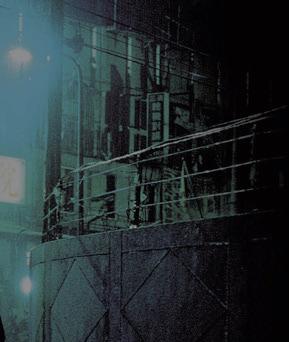





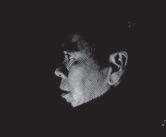

SEPTEMBER 15, 2022 - CHICAGO READER 55 2022-23 SEASON ON SALE NOW COME SYMPHONY WITH US GET $5 TICKETS WITH CODE PWYC5NEXT AT CHECKOUT MING-LIANG T S A I SISKELFILMCENTER.ORG/TSAI TSAIMING-LIANG SEPT12-OCT3 9/19: 9/26: 10/3: STRAYDOGS(2013) DAYS(2020) TsaiMing-LiangArtistLecture Find hundreds of Reader-recommended restaurants at chicagoreader.com/food
THEATER & ARTS THEATER & ARTS
FILM EVENTS
A fall full of film
Screenings, events, and festivals abound in the coming months.
By BROOKS EISENBISE
It’s almost autumn, which means it’s time to put on our sweaters, light up our pumpkin spice-scented candles, and watch Hocus Pocus on DVD for the thousandth time. Or, if you’re feeling a little more adventurous, check out what the Chicago film scene has to offer this fall. From horror movie fests and indie short films to the best in queer and international cinema, you’re guaranteed to find something new to watch this season. And with even more film event lineups—like the Black Harvest International Film Festival and the 34th Annual Polish Film Festival—yet to be announced, this fall is shaping up to be a wildly entertaining one.
The work of Tsai Ming-liang at the Gene Siskel Film Center
Through October 3
The Gene Siskel Film Center at SAIC is spotlighting the work of trailblazing Taiwan-based filmmaker Tsai Ming-liang this fall (see full story on p. 52). Known for his long shots and artistic cinematography, Tsai’s work explores social disconnect and urban alienation in a truly unique and sometimes unsettling way. Visit the Gene Siskel Film Center for screenings of his films Stray Dogs and Days . An in-person lecture and Q&A with the director himself wraps up the series on October 3. siskelfilmcenter.org/tsai
Cinema/Chicago Presents My Father Marianne
September 21
Visit Claudia Cassidy Theater at the Chicago Cultural Center to catch the tail end of Cinema/Chicago’s free summer programming. In the final event of the season, watch director Mårten Klingberg artfully translate Ester Roxberg’s 2014 autobiographical novel to the screen. My Father Marianne ( Min pappa Marianne in its original Swedish) follows twentysomething Hanna as she moves back in with her parents and learns that her father, a
respected priest, is transgender. chicagofilm festival.com/film/my-father-marianne
Reeling: The Chicago LGBTQ+ International Film Festival
September 22 to October 6
The 40th annual Chicago LGBTQ+ International Film Festival is here! This event showcases a diverse range of new queer cinema, from mainstream movies like Bros (dir. Nicholas Stoller) to unique intersectional narratives. Two Eyes (dir. Travis Fine) is a cinematic triptych exploring multiracial genderqueer identity over three generations; and Manscaping (dir. Broderick Fox), copresented by Brave Space Alliance, follows the owners of three unconventional queer barbershops who challenge what it means to be a man. With over 50 groundbreaking films, this is a can’tmiss event for LGBTQ+ cinephiles. In-person and streaming passes are available now. reelingfilmfest.org
Chicago Horror Film Festival
September 24 and 25
Get in the spirit of spooky season with the 23rd annual Chicago Horror Film Festival. Showing at Cinema Chatham, this weekend event features indie shorts and full-length films that span the breadth of the horror genre—from classic slashers and psychological thrillers to sci-fi stories and convention-breaking spoofs, there’s something for everyone. The fest also features vendors, after-hours events, free snacks, and more. chicagohorrorfest.com
Chicagoland Shorts Volume 8 September 29











Hosted by The Block Museum of Art at Northwestern, the latest collection of Full Spectrum Features’s Chicagoland Shorts explores the experience of the outsider who yearns for connection. Featured short films include Warren? (dir. Juan C. Linares), considering the
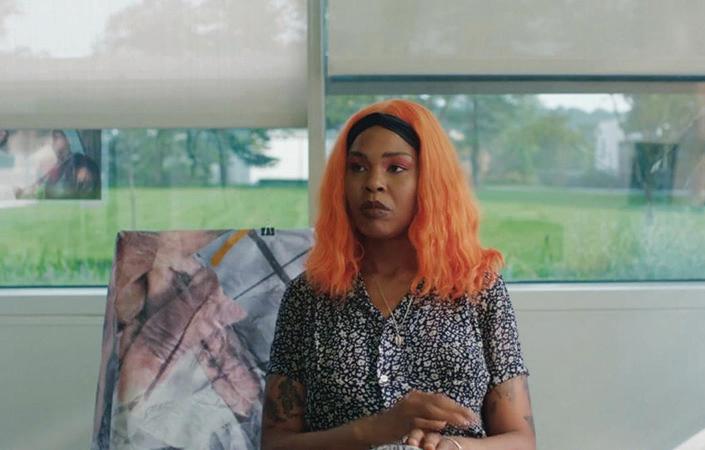


identity and experiences of a white-passing Latino; Silver Lining (dir. Yanyi Xie), a documentary about a Chicago drag artist coping with COVID-19 quarantine; and First Week Out , which chronicles a man’s first week of freedom after 42 years behind bars. This event is free and open to the public. blockmuseum. northwestern.edu


Screening of The African Desperate September 30
The Gene Siskel Film Center presents SAIC alum Martine Syms’s debut feature-length film, The African Desperate. The story follows a day in the life of Palace, a recent MFA graduate who hopes to escape microaggressive white academia by returning home to Chicago. The African Desperate promises to be a fastpaced, darkly funny, scathing exploration of white liberalism, creative spaces, and complex interpersonal relationships. siskelfilmcenter. org/african-desperate
Various Artists independent Film Festival October 7 and 8

The sixth annual Various Artists independent Film Festival (VAiFF) is a yearlong indie film competition culminating in two days full of screenings, awards, symposiums, and live music and dance. Come for genre-defining and -defying features and shorts, stay for the live jazz and for talks with guest artist Carl Jones (The Boondocks, Black Dynamite).
Virtual and in-person passes are on sale now. vaiff.com

The 58th Chicago International Film Festival October 12 to 23
Now in its 58th year, the Chicago International Film Festival showcases the best in international cinema, along with Q&As, discussions, panels, networking events for aspiring filmmakers, and more. While the full lineup has yet to be announced, early bird tickets are on sale now. This event promises to be eye-opening for moviegoers, industry professionals, and everyone in between. chicagofilmfestival. com/festival
Screening of Andy Warhol’s Batman Dracula November 3
Moviegoers who want a more artsy (read: campy and queer) horror experience this Halloween season are encouraged to visit the Gene Siskel Film Center for their screening of Andy Warhol’s ambitious and unfinished Batman Dracula . With elaborate sets and staging, intersecting storylines, and a main character who is, yes, both Batman and Dracula, this is the spooky camp classic you’ve been waiting for. siskelfilmcenter.org/ andy-warhols-batman-dracula v
56 CHICAGO READER - SEPTEMBER 15, 2022 ll
FALL
@Chicago_Reader
The African Desperate (2022) GENE SISKEL FILM CENTER


SEPTEMBER 15, 2022 - CHICAGO READER 57 Let’s Play! Make time to learn something new with music and dance classes at Old Town School! We offer flexible schedules for all skill levels both in-person and online. oldtownschool.org Sign up for classes today at MUSIC CLASSES FOR ADULTS & KIDS LINCOLN SQUARE LINCOLN PARK SOUTH LOOP & ONLINE OTS_1_2V_ClassAd_072921.indd 1 7/23/21 2:21 PM PRESENTED BY WEDNESDAYS @ 7PM July 6 - September 28 CHICAGOMAGICLOUNGE.COM TICKETS ON SALE NOW!
FILM
Find new film reviews every week at chicagoreader.com/movies
NOW PLAYING
Barbarian
Barbarian writer/director Zach Cregger takes a simple premise and spins it into a series of unexpected permutations. Some tropes work better than others, but we’ll give him credit for inventiveness.
In town for a job interview, Tess (Georgina Campbell) arrives late at night in the pouring rain to find her Airbnb occupied by a surprise guest, Keith (Bill Skarsgård). A er some tense feelings, they discover some common interests and decide to spend the evening as short-term roommates. The tension shi s from Keith’s intentions to the house itself, as bumps in the night lead to startling discoveries.
Without spoiling too much of the fun, Cregger uses several historical horror flick callbacks to decent effect and is clearly an enthusiast of the genre. Narratively, Barbarian uses the location itself as a primary character, delving deep into the dark history of the house and shi ing focus between multiple characters. There’s a grab bag of current-day societal issues ranging from #MeToo to gentrification and the decline of American cities. It’s not all trauma here, as the film drops in some truly comedic moments, de ly pacing out the scares. And while several of the scenarios stretch credulity, when Barbarian works, it achieves some entertainingly ghastly heights. —ADAM MULLINS-KHATIB R, 102 min. Wide release in theaters
RPearl
Pearl is director Ti West’s technicolor nightmare, an origin-myth prequel for his previous slasher film, X. The film focuses on the eponymously named
Pearl (Mia Goth), a young girl stuck on her family’s farm with dreams of seeing herself on the big screen. But Pearl is sick of feeling alone. Her husband le her to fight overseas in World War I, so she finds herself at her parents’ mercy. Her father (Matthew Sunderland) suffered a terrible stroke, rendering him paralyzed, and her mother (Tandi Wright) rules the farm with a cold, iron fist, squashing Pearl’s dreams and refusing to let her mingle with others because of the Spanish Flu.
This gruesome fantasy-esque film introduces Pearl among her best friends: her farm animals. Similar to Snow White, Pearl voices her dreams to her farm animals before performing a joyful dance routine. However, it becomes abundantly clear that this is no fairy tale. Interrupted by an unnamed goose, Pearl slips into a horrifyingly stern gaze, gripping the pitchfork firmly before killing the farm animal—the first instance (but definitely not the last) where Pearl’s simmering rage boils over into feverish violence. From this point onward, Pearl slowly succumbs to her brutal delirium, transfixed by her dancing aspirations.
Without Goth’s stunning performance, Pearl would likely fall into horror obscurity. Goth’s reprisal is unparalleled, personifying a terrifying angle of Hollywood escapism and fleshing out the character of Pearl depicted in the movie’s predecessor. Her impressive performance arrives at its climax during the final monologue, when Pearl divulges her murderous tale to her sisterin-law, in lieu of her absent husband. Goth’s chilling delivery is simultaneously comical and tearful, providing depth to Pearl. Together, West and Goth created an inventive, unique slasher genre, and a movie worth rewatching several times. —MAXWELL RABB R, 102 min. Wide release in theaters
RThe Silent Twins
June and Jennifer Gibbons from a young age famously took a vow of semi-silence, speaking only to one another. The twins—who were ostracized in their Welsh community due to race (their family had emigrated from Barbados, and they were the only Black family in the area)—found refuge in an outré fantasy world, writing stories and plays that came to life via a bevy of handmade figures. The vastness of their combined imaginations is what Polish filmmaker Agnieszka Smoczyńska (The Lure) captures best in this film about their unusual lives, based on the eponymous book by Marjorie Wallace, a journalist who took an interest in the womens’ stories when they were in their 20s. The film, written by Andrea Seigel, charts their childhood, during which psychologists raised concerns about their behavior; their unruly teenage years, when they rebelled in an attempt to add substance to their lives, about which they hoped to write; and finally their 11-year institutionalization a er an incident of arson. Black Panther’s Letitia Wright and Tamara Lawrance portray June and Jennifer, respectively, as teenagers and adults; their performances are incredible, bolstered by the insane sequences translating the folly of the sisters’ profound maladaptive daydreaming wherein bizarre puppets à la the Brothers Quay are animated in a stop-motion fashion to bewitching effect. These parts, as well as several original songs written for the film, derive from the twins’ writing. Smoczyńska’s idiosyncratic vision distinguishes what otherwise might have been an overly literal telling of their story, and of their own stories; her dedication to their cra honors their unique circumstances. —KATHLEEN SACHS R, 113 min. Wide release in theaters
See How They Run
A boorish American film producer (Adrien Brody) visits a London theater in the midst of a record-breaking soldout run of Agatha Christie’s The Mousetrap with the idea of turning the hit play into a movie, offends and outrages everyone he comes into contact with, and is, quite justifiably, murdered. Instead of letting sleeping dogs lie, an alcoholic veteran detective (Sam Rockwell) and chipper rookie policewoman (Saoirse Ronan) stumble through what is intended to be a rollicking, blunder-filled investi-
gation to unmask the killer.
As someone who’s had the misfortune of sitting through a production of Christie’s venerable whodunit, the idea of staging a comic murder-mystery in, around, and atop that play is truly inexplicable. I have no idea how an A-list cast like this was hoodwinked into participating in this wink-wink nudge-nudge snooze fest. Staying home and playing a rousing game of Clue with a warm cup of cocoa would’ve been higher stakes for all concerned. This is some very weak tea indeed. —DMITRY SAMAROV PG-13, 98 min. Wide release in theaters
R The Woman King
Viola Davis has ascended to the next level of her cra in the exquisitely cra ed historical action-epic The Woman King, which delivers what the Wonder Woman franchise should have—bloody Amazons kicking men’s asses without airbrushing. Based on the real-life African kingdom of Dahomey and its all-female warrior regiment (which inspired Black Panther’s Dora Milaje), an awesomely shredded Davis plays General Nanisca, a warrior who immediately recognizes the danger and scope of the growing transatlantic slave trade. Nanisca struggles to convince King Ghezo (a wonderfully cast John Boyega) to act before it’s too late.

Thuso Mbedu plays a spirited Nawi, a young recruit that struggles under the discipline and sacrifice that the life of a true fighter requires. Luckily for her, she finds a kindly big sister in the fearless Izogie, played by Lashana Lynch (MI6 in No Time to Die). As Nanisca’s tough facade begins to crack, she leans on her spiritual advisor and confidant Amenza, played by Sheila Atim, who channels both the immaculate bone structure and acting chops of the late Cicely Tyson.
Director Gina Prince-Bythewood (Love & Basketball) films through the lens of Blackness, highlighting the beauty, strength, and fierceness of Black people, unlike most stories about the slave trade that wallow in Black trauma and are filmed as education for white audiences. A well-cra ed script (story by Maria Bello and Dana Stevens) delivers action, heart, and great storytelling set against the expansive vistas of the West African countryside, making The Woman King an instant classic. —SHERI FLANDERS PG-13, 135 min. Wide release in theaters v
58 CHICAGO READER - SEPTEMBER 15, 2022 ll
The Woman King SONY PICTURES
R READER RECOMMENDED b ALL AGES N NEW F
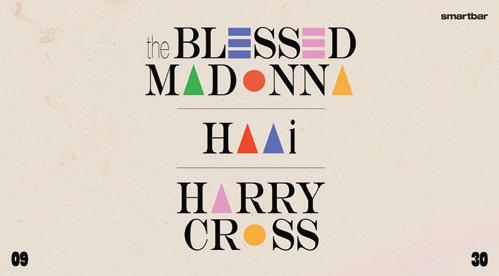









SEPTEMBER 15, 2022 - CHICAGO READER 59 3730 N CLARK ST METROCHICAGO.COM @METROCHICAGO SMARTBARCHICAGO.COM 3730 N CLARK ST | 21+ SATURDAY SEP 17 BONOBO (DJ SET) GARRETT DAVID MICHAEL SERAFINI FRIDAY SEP 16 SPECIAL REQUEST JUSTIN AULIS LONG b2b SEVRON LORELEI THURSDAY SEP 22 Cold Waves X ft. PLACK BLAGUE HARU NEMURI CALEXICO KMFDM TOADIES TINARIWEN GIRLS AGAINST BOYS OCT 04 OCT 07 OCT 08 OCT 09 OCT 11 OCT 12 TUE OCT 04 HARU NEMURI + Frost Children FRI SEP 23 COLD WAVES X FT. COLD CAVE + Kite / Empathy Test Spike Hellis / Ghostfeeder Rare DM WED SEP 28 NOVO AMOR Laid Back | Cold Beer | Live Music @GMANTAVERN GMANTAVERN.COM 3740 N CLARK ST 21+ TUE SEP 27 TRENTEM Ø LLER + TOM & His Computer THE AFGHAN WHIGS THURSDAY SEP 22 / 7PM / 18+ COLD WAVES X FEATURING TR/ST + The KVB / Actors / Kontravoid Leathers / New Canyons MONDAY SEP 19 / 8PM / 18+ METRO + RIOT FEST WELCOME A METRO 40TH ANNIVERSARY CELEBRATION YEAH YEAH YEAHS TUESDAY SEP 20 / 8PM / 18+ Q101 PRESENTS A METRO 40TH ANNIVERSARY CELEBRATION THE SMASHING PUMPKINS SATURDAY SEP 24 / 7PM / 18+ COLD WAVES X FEATURING THE REVOLTING CORPSE + Stromkern / REIN / HAEX Cyanotic / Haloblack SATURDAY OCT 01 / 10:30PM / 18+ LATE SHOW ADDED DUE TO DEMAND! THE AVALANCHES HANDEL’S JEPHTHA Handel’s rarely performed nal masterpiece BAROQUE HEROES Colorful, lively Baroque works for orchestra REGINAL D MOBLEY SINGS One of the world’s greatest countertenors SEP 18/19 OCT 9/11 NOV 20/21 SUBSCRIPTIONS START AT $60 baroque.org 312.551.1414 2022–23 SEASON DAME JANE GLOVER, MUSIC DIRECTOR
MUSIC






READING HOUSE’S HISTORY from its used records
Vinyl owned by DJs in the 80s and 90s is still circulating in Chicago shops, and it offers a unique window into the ways house music came alive.
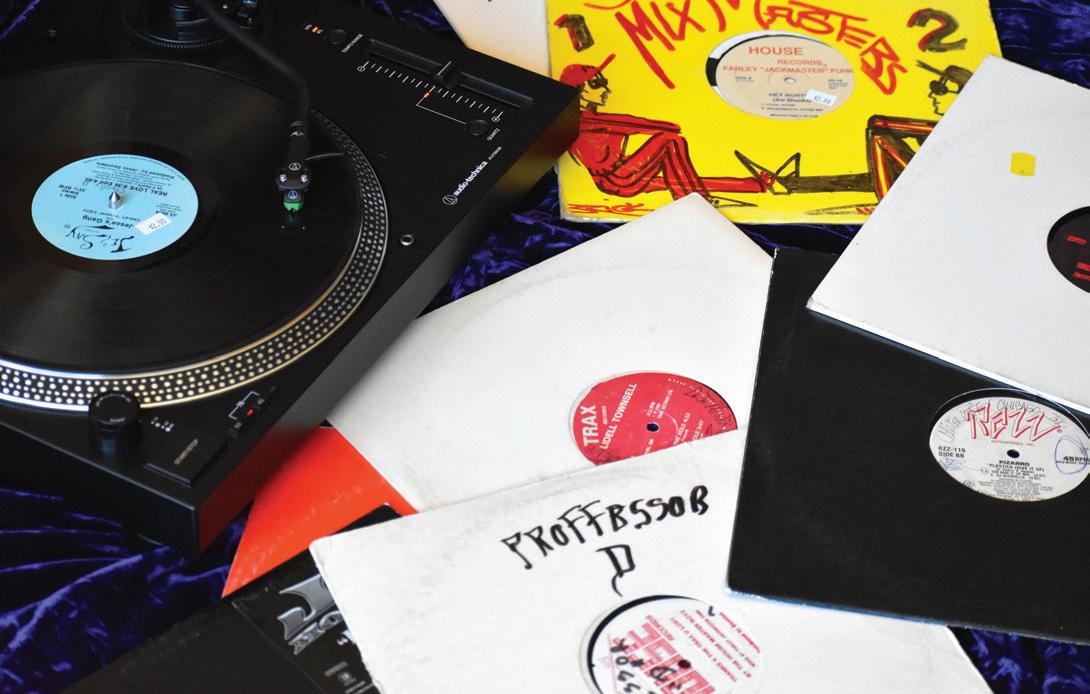 By LEOR GALIL
By LEOR GALIL
Chicagoans don’t need an excuse to talk about house music, but when the biggest pop star in the world drops a record indebted to house, you can expect more than just a conversation. Beyoncé’s Renaissance has e ectively evangelized for this Chicago-born sound since the album came out in July, not least because she shaped it with help from major players in the genre’s history. Pop critic,
dance-music historian, and Reader contributor Michaelangelo Matos has noted in the New York Times that Renaissance track “Cozy” obliquely references Adonis’s 1986 Trax Records heater “No Way Back” with its sly bass line, and it also includes contributions from two Chicago natives who built careers during later waves of house: Honey Dijon and Curtis Alan Jones (aka Green Velvet, a Cajmere).
“Cozy” got me thinking about the old house records I own—the ones from the early days of Chicago house, when the local scene was still putting down roots. When you buy house records in the city that birthed house, you’re often shopping in stores where the sta and customers include people who still shape that scene.
Lakeview institution Gramaphone, for example, is owned by Michael Serafini—one of the resident DJs for Smart Bar’s queer house and disco weekly, Queen!, which celebrates its 40th anniversary with a blowout at Ravinia on Saturday, September 17. For decades, Gramaphone has been a destination for house heads from around the world. In the foreword for the graphic novel The Song of the Machine, Daft Punk’s Thomas Bangalter and Guy-Manuel de Homem-Christo write about meeting Chicago ghetto-house producers DJ Deeon and DJ Milton in an alley behind Gramaphone in 1996—a year before Daft Punk released their debut album, Homework , whose track “Teachers” shouts out Deeon and Milton.
Digging through the stacks at Chicago

shops, I’ve found records from Deeon and Milton, along with other vinyl released by Dance Mania, the label whose reputation those DJs helped boost onto the international stage. Original pressings of old Dance Mania 12- inches can sell for hundreds of dollars through Discogs, but I’ve picked up used copies without even needing to raid my grocery budget—if you’re willing to settle for a record that’s too beat up for collectors to care about, you can score some great deals. Several of the 12-inches I’ve bought were previously owned by local producers and DJs, which I know because they wrote their names on the hub labels.
The wear and tear on these dance DJs’ records—a colored circle sticker on one side, an entire hub label blacked out in Sharpie— devalues them on the resale market. But I like knowing that their previous owners cared about them enough to put a mark on them. These records were made to be played, and played for other people—and I love the idea that some of the vinyl I own could’ve been used in a local DJ’s set during the halcyon days of house, when neighborhood parties at churches and recreation centers were an integral part of the culture citywide.
This practice didn’t start with house music, of course. DJs were marking up records long before Frankie Knuckles made the Warehouse a hub for Black gay nightlife in the late 1970s.
In the late 50s, Clement “Coxsone” Dodd held the upper hand for years in Kingston’s pre-reggae sound clashes with help from a defaced copy of “Later for the Gator,” a smoldering 1950 R&B single by Florida saxophonist
60 CHICAGO READER - SEPTEMBER 15, 2022 ll
The markings that house DJs le on their records provide hints about when, where, and by whom they were played. KIRK WILLIAMSON FOR CHICAGO READER
Well-used copies of DJ Milton’s 1995 EP Trax-4-Daze, the 1987 single “G.T.B.” by Pierre’s Pfantasy Club, and Julian “Jumpin” Perez’s 1987 12-inch “Jack Me Till I Scream”
Willis Jackson that became his number one selection. According to Lloyd Bradley’s book Bass Culture: When Reggae Was King , Dodd removed all trace of the song’s title and origin from its label, instead calling it “Coxsone Hop,” which gave him a monopoly on the popular tune—till someone in Coxsone’s camp spilled the beans to his archrival, Duke Reid, who tracked down his own copy.
In the 1970s, DJs in New York City shaped the sound of hip-hop by messing around with their favorite bits on the records they owned. Grandmaster Flash developed a method of writing directly on the grooves of a record that allowed him to find the break he wanted in no time at all. “I would mark the record with a grease pencil or a crayon, where the break lived, and all the intersecting points,” he told Vulture in 2014. “So when I wanted to repeat a break all I had to do is just watch how many times the intersecting line passed the tone arm.”
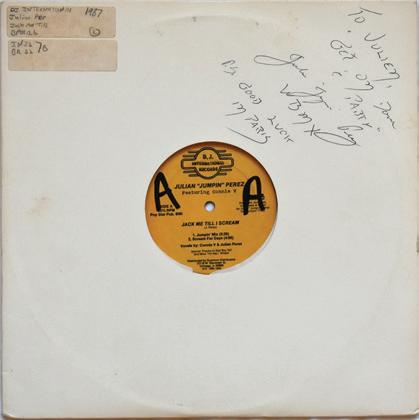
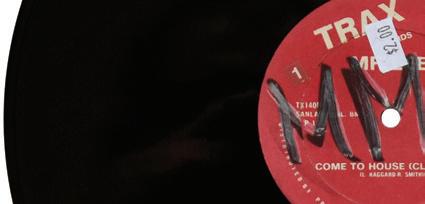
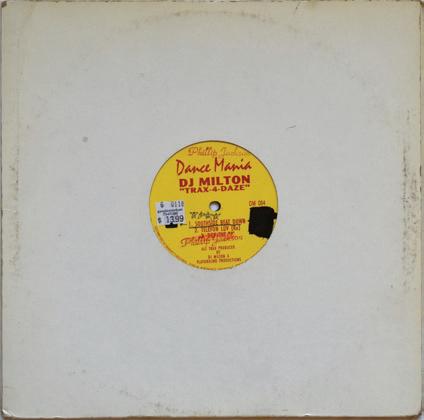



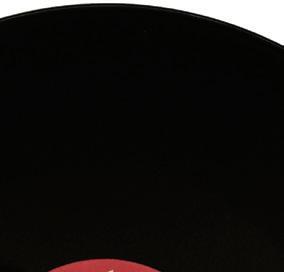
House DJs didn’t tend to build songs out of looped breaks, though—they’ve always been more likely to play a track through. None of the 12-inch house singles I’ve bought has marks on its grooves, just on its labels or sleeve. The 12-inch was de rigueur in dance by the time house music began being released on vinyl in 1984, and modest independent labels such as Trax and DJ International rode the homemade sound to outsize success. In May 1976, Salsoul had released the first commercial “giant single,” Double Exposure’s “Ten Per Cent,” which gave a single song nearly ten minutes to unwind across an entire side
of an LP-size record. This format suited house music just fine, and it also allowed everyday record buyers easy access to versions of songs typically only heard in nightclubs.
Of the house records I’ve found that were marked up by DJs, most simply bear the names of their previous owners, though decoding them can be tricky. In 2008, in a 5 magazine oral-history project dedicated to producer and DJ Armando Gallop, house pioneer Farley “Jackmaster” Funk described one way such markings can be deceptive. He’d left some of his old vinyl in Gallop’s basement, and Gallop added his own stamp. “He’d color ’em up and tell me they’re not mine!” Funk said. “‘Look at this little spot right there—that’s
my record! What are you doin’?’ . . . He didn’t have records from way
I didn’t mind though.”
The marginalia on the used dance vinyl in my collection are frequently at least that hard to interpret. Did my copy of the sultry 1987 single “G.T.B.” by Pierre’s Pfantasy Club previously belong to Chosen Few member Mike Dunn, or did someone else Sharpie the name “DUNN” in capital letters on the record’s B side? Who was the person named Julien who got Julian “Jumpin” Perez of the Hot Mix 5 (who’s currently running for 26th Ward alderperson) to sign the sleeve of a copy of Perez’s 1987 single “Jack Me Till I Scream”? Why did Phillip Jackson—or the person who rubberstamped Jackson’s name on a copy of DJ Milton’s 1995 EP Trax-4-Daze underline the title of the bubbly, bassforward cut “Southside Beat
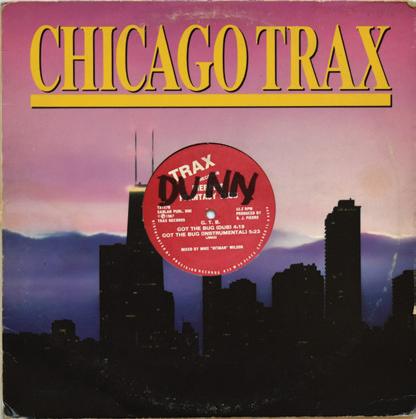
Down” and draw four stars above it?
Some of the names scrawled on these 12-inches, such as “DJ Chris,” are so common that an online search brings up a uselessly huge pool of results. In other cases, I can’t tell what the letters on a hub label are supposed to mean; if you wrote “M M M” on a copy of Mr Lee’s poppy 1987 Trax single “Come to House,” please get in touch.
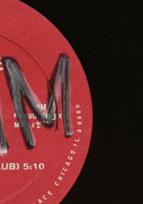
I did figure out which DJs had owned at least some of my used records, or I think I did. Unfortunately, almost none of them responded when I reached out. Aurora-based DJ Tito “Latino” actually replied—I’d asked him about a few records marked “DJ Mister Tito”—but he just told me I had the wrong guy. Tito “Latino” had previously spun under a di erent name, but it was “Tito Jumpin Jimenez.”
During my search I swung by Signal Records, the shop that Blake Karlson (former label head of Chicago Research) opened in Avondale this summer. I found a cache of used 12-inches with marked-up hub labels in the shop’s two-dollar bins, and eventually tracked down a DJ who’d previously owned a few of them: Jerry Lange Jr., aka Jackmaster Jay of the Chicago Cutting Crew.
In the mid-80s, Lange found his way to DJing through breaking. “I tried that and I sucked,” he says. “I saw that movie Beat Street in ’84, and they had everything in
Mr Lee’s poppy 1987 Trax single “Come to House,” mysteriously marked “M M M”
SEPTEMBER 15, 2022 - CHICAGO READER 61
KIRK WILLIAMSON FOR CHICAGO READER
MUSIC
READER J back then! But
KIRK WILLIAMSON FOR CHICAGO
continued from 61
it. I’m like, ‘Oh, let me try the DJ part of it.’” House music had already spread beyond nightclubs by that point, in part because the Hot Mix 5 had debuted on WBMX in 1981. Lange got familiar with the crew through the daily Hot Lunch show, and he found other kids in his neighborhood interested in dance music. When he started buying records, he originally sought out Italo disco. “The Italo records were more expensive, because they’re imported,” Lange says. “The Chicago ones, you could get for four bucks a copy, so I started buying more of that stu .”
Lange was a teen who couldn’t drive and didn’t have much cash, but he still had recordshopping options in the 1980s. He grew up near a flea market on Cicero and Division where he found vinyl, and he took public transit to more conventional stores such as Disco City in Logan Square and Importes, Etc. in Printer’s Row, which was partly responsible for giving house music its name.
Lange had a turntable at home, and he found a couple friends who could supply the other necessary equipment to properly DJ a party—a mixer and a second turntable. He began building a reputation by spinning neighborhood house parties, and in 1987 he joined the Chicago Cutting Crew. The following year he won first place in a mobile DJ competition as part of the tenth annual Great Battle of the DJs at Navy Pier. “Right around that time frame, around 1988, I was doing parties all the time,” he says. On Facebook a friend of his has posted a scan of a flyer from
a February 1989 blowout at the A.C. Club that also featured the Hot Mix 5’s Ralphi Rosario and Mickey Oliver.
I have three of Jackmaster Jay’s old records, all from that critical era in his DJ career. K Joy’s “My Phone” came out in 1986, and Denise Motto’s “Tell Jack (Jack the House)” and Fast Eddie’s collaboration with Tyree and Chic, “The Whop,” both landed in 1987.
“Just having a new track meant a lot to me at the time,” Lange says. He frequently spun sets with other DJs, so he wrote his name on his records for strictly practical reasons.

“You don’t want no one stealing your copy,” he says. “Most of the times, when we had a partner, each had one copy of the same record, and some guys were not taking care of their records, so they just throw them around— whereas I marked mine, I took care of mine.”
He’d mark his preferred side with a big “A,” then put a “B” on the flip side—which is why the A side of “The Whop” has two “Bs” in Sharpie.
Lange stopped DJing regularly in 1992. “I was getting older,” he says. “My parents were like, ‘Are you gonna stick with this as a profession, or are you gonna start working?’ I didn’t see myself going further with the DJ thing at that moment.” He’s kept collecting records, though, sometimes replacing 12-inches he already owns with better copies and selling or donating his originals. “Any records I buy now, I don’t mark them,” he says. “Because they’re staying at my house.” v
One of several records in the author’s collection marked with “DJ Mister Tito” or “DJ Tito” or some similar variation: the 1990 12-inch “Dance to the Drummer’s Beat” by CZR
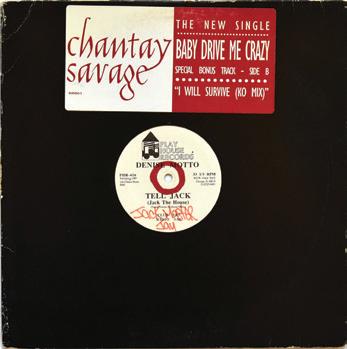
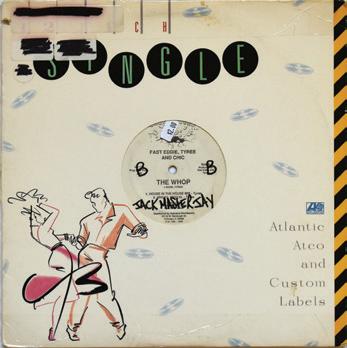
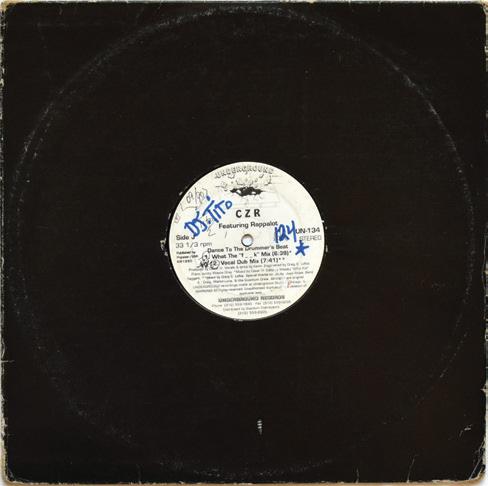
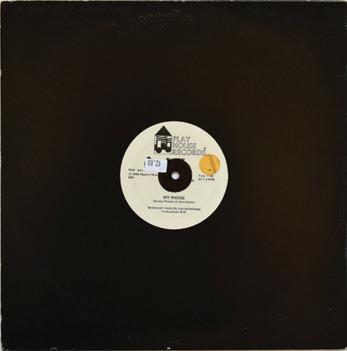
62 CHICAGO READER - SEPTEMBER 15, 2022 ll MUSIC 9/21 Heart of Afghanistan and Qais Essar 9/28 Luca Ciarla solOrkestra WORLD MUSIC WEDNESDAY SERIES FREE WEEKLY CONCERTS, LINCOLN SQUARE OLDTOWNSCHOOL.ORG 4544 N LINCOLN AVENUE, CHICAGO IL OLDTOWNSCHOOL.ORG • 773.728.6000 SATURDAY, SEPTEMBER 17 8PM Big Bad Voodoo Daddy In Maurer Hall SATURDAY, SEPTEMBER 17 10AM Family Concert Groove Time feat. Mars Caulton In Szold Hall SUNDAY, SEPTEMBER 18 3 & 7PM Jake Shimabukuro In Maurer Hall FRIDAY, SEPTEMBER 23 8PM Joe Purdy In Maurer Hall SATURDAY, SEPTEMBER 24 8PM SUNDAY, SEPTEMBER 25 7PM Watkins Family Hour In Maurer Hall SUNDAY, OCTOBER 2 7PM Mississippi River Suite written & directed by Michael J. Miles featuring Zahra Glenda Baker with Lloyd Brodnax King & Jill Kaeding • In Maurer Hall FRIDAY, OCTOBER 7 8PM Dar Williams All Request Show • In Maurer Hall FRIDAY, OCTOBER 7 8PM Trace Bundy In Szold Hall SATURDAY, OCTOBER 8 11AM Family Concert The Okee Dokee Brothers In Maurer Hall SATURDAY, OCTOBER 8 7:30PM David Wilcox with special guest Jean Rohe • In Szold Hall UPCOMING CONCERTS AT NEW SHOWS ANNOUNCED • ON SALE NOW 11/19 Erwin Helfer, Spain's Lluis Coloma & Chicago Gospel • A Blues, Boogie and Gospel Keyboard Party 12/4 Over the Rhine 12/9 Deb Talan (of The Weepies)
@imLeor
Three of Jackmaster Jay’s old records: K Joy’s “My Phone” from 1986; Fast Eddie’s collaboration with Tyree and Chic, “The Whop,” from 1987; and Denise Motto’s “Tell Jack (Jack the House),” also from 1987 KIRK WILLIAMSON FOR CHICAGO READER
featuring Rappalot KIRK WILLIAMSON FOR CHICAGO READER







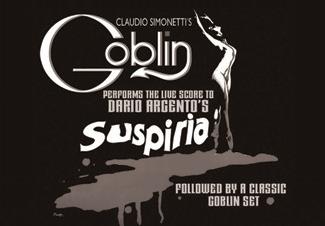
SEPTEMBER 15, 2022 - CHICAGO READER 63 SERPENTWITHFEET DEACONS TOUR APOLLO MIGHTY CLAUDIO SIMONETTI’S GOBLIN PERFORMS THE LIVE SCORE TO SUSPIRIA 9~26 MON SIX60 ST CASTLE TOUR 9~28 WED HOLLOW COVES OCIE ELLIOT 9~29 JAMESTOWN REVIVAL ROBERT ELLIS 9~30 FRI LA DISPUTE SWEETPILL ~ PICTORIA VARK 10~2 SUN OLD 97’S VANDOLIERS 10~4 10~5 VIOLENT FEMMES LAS CAFETERAS 10~13 THU THE COMET IS COMING 10~3 TORTOISE DEAD RIDER 10~11 TUE MOLLY NILSSON 10~12 BLACK MIDI QUELLE CHRIS 10~16 SUN RARE AMERICANS DYLYN 10~19 WED SOFTKILL FRENCH POLICE ~ MS PAINT ~ GEL 10~21 FRI VOXTROT YELLOW OSTRICH 10~23 SUN THE LONE BELOW LOVE SONGS FOR LOSERS TOUR 10~24 MON MADISON CUNNINGHAM BENDIGO FLETCHER 11~8 TUE BARTEES STRANGE POM POM SQUAD ~ THEY HATE CHANGE 11~2 11~3 ALEX G HATCHIE 11~11 FRI TY SEGALL SOLO ACOUSTIC ~ EMMETT KELLY 11~12 SAT DRUGDEALER REVEREND BARON 11~15 TUE THE MURLOCS PAUL JACOBS 11~16 WED PROTOMARTYR 10~26 WED JOEP BEVING 10~27 THU THE CALIFORNIA HONEY DROPS CHRIS JACOBS 10~29 SAT ILLUMINATI HOTIES ENUMCLAW ~ GUPPY 10~30 SUN ROCK & ROLL PLAYHOUSE PLAYS THE MUSIC OF PHISH FOR KIDS 10~22 NAPALM DEATH 10~25 10~28 BRUJERIA FROZEN SOUL MILLIONS OF DEAD COPS LOW TIX LOW TIX LOW TIX LOW TIX LOW TIX THALIA HALL | 1807 S. ALLPORT ST. PILSEN, USA | THALIAHALLCHICAGO.COM
Blue water road to Chicago
By DEBBIE-MARIE BROWN
The line to enter the Aragon Ballroom wrapped around the sidewalk and into the middle of a nearby alley where fans were dressed in their Friday night best: wigs laid, braids done, eyeliner winged, dreadlocks retwisted. Guys with handmade signs were stationed across from the dumpsters selling Modelos and edibles, while the crowd waited to join the thousands already inside.
On August 26, the young, visibly queer procession of ticketholders shuffled into the 100-year-old building and were greeted by extravagent balconies, chandeliers, and


arches reminiscent of Game of Thrones. After Destin Conrad, Rico Nasty, and DJ Noodles fi nished an hour and a half of hype opening sets, everyone in the audience held their phone cameras to the empty stage, where a short video appeared of Kehlani, in a camper on a road trip, talking to her daughter Adeya while she writes a song.
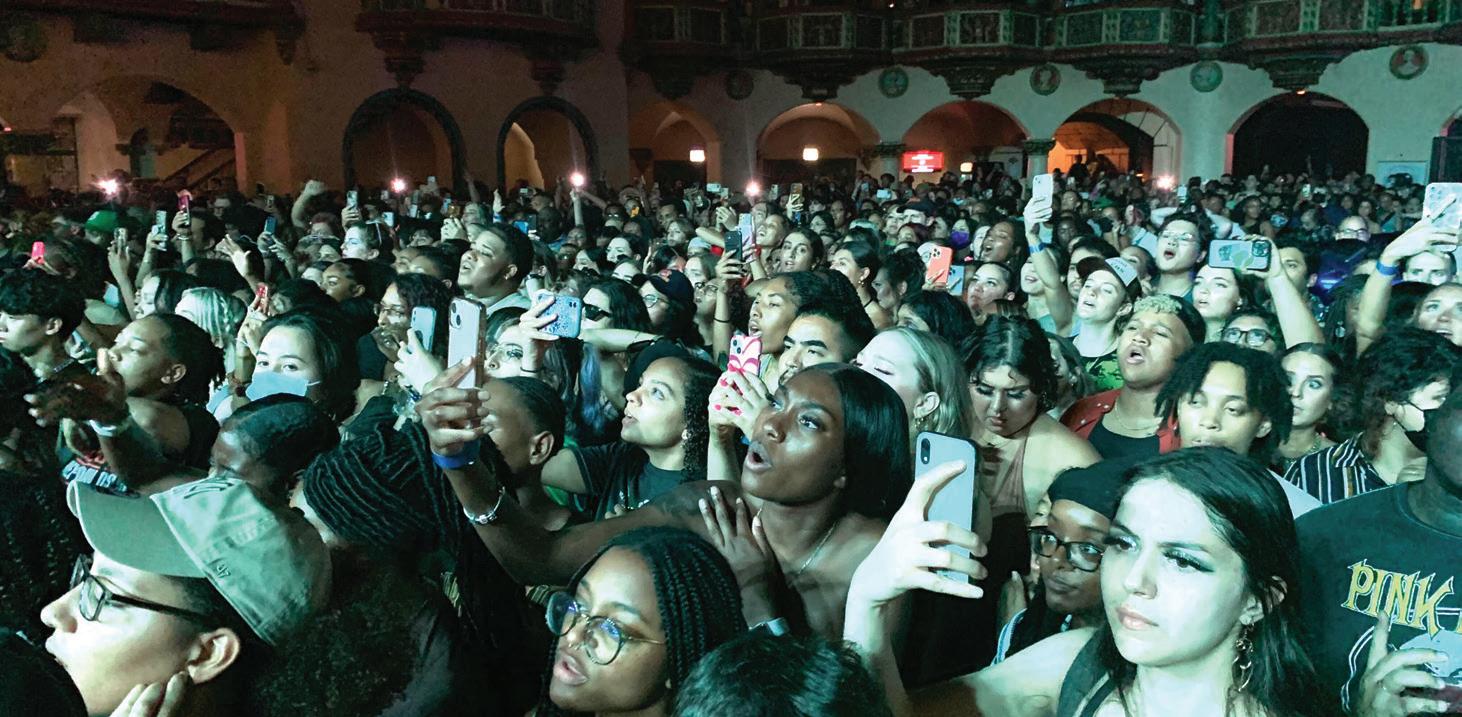

The video cut o , and four dancers, dressed in black and moving like water, materialized on stage before the singer. Bright blue lights beamed through the concert fog and revealed Kehlani center stage. She was tatted and wearing a blue knitted outfit, her curly black

64 CHICAGO READER - SEPTEMBER 15, 2022 ll
MUSIC
Fans at Kehlani’s Aragon Ballroom show (above) Blue Water Road (inset) album tour
PHOTO BY DEBBIE-MARIE BROWN; ALBUM COVER COURTESY ATLANTIC REACORDS
Kehlani’s fans discuss the queer R&B artist’s music and impact.
hair down to her waist. Her band—composed of a guitarist, synth/keyboardist, and drummer—walked to their instruments. The performance began.
Kehlani, who uses she/they pronouns, is a queer, prolific, multitalented muse; it’s no wonder her Chicago audience seemed so specific. Blue Water Road is their third studio album, not counting three additional mixtapes and dozens of singles released, and is considered their most mature, settled, and queer release. When the Oakland singer visited Reckless Records in Chicago for an album signing tour earlier this May, the artist attracted a crowd that had the same soft and edgy energy her music is imbued with.
As the concert ended and fans scurried to the exits, the energy was buzzing—the crowd inebriated from the experience. Two fans, Candid and Ari, were in line for merchandise. Candid called Kehlani her “baby mama” and complimented her “baby mama’s” live singing. “The mike was on. The mike was on! The mike was on.”
“I was expecting it and I got it,” Ari said. “She hit that shit. And as my sister said, the mike was on.”
Outside, a group of friends sat in a circle on the curb.
“It was fucking amazing, Kehlani is fucking beautiful,” one said. “Such a well put together show. I think I ascended into heaven, honestly.”
“She’s completely changed the game,” said another who introduced themself as Ace. “Her own game. She’s evolved. She’s a woman, she’s a mother, she’s amazing. She did the fuck out of this show.”
“She’s a true performer, she’s just so e ortless with her art, she’s an honest, true inspiration,” another friend chimed in, who introduced themself as “someone trying to come up in the R&B music industry.” “Being in her presence right now, I shed literal tears.”
A queer couple told me how “Melt,” Kehlani’s favorite love song off their recent album, was also their favorite to hear together. “She’s just a really unique performer,” one of them said. “And I think she really gives her all whenever she goes on tour.”
Bundled up on the Pratt Street Beach under the Sunday moonlight a week before the show, Freddy Maurico, my best friend from college, and I grabbed our sandy red Solo cups filled with Barefoot wine. As we were bitten by sand flies, songs that spanned Kehlani’s discography played from his speak-
er. The dark bass of “RPG” o her album While We Wait quickly enveloped us both, and Freddy told me about the first time he saw her in concert.
“Oh my god, like, I was so captivated,” he said. It was 2016 and we were freshmen. Our college hosted an undergraduate show and Kehlani was the opening act. They only had two backup dancers and a chair, and he was amazed by her singing, dancing, and rapping. “Like it was all introduced to me like in this one performance. That was like my fi rst interaction with someone that could do all of that.” We both were loyal fans within a year. But Freddy’s obsession peaked much before mine, and it was through him that I fell for the artist myself.
In high school, mid-20s pop artists like Marina and the Diamonds, Demi Lovato, Ellie Goulding, and Ariana Grande were on the marquee for Freddy. He would also soon discover the slow and sexy sound singers like Kali Uchis and Frank Ocean made. “I think that’s how Kehlani started to fit in,” the 24-year-old said.
Kehlani’s music “[has] that R&B pop sound” that’s euphoric, he said. Freddy likes the rap-singing Kehlani incorporates, which he saw first expressed by Beyoncé in Destiny’s Child. “So it’s like, uhhhh I’m lost in the music. But it’s also hard and sexy at the same time.”
Freddy explained that while he adores Ariana Grande, her music comes o as a bit manufactured because she has several cowriters and less creative control. Kehlani cowrote most of the songs on Blue Water Road Another Kehlani fan told me they felt Ariana Grande is a “pop princess” who “writes for radio,” and that can be limiting.
“But with Kehlani I was like, oh, like she’s all of it,” Freddy said. “That’s all her life, all her coming from her body, her soul, her passion.”
Kehlani was the first and only openly queer R&B artist he listened too. Their music pushed him to self-discovery. “Kehlani’s music kinda opened my eyes,” he said. “‘Like, I am so sexy but also so vulnerable.” Freddy laughed. “It’s OK to be both.’”
One of Freddy’s favorite tracks is “Everything Is Yours” off of 2017’s SweetSexySavage :
Up at a time when I shouldn’t be / Thinking ‘bout things that I shouldn’t be / Sad about shit I’ve been sad about for the past year / I’ve been low, I’ve been down and out it . . . I would give it all to make it all work (Oh, oh) / I wish I
could say that you knew my worth.
“That’s an example, I think, of depending so much on a person and loving a person so fully,” Freddy said. “And like, hyperfi xating on what they think of me and just giving my all and expecting it all from like this one person,” with an urgency, outward preoccupation, and abandonment of self that doesn’t make it into the most recent project.
On the beach that night, we could hear the waves of Lake Michigan crashing, but we could hardly see them. I turned on “Get Me Started (feat. Syd),” Freddy’s favorite song o of Blue Water Road
A smooth upward moving bass grooved repetitively under the singer’s soft vocals and a hard beat: “I guess, choose peace over stress (oh) / Can’t clean up your mess / You wanna leave? Be my guest / Pushin’ my buttons, you gon’ get me started / Call me aggressive, I’m just being honest.”
“You know in the lyrical content, they’re not even engaging with this person’s attitude and pettiness,” Freddy said. “That’s why it’s so much more grounded and mature. All the songs are in this mindset throughout the album. I was like, wow, that is growth. And this throwback R&B just makes me dance.”
On the Wednesday evening two days before the show, I sat with Toni Akunebu at Foster Beach, as dozens slowly reentered

the water after the lifeguard on duty went home for the day. The 25-year-old said they preferred music which they could cook to, smoke to, or fuck to. Kehlani provides all three.
As we dug our feet into the sand and caught the last hour of daylight as the sun escaped below Lake Michigan, Toni talked to me about Blue Water Road and how Kehlani puts “love and tenderness” into what they do, from music videos to clothing and choreography. “It always feels like something new, and it always feels like something that just hasn’t been done before,” Toni said. Kehlani’s self-direction shines through what Toni describes as an eclectic discography.
“I feel like there’s a little bit for everyone, like, there’s a lot of R&B, there’s a lot of soul. There’s a lot of mixing . . . freeform poetry; it feels like little love notes just being given to you.” Toni also identifies deep spirituality through the artist’s work, and said embodiment is the best description they can give for the catalog, and that themes like self-awareness and “yearning for connection” appear on albums.
“There’s a lot of the songs where I’m shaking my ass,” Toni said. “There’s other ones where I’m just like, ‘OK, I just have to sit, be here in this moment and just really be present.’ And so I feel like a lot of their music is really about honoring those moments with
SEPTEMBER 15, 2022 - CHICAGO READER 65
MUSIC
Kehlani’s music “feels like little love notes,” says Toni Akunebu. DEBBIE-MARIE BROWN
MUSIC








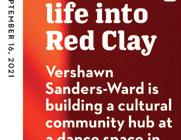



continued from 65







yourself, those parts of yourselves at di erent times.”
Toni appreciates how they’re able to witness how life experiences change an artist, and those changes are reflected in the artist’s music. Toni said they learned about the singer’s queerness even earlier in 2018, after Hayley Kiyoko and Kehlani collbaorated as best friends turned lovers in a music video, kissing in what Toni described as “the kiss heard around the world.” Last year, Kehlani went on Instagram Live and responded to a fan’s request for life updates with, “You wanna know what’s new about me? I fi nally know I’m a lesbian!”

Earlier this year the singer released a music video fi lmed in a cottage in São Paulo, Brazil, featuring tender, romantic moments with her real-life lover, rapper 070 Shake.





Kehlani had primarily dated cis men in the public eye, so they received a lot of media scrutiny for renouncing men in 2021, even though they were releasing songs like “Honey” years earlier (“I like my girls just like I like my honey, sweet / A little selfi sh / I like my women like I like my money, green / A little jealous ”). Blue Water Road distinguishes itself by exploring the mature, queer relationship that Kehlani yearns for in earlier projects.
“There really just isn’t a lot of queer folks, especially like, gender-fluid, gender-nonconforming folks, just like in mainstream media at the same caliber,” Toni said.
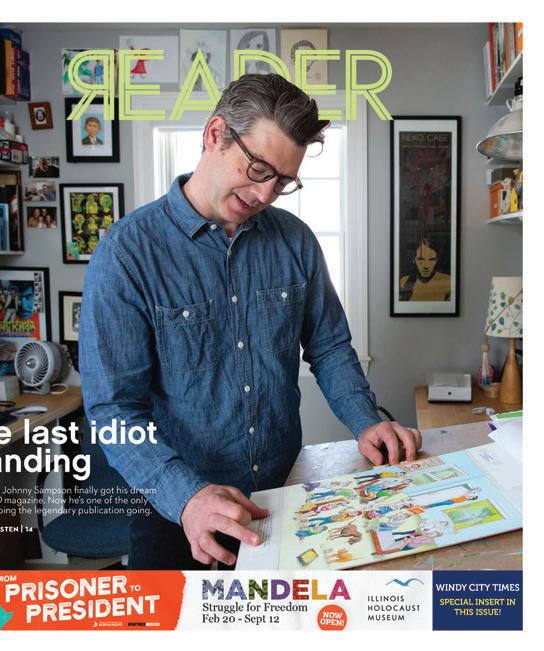






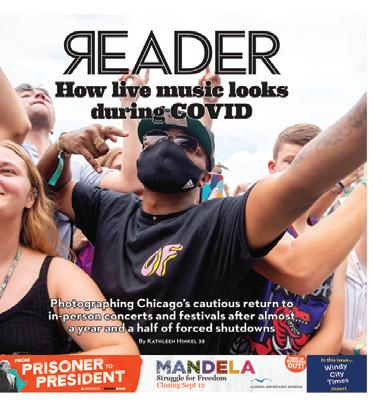

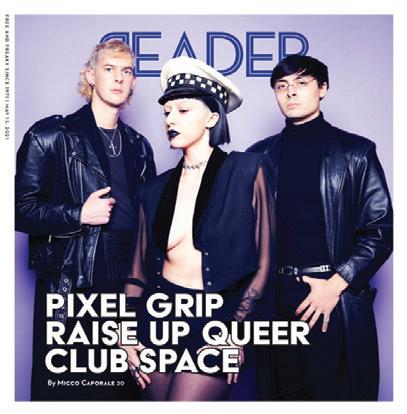
Ihad a video call with Imani Wilson six hours before the show. She’ll tell me later that “it was one of the best nights I’ve had in a while. I wish I could go see it again.”
The 24-year-old has “24/7” tattooed above her knee, an ode to Kehlani’s 2016 single in which the rapper describes their struggle with depression. “It’s OK to not be OK / To dive in your pain / And it’s alright to not be alright / To search for your light.”
Wilson said that what makes Kehlani unique, especially as a queer artist, is their insistence on being authentic and honest in their music—which mostly concerns romance and love—even when those relationships might end in the public eye.
In 2020, for example, five days after releasing a joint Valentine’s Day single with their former lover YG, the rapper released a song on streaming called “Valentine’s Day (Shameful)” that croons of sudden heartbreak: “Torn between crying for help / And
not letting them see me sweat / I took a risk loving loudly / Defended you proudly.”
A few months later on It Was Good Until It Wasn’t, Kehlani dropped “Belong to the Streets Skit,” where young voice actors are discussing the singer’s romantic life callously, saying, “Always got a different nigga though, bruh, like, we get it (yeah).” Kehlani seemingly explains herself and her tenacity to love out loud in the starting bars of “Everybody Business”: “I ain’t never been a half-ass lover / Rather lay out on the train tracks for ya / Hit the pavement for ya / Make a statement.” Wilson said she admires how Kehlani can address past ways of being and say, “Yeah, this was who I was at one point,” but also acknowledge that people change. And as an artist, they leave a record of who they’ve been. Kehlani walks through those past iterations of themself with a lot of peace. “People are fluid,” Wilson said. “That’s one of her favorite words to use, ‘fluid.’ And seeing her navigate herself and fi guring out who she is, helps [me].”
Afew songs into Kehlani’s set, the concoction of blinking red and yellow stage lights and theater smoke created an atmosphere reminiscent of a sex dungeon or planet Mars. “Fuck that, sing it to me!” the rapper demanded, beckoning the audience to join in the transition from verse to chorus in their song “Can I.” The audience complied, and sang half the chorus (“ Can I / Stop by / To see you / Tonight?”) while Kehlani and her four dancers—none of them men—reenacted partner intimacy for our enjoyment.
The star dropped to their knees behind one of their dancers, who was already on all fours in front, and grinded on the dancer from the back, while balancing their own weight on their knees. By the second time through that chorus, Kehlani was the one on the ground, ass up while one of the masculine-presenting dancers grabbed the artist from the back and playfully grinded on them.
As the band crescendoed into the second verse, Kehlani continued singing the second verse balanced on the ground. The choreography of queer play and chase continued throughout the night, with dancers pulsing toward and away from the singer in flowing, sensual motion. “Don’t worry about if the strap is thicker thank you!” the rapper yelled, replacing the original line for the gay rendition. The audience screamed. v
66 CHICAGO READER - SEPTEMBER 15, 2022 ll
@debbiemarieb_
Providing arts coverage in Chicago since 1971. chicagoreader.com
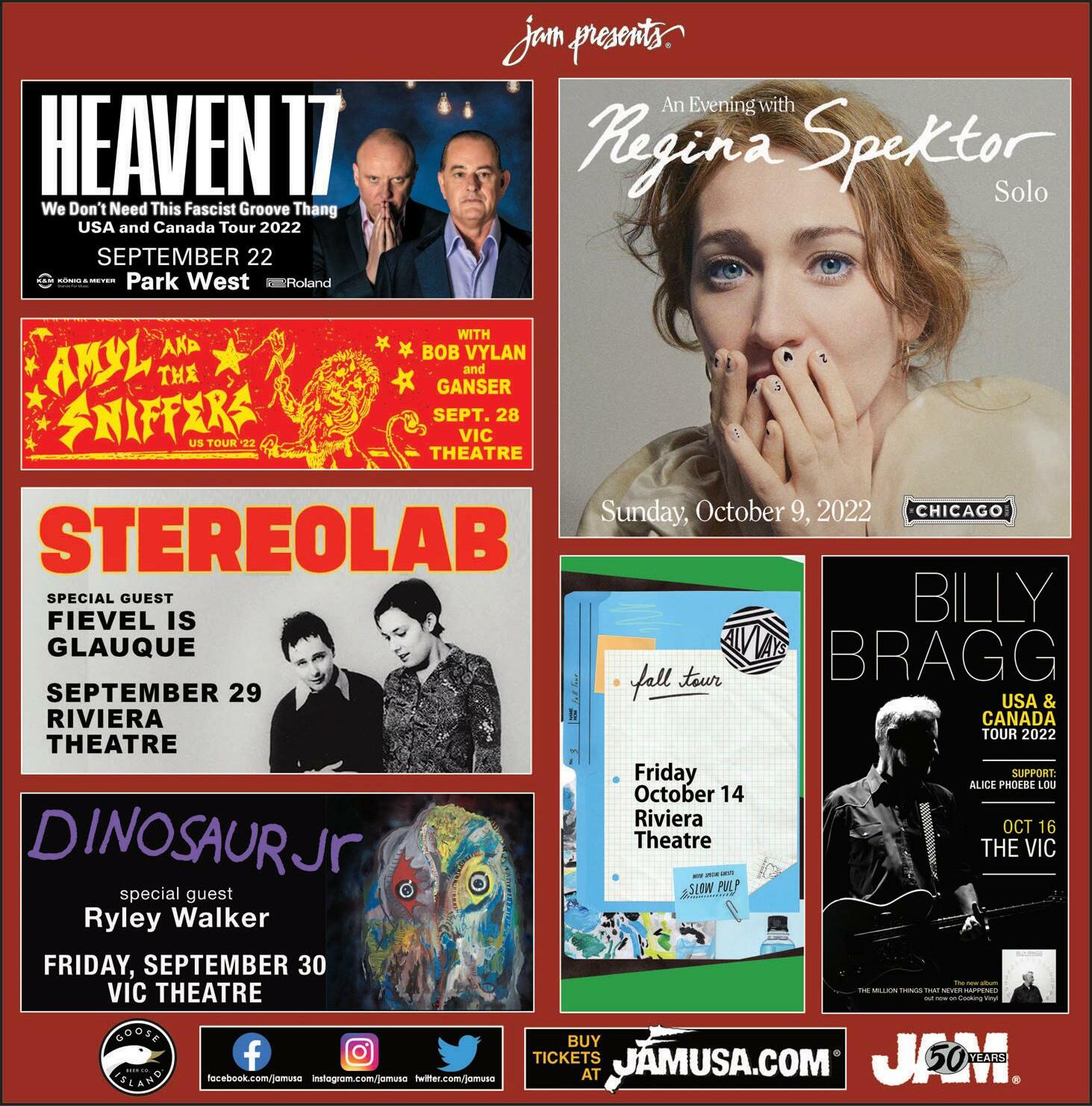
SEPTEMBER 15, 2022 - CHICAGO READER 67
CHICAGOANS OF NOTE
Amanda Flores, aka DJ Flores Negras, founder of Mictlan Productions
As told to JAMIE LUDWIG
Amanda Flores is a Chicago musician, DJ, event promoter, and licensed massage therapist. While fronting metal band Rosaries in 2017, she launched Flores Negras Productions to help create new inclusive spaces in the local music community. Soon after, she began DJing, also under the name Flores Negras. During the pandemic, she’s grown a following for the eclectic taste she showcases at events such as Necropolis (which focuses on dark electronic and industrial sounds) and Cumbia y Los Goths. In August, Flores announced that she’s rebranding her company as Mictlan Productions, while continuing to DJ as Flores Negras—a separation that she hopes will allow both to continue to grow along their own paths. The production work has become increasingly collaborative as well, and she wants to share more of the spotlight with the team of people who are helping her celebrate diverse identities, music, and art in Chicago’s nightlife scene.

My family’s from the border of Texas. It’s a complicated thing when you’re from Texas and you have to assimilate. So my dad got really into American pop culture. He was a music and movie nerd, and he introduced me to a lot of di erent music at a very young age. My grandma had a weird old organ in the house, and I’d play with the keys as a toddler.
My dad bought me my first guitar when I was 11; he worked three jobs, so it was a lot to be able to get that guitar. But I couldn’t a ord lessons, and I was also a visual artist. So in school, when I had to choose if I was gonna take an art class or music class, I chose art. I never really was trained in music; I had more of a spiritual, emotional connection with sound.
My youth was spent going back and forth from Chicago to Texas. My family didn’t want us to grow up there because we were right on the border, and there was all the cartel stu going on the other side. And also at the time there was more work up here.
My dad started taking me to concerts too. I saw Joan Jett and wore a leather jacket when I was like five. My family sometimes dressed us up like little rockers, but then they got a little scared when I got really into Korn and stu . There was a little bit of conflict, or restrictions and censorship of my expression. They blamed a lot of my sadness that was more the result of a true trauma on the music, and I had it taken away from me a lot.
I started to find fake IDs at 15 and go out to weird raves, and I did a lot of drugs. I overdosed at 17, and then I said, “I can’t do this anymore.” I stopped listening to techno for ten years—I just didn’t wanna fall back into it again—and I just focused on more metal and rock music, like the stu that I grew up with.
68 CHICAGO READER - SEPTEMBER 15, 2022 ll
PEDRICK HALES
MUSIC
“A lot of people are the same—we just constantly feel like we need to conform to fit in. But I don’t want people to feel like they have to conform in my spaces. I want them to be whoever they are.”
MICTLAN PRODUCTIONS PRESENTS NECROPOLIS
Part of Mictlan’s residence at Subterranean on the second and fourth Fridays of each month. Fri 9/23, 10 PM, Subterranean downstairs, 2011 W. North, $10, 21+
I used to dream about being a DJ when I was a kid. Back in the day it was a little harder—I didn’t even have a laptop. So I gave up on that for a minute and just kind of wandered. I drank a lot—I was an alcoholic for most of my life— so I didn’t play music for a good chunk of time. And then I was in a very abusive relationship, and that took a good chunk of my life too.
Rosaries kind of saved me. That [abusive] person said, “You have to choose—either that band, or having a life with me.” I chose music.
I don’t know if you’ve ever seen Rosaries play, but I don’t speak onstage. I don’t say, “Hi, this is Rosaries.” I have anxiety. If I don’t have to speak, it’s fine, but otherwise I feel awkward. So [performing] is a way to just feel or express myself. I’m going through a spiritual experience and just really belting out what I feel. I throw my body around. A lot of it is just how I project my anger and sadness, instead of projecting it into drugs and alcohol.
Rosaries started in 2016, and I started the productions in 2017. It was kinda hard for [my band] to find shows. There’s a lot of gatekeeping in Chicago, and that person I’d been with was also a musician, and I didn’t feel safe in a lot of places. They pulled the whole thing: “She’s a liar, she’s doing it for attention.” And there was a group of people who believed it— even though there were photos and things.
That’s a tale you hear all the time. I notice that repetitiveness throughout punk and di erent scenes, of people going through the same thing with these men in power in the music world. So you never feel safe in certain spaces, because “Oh, that’s so-and-so’s friend.” You feel like you have to watch your back, and you feel like you can’t comfortably dance or be yourself. That’s why I started doing productions, and that’s why I put my name on it. It was like, “Hey, motherfucker— you can’t be here.”
I started throwing events on weekdays, which was tough. The [club bookers] were like, “Oh, I guess I could give you a Tuesday in the middle of winter.”
[At my events] I never ever said, “This is only a safe space.” There’s always a lot of resistance. There are a lot of weird people who just like to bother you and get you mad on the Internet, and I don’t like dealing with them. So I didn’t post much about that, but it was always my intention with booking. If someone was problematic, I never booked them again.
So I intentionally created these spaces. It was a lot of friends and community, and giving people the space and platform that few others would. I understood not fitting in a genre or
a stereotype. Rosaries has that problem too; we’re not your basic doom metal, or we’re not your basic psych, we’re just really weird. And that’s the thing—I’m really weird, and people are really weird. Nobody is just one thing.
I like to accept everyone’s form of creation, basically, because I get it. Music has evolved from so many di erent influences that when somebody says that [they only like one type], like they’re only a metalhead and they don’t like other things, I’m like, “You’re actually a poser.”
Some people thought [what I was doing] was weird, on the metal side. I like to DJ, but I also like to DJ cumbia and other stu because my identity is very complex and comes from all these di erent pieces of my life. A lot of people are the same—we just constantly feel like we need to conform to fit in. But I don’t want people to feel like they have to conform in my spaces. I want them to be whoever they are.
I quit drinking in 2018. I collect vinyl, and right before the pandemic, I did a couple vinyl events with my friend and bandmate Ivan Cruz [also from Of Wolves], who has very diverse tastes in music as well. So I did the vinyl DJing for a little bit, but vinyl is really heavy, and it’s more expensive if I wanted to continue DJing.
I eventually got a laptop, and my first gig as a digital DJ was sadly like the last gig I had before the pandemic, on March 7, 2020, at SubT. When the pandemic happened, I was alone, and I had a lot of time to think. I started to really embrace every single part of my past and really dive deep and reminisce about the music I used to listen to back then. I think I did three online events, and then in the winter of 2021, I did this online cumbia goth event, and someone randomly shared my flyer. This big artist called NoFace shared it, and a bunch of artists from LA began following me and hitting me up.
Cumbia always sounded really hard to me—that beat always seemed like a heavier sound. I knew from growing up that new wave and dark music is really big in Chicano culture. I throw it all together, and it’s the best party ever. We can be in both realms, from one side of the spectrum to the other, and find our in-between. A lot of DJs love that they can play whatever they want because it’s an expression of identity and that spectrum has no limits.
I also love writing music, but when you can’t get together with your band, like during the pandemic, you’re all alone. Rosaries wasn’t really practicing, and once we were able to work again, we were all like, “OK, we have to work.” So we didn’t get to see each other.
Now we’re looking for a new drummer, and we’ve already gone through a lot of drummers. But I told my bandmates I really want to focus. I really want to take us to play on the west coast and do some other things, to give us some goals. I miss playing a lot. It makes me sad sometimes that I’m not able to sing, but it will happen again.
Last month I DJed twice in LA, and I’m in Texas next week. It’s all DIY. I plan to let music take me to places that I never thought it would. I constantly find myself feeling like I’m in a really cool indie film, where everything looks cool and the vibes are cool. So wherever music takes me, I shall go if I can a ord it.
[Outside of music] I’m a healer. I’ve been a massage therapist for ten years, and I have my own wellness studio. I use sound therapy as well and integrate it into my work on the channels. I study acupuncture as well. I do a lot of things, and this is how I stay sober.

I believe that sound has feelings and can create feelings and emotions. A sound can also be a form of nostalgia. I do love soundtrack music a lot, and the way that it can be used to create a mood. So I do have a lot of intentions with sound. It’s cool how sound is a vibration, and we’re bodies of water and we can conduct those vibrations very well and feel that energy inside.
With Cumbia y Los Goths, I’ll bring out songs that you’d hear when you’re a little kid, then bring out songs that maybe you heard with cousins in high school, and then mix in something current. I’m activating parts of our memories. I’ve had people come up to me, thanking me for creating these spaces. It
means a lot to me to be able to create a healing space—because we’re seen, we’re present, we exist.
A lot of times the “other” is looked past, and we’re not represented in spaces. That could mean Chicano, Latine, people going through troubles, people who are nonconforming, nonbinary. We all have different memories, di erent problems, and di erent paths in life. My events are for whoever feels like they’re being called; that’s what I’ve noticed as it’s been growing.
I’m pulling people out of the woodwork, people I’ve never seen before, and I love it. Maybe it’s a place where—instead of just being at home listening to your headphones—you’re like, “Oh wow, someone is gonna play all this stu that’s weird too.” That person could like half the stu , and their friend could like the other half of the stu , and everyone’s vibing anyway because it flows.
If you think of how music has evolved, in general, metal comes from the old blues stu , and if you go back further, it’s really native music. It’s OK to listen to di erent sounds. I think you can become a better musician by listening to di erent types of music and seeing how di erent music styles have evolved and influenced each other. I could dive deep on that all day.
[As Flores Negras Productions grew], a lot of people were honestly confused. They knew the productions, but they thought that other people were me, and I thought that was unfair to the other artists [who work with me]. Like my friend Angie Delvalle, a great local artist under the name Lucid Is Dreaming who curates dark arts market pop-ups at the events, and resident DJs Faith Betinis (Necropolis) and Maddjazz, aka Jorge Ortega (Ratchet AF).
I don’t want to turn the productions into something where it’s all about me. I also want to make sure the people who are going to help are dedicated to the whole concept of it all—which is creating those spaces and understanding that diverse mix of music.
So I was on a plane, and I just decided, “This is it. I’m changing it, ripping o the bandage. It’s over.” I had the party Necropolis, which I still do, but something happened where there’s a huge Necropolis party happening in Chicago, and they took that Instagram [handle]. I decided to use Mictlan because it’s the Aztec version of the underworld, and we’re like the lost souls. So all the people who feel lost can come to Mictlan parties. v
SEPTEMBER 15, 2022 - CHICAGO READER 69
@unlistenmusic MUSIC
Last month Amanda Flores renamed her production company a er the underworld of Aztec mythology. PEDRICK HALES
PICK OF THE WEEK
CONCERT PREVIEWS THURSDAY15
Alkaline Trio See also Fri 9/16. 9 PM, Metro, 3730 N. Clark, sold out. 18+
STRANDED CIVILIANS, MUGEN! THE HUMAN, LINDA SOL Mon 9/26, 8 PM, Schubas, 3159 N. Southport, 21+. F
CHICAGO RAPPERS TONY SANTANA and Aubry know that all the talent in the world can’t make a hip-hop duo work if the MCs don’t click. As Stranded Civilians, Aubry and Tony rap off each other like they just hang out and vibe 24-7—and their second mixtape, February’s self-released Obsidian, will make you wish you could be part of the fun. It’s a joy to listen to, powered by a youthful euphoria that makes it one of the best Chicago hip-hop releases of the year. On the hook for “Nobu,” Tony runs through the song’s lilting guitar loop like a tire obstacle course, but the second Aubry picks up the mike, the tone changes dramatically: he treats the same loop as a guide and a friendly challenge, subtly ratcheting up his smooth and speedy delivery without a wrinkle. Stranded Civilians fill Obsidian with easygoing, cheerful R&B melodies that feel as relaxed and hopeful as a Saturday morning before you’ve made any plans—and its tightrope-taut percussion will give you plenty of energy for whatever plans you do make. On the best songs—the reflective “Levitate (Alone II),” the playful “Angels”—Aubry and Tony rap like the simple fact that they’re making art together has opened up limitless possibilities.
 —LEOR GALIL
—LEOR GALIL
The past decade has been an odd one for Alkaline Trio. Following the release of the Chicago punk band’s eighth studio album, 2013’s My Shame Is True , all three members took time off to focus on solo material and side projects. But when vocalist and guitarist Matt Skiba joined Blink-182 in 2015, the band he’d started in 1996 no longer felt like his main gig—he became immersed in Blink, playing on two of their albums and touring with them prior to the pandemic. Alkaline Trio reconvened for 2018’s Is This Thing Cursed? , but drummer Derek Grant began a leave of absence before the touring cycle started, citing a need to focus on his mental health—which left the band without the rhythmic backbone they’d had for the previous 15 years. Skiba’s stint in Blink-182 is potentially ending, though (if his recent eyebrow-raising social-media comments about being iced out of the band are at all accurate), and Grant is back in the fold. This makes Alkaline Trio’s return to Metro—billed as an official Riot Fest “aftershow,” though it takes place the night before they headline the Roots Stage on the festival’s first day—feels both like a celebratory homecoming and a chance for the members to recommit to a band they’ve had on pause.
As one of the most successful acts to come out of Chicago’s fertile 90s punk scene, Alkaline Trio have gone from Fireside Bowl mainstay to majorlabel recording act with a Nike partnership, then settled into their own Epitaph imprint, Heart & Skull. Even though each member eventually moved away from Chicago, they’ve still flown the city’s flag like a badge of pride, and they’re known to pull out all the stops when they return here for a run of shows. With so much Alkaline Trio history made on Metro’s stage—they’ve released two show-exclusive seven- inches at the venue and recorded a whopping nine live albums there—the timing of their return feels symbolic. The band are moving into legacy-act territory, so that this concert feels less like an obligatory festival a ershow and more like the first page of their next chapter.
—DAVID ANTHONY
FRIDAY16
Alkaline Trio See Thu 9/15. This set is part of Riot Fest. 7:25 PM, Roots Stage, Douglass Park, 1401 S. Sacramento, one-day passes $129.98-$899.98, two-day passes $199.98 (general admission only), three-day passes $299.98$1,999.98. b
Ten City Part of the Chicago House Music Festival and Conference, which runs from Thu 9/15 through Sun 9/18. Patrick Moxey will be interviewed on Thu 9/15 at 8:30 PM at the Logan Center for the Arts. On Fri 9/16, Ten City headline; the bill also includes Josh Milan and his
70 CHICAGO READER - SEPTEMBER 15, 2022 ll
insights for the week of September 15
BLAKE BONAPARTE b ALL AGES F
With Obsidian, Stranded Civilians have made one of the best Chicago hip-hop releases of 2022
Recommended and notable shows and releases with critics’
MUSIC
band and a celebration of Robert Williams and the Chosen Few DJs. 5:30 PM, Pritzker Pavilion, Millennium Park, 201 E. Randolph. Fb
Ten City’s fi h album, 2021’s Judgement (Ultra), was a long time in the making—and not just because the crucial Chicago house group’s previous album, That Was Then, This Is Now , came out 27 years earlier. The origins of Judgement arguably go even further back than 1986, when Ten City producer Marshall Jefferson issued the foundational house single “Move Your Body” through Trax Records. Three years before that, future Ultra Records founder Patrick Moxey had moved to town to attend the University of Chicago, where he helped Ken Wissoker launch WHPK’s first hip-hop show, started a magazine at the station (for which he interviewed the likes of Big Black), and booked occasional gigs, including one with house trio Fingers Inc. Moxey also sharpened his DJ skills under the tutelage of Joe Smooth, spun at Smart Bar, and hung out at Medusa’s and other house hot spots. Moxey moved to New York City in the late 1980s, where he became an industry player—in the years since he founded Ultra in 1996, the label has worked with EDM stars such as Calvin Harris, Kaskade, Deadmau5, and Steve Aoki—but before he le , he met Marshall Jefferson. A few years ago, a er Jefferson reconnected with Ten City vocalist Byron Stingily, Moxey and Ultra label exec David Waxman reached out about releasing new Ten City music.
This version of Ten City is different, of course, not least because it’s missing a key member of the band’s classic lineup, guitarist and backup vocalist Herb Lawson. But the DNA of their music hasn’t changed. On Judgement , the new duo version refine their soulful resplendence and maintain their fidelity to addictive rhythms—their beats work subtly, but they draw you in as powerfully as a colossal horseshoe magnet that Wile E. Coyote might order from Acme. The album feels both contemporary and familiar, in part because it includes reworked
material from the late 80s: two new remixes of the 1987 single “Devotion” and a sharpened update of 1989’s chart-topping “That’s the Way Love Is.” Stingily’s otherworldly falsetto has gotten slightly raspy with age, which lends an alluring new earthiness to the group’s sleek style. Ten City surely won’t let another 27 years pass between albums, since they’ve already released more music—this summer they dropped the light disco number “A Girl Named Phil.” —LEOR GALIL
SUNDAY18
Plantasia Featuring original sets by Robert Aiki Aubrey Lowe, Nailah Hunter, and Bing & Ruth plus reinterpretations of the classic Mort Garson album by Angel Bat Dawid, Devin Shaffer, Macie Stewart, Rob Frye & Potions, and Aitis Band. 6:30 PM, Garfield Park Conservatory, 300 N. Central, $40. 18+

Bridging the ultrasynthetic and hyperorganic, Mort Garson’s album Mother Earth’s Plantasia is a Moog-powered salve “for plants . . . and the people who love them,” as the cover art notes. Since its 1976 release, Plantasia has become cultural canon, attracting reissues of varying legitimacy and providing grist for several exhaustive cultural critiques. A er New York label Sacred Bones released the first authorized reissue of the album in 2019, it teamed up with Empty Bottle Presents to honor the work in a live setting. This year’s installment is their third tribute to Garson’s photosynthetic legacy at the Garfi eld Park Conservatory, where the composer’s work will be reimagined among the fl ora. Headlining is former Chicagoan Robert Aiki Aubrey Lowe, known for his defunct band 90 Day Men and his solo project Lichens; his sound art recently earned its highest-profile exposure yet, in the form of a spectral soundtrack to the 2021
Candyman fi lm. Lowe’s modular collage of drone, guitar, and voice will follow original sets by Afrofuturist harpist Nailah Hunter and ambient ensemble Bing & Ruth. The evening’s other performances will all be reinterpretations of Plantasia by power players from Chicago’s improvisational scene, including Angel Bat Dawid, Devin Shaffer, Macie Stewart, and Rob Frye. While the artists’ approaches to the material will vary—Shaffer will paint the room with swaths of found sound and synthesizer, while Aitis Band will forge le -of-center anti-guitar music—their tributes to Garson’s work are sure to be whimsical and lush. These days the world feels relentlessly chaotic and sinister, which makes this night to celebrate our connection to the natural world a treat for plant enthusiasts and music lovers alike. —SHANNON NICO
SHREIBAK
SATURDAY24
Hyde Park Jazz Festival See also Sun 9/25. Today the festival takes place at 13 venues around the neighborhood, including two outdoor stages on the Midway Plaisance, the Logan Center for the Arts, Rockefeller Chapel, the Smart Museum, and Little Black Pearl. 11 AM-10:30 PM, complete schedule at hydeparkjazzfestival.org, $10 suggested donation. b
Hard times will bring out anyone’s true colors, and the Hyde Park Jazz Festival certainly showed what it was made of when COVID-19 brought live music to a halt in 2020. Its organizers emulated the music that the festival supports, improvising ways to support local jazz. First, they arranged the Jazz Postcards series, small-scale outdoor concerts that popped up around the city. Then, while most festivals took the year off, they staged the 2020 festival in parks and on sidewalks around
Hyde Park and adjacent neighborhoods. This year, the HPJF resumes business as usual, staging concerts inside churches, museums, and performance spaces as well as on two big outdoor stages that face each other on the Midway Plaisance. The programming combines a complement of musicians who have maintained lifelong commitments to the south side—including storyteller Maggie Brown, saxophonist Ernest Dawkins, and singer Dee Alexander—with adventurous artists from the rest of the city and far beyond. Pianist Jim Baker and the drums-and-reeds duo of Mike Reed and Hunter Diamond exemplify the city’s robust avantgarde community; the Chris Greene Quartet represents the mainstream. Darren Johnston, a New York-based Canadian trumpeter, will reunite with the splendid Chicago- based band he enlisted to record his briskly lyrical new album, Life in Time (Delmark). The Chicago-Amsterdam quartet These Things Happen will celebrate the release of their debut mini album, which balances deeply felt originals with swaggering interpretations of material by Herbie Nichols, Dewey Redman, and Thelonious Monk. Electric guitarist and former Chicagoan Jeff Parker will reveal the ways that old soul and new technologies enrich his playing. New York-based pianist David Virelles, whose recent CD Nuna (Pi) reconciles classical rigor and Cuban rhythms, will present a solo recital. And in a fi rst-time encounter, pan-national string ensemble Hear in Now, which includes local cellist Tomeka Reid, will workshop and perform a set of new material with improvisational Ethiopian-based group Qwanqwa.
—BILL MEYER
Hyde Park Jazz Festival See Sat 9/24. The second and final day of the fest takes place at two outdoor stages on the Midway Plaisance.

SEPTEMBER 15, 2022 - CHICAGO READER 71
Charles McPherson performs with his quintet on Sat 9/24 at the Hyde Park Jazz Festival.
MUSIC
COURTESY HYDE PARK JAZZ FESTIVAL
Qwanqwa collaborate with Hear in Now on Sat 9/24 at the Hyde Park Jazz Festival. COURTESY HYDE PARK JAZZ FESTIVAL
SUNDAY25
MUSIC
In order of performance, the Wagner Stage (at S. Woodlawn) features the Orbert Davis Sextet, the Chicago Soul Jazz Collective with Dee Alexander, and the Victor Garcia Sextet; the West Stage (at S. Ellis) features Johnny Blas and Clif Wallace + Five. 2-7 PM (Wagner Stage) and 3-6 PM (West Stage), complete schedule at hydeparkjazzfestival.org, $10 suggested donation. b
MONDAY26
Stranded Civilians See Pick of the Week on page 70. Mugen! the Human and Linda Sol open. 8 PM, Schubas, 3159 N. Southport, 21+. F
WEDNESDAY28
mayorkun 7 PM, Park West, 322 W. Armitage, $54-$65. 18+
In early 2016, Nigerian songwriter Mayorkun posted a video of himself covering “The Money,” a 2015 single by Nigerian American pop star Davido. At the time, Mayorkun was dissatisfied with his banking job, and when he submitted his resignation letter, he fortuitously received a DM the same day from Davido, who had seen the clip and wanted to hear more. Mayorkun soon signed to Davido’s DMW label, which released his bubbly 2016 debut single, “Eleko”—named after a beach near Lekki, the city in Lagos State, Nigeria, where he relocated at the beginning of his new chapter as a musician. That same year, Mayorkun released the celebratory “Yawa,” filled with synthesized horns and choral arrangements, but his real breakthrough came in 2017 with “Mama,” a sweet love song about pining for a girl. The first single from his album debut, 2018’s The Mayor of Lagos , it’s now an Afrobeats classic—but you don’t have to be familiar with the genre (or with Nigerian actress Toyin Tomato, referenced in the lyrics) to feel its underlying joy. The tune’s syncopated rhythms, synth accents, and playful interjections of “Scooby Dooby Doo!” express honeymoon-phase infatuation at its most irresistible. Mayorkun’s hot streak has continued ever since, even when he works alongside collaborators. The slick groove of his 2019 track with Nigerian producer Shizzi and singer Teni, “Aye Kan,” suits its lyrics about reveling in late-night dancing, and on last year’s “Holy Father” he linked up with rapper and songwriter Victony to provide spiritual meditation alongside so , repeating coos. He’s also released many collaborations with Davido; 2017’s percussion-driven “Prayer” and 2020’s summery “Betty Butter” are particular highlights. Last year Mayorkun released his palette-expanding second album, Back in Offi ce (Sony Music West Africa), which incorporates a style of moody South African house music called amapiano. Mayorkun’s most recent single, “Certifi ed Loner (No Competition),” sounds like an extension of that exploration, with a rolling beat that provides a steady foundation for his smooth vocals. As with all his best songs, its elements are simple but potently charming.
—JOSHUA MINSOO KIM
ALBUM REVIEWS
Nicole Mitchell & Fabio Paolizzo, Medusae Don Giovanni dongiovannirecords.bandcamp.com
Flutist Nicole Mitchell and composer Fabio Paolizzo first performed together live in 2018, in a concert at the University of California, Irvine. More accurately, Mitchell played a duo set with VIVO (Video Interaction VST Orchestra), a machine-learning program engineered by Paolizzo, which recorded her flute and voice improvisations and generated real-time accompaniment through loops and synths. A year later, Mitchell and Paolizzo reprised their collaboration at the same venue, then recorded it on the studio album Medusae, which they’re releasing this month on Don Giovanni.
Deputizing autonomous tech as a musical partner is nothing new. Trombonist and computermusic pioneer George Lewis—like Mitchell, a product of Chicago’s Association for the Advancement of Creative Musicians—famously employed it on his 1987 work Voyager , as well as in its recently mastered and released predecessor, Rainbow Family. But VIVO has a secret weapon: a camera, which adds the extra layer of optically processing Mitchell’s movements as well as her aural cues. (In case you’re flummoxed, Paolizzo has published scholarly articles which provide a more extensive explanation of VIVO’s functionality.)
VIVO’s AI is more subtle than the chattier digital interlocutor of Voyager. It mostly buttresses and manipulates Mitchell’s lines, rather than responding with its own knotty improvisations. But the way it does so can be downright frightful: the gusty “Gametes” sounds like being inside a glass bottle as it’s blown, and parts of “Perils to Beauty” get pretty close to the music I imagine the devil’s organist might play in hell. VIVO’s technological sophistication is a marvel, but you don’t have to care about that to find Medusae a deeply satisfying spin. It’s an aural hall of mirrors, delightful in its disorientation.
—HANNAH EDGAR
PArrish, Dear Klaus Nomi Self-released manparrish.com/klausnomi
You might expect an album of Klaus Nomi material to sound like Klaus Nomi, but Man Parrish’s Dear Klaus Nomi isn’t that. Instead, the New York producer has added highly technical musical accompaniments to archival recordings of the cult figure’s songs to give them fresh sounds and feelings. The result is a love letter from one openly homosexual musician who survived the AIDS epidemic of the 80s to one who did not. Man Parrish met Nomi—a German-born vocalist who trained as an opera singer and cut his teeth on avant-garde vaudeville and performance art—while the former was a gay runaway circulating in the New York downtown club scene of the late 1970s (the same one that birthed artists such as Keith Haring, David Wojnarowicz, and Jean-Michel Basquiat).
Nomi inspired Parrish to pursue electronic music, and in 1982, Parrish provided the soundtrack for a gay porno. Shortly a er the film came out, he dis-
covered his beats being appropriated by club DJs, and the unexpected success of those songs prompted him to release his self-titled debut later that year (Nomi contributed vocals to the track “Six Simple Synthesizers”). Parrish has since been recognized as an early innovator in hip-hop, and he’s enjoyed a long and storied career as an unapologetically homosexual electronic artist and producer. Among his best-known tracks is the frenetic, pulsating “Male Stripper.”
While Parrish and Nomi were cut from the same cloth in many ways, their music and personas stand in stark contrast. Nomi first pinged the pop-cultural radar when he and close confidante Joey Arias appeared as backup singers to David Bowie during the Starman’s 1979 appearance on Saturday Night Live. One of Bowie’s costumes on the show inspired what became Nomi’s signature look: a black triangular tuxedo that gave Nomi a comically hypermasculine torso, paired with form-fitting pants that highlighted his lithe, elegant legs. Nomi also wore pouty black lipstick and drawn-on eyebrows, and he sang in the countertenor register (equivalent to a “female” contralto or mezzo-soprano).
Nomi’s career sped up after his SNL cameo. Record companies were excited by the beautiful, seemingly asexual alien with a sad heart, but they struggled to market his work—there just wasn’t a category for his mix of operatic vocals, new-wave synthesizers, and electric guitar, presented with theatrical elements and effete BDSM. Many fans understood the robust queerness of the way he visually and audibly played with gender and sexuality, but he was never publicly coded as the “threatening” kind of homosexual (the way Man Parrish was), in part because his music and stage show were soer and not especially about sex. When Nomi died of AIDS-related complications in 1983—one of the first high-profile deaths in New York in the early days of the epidemic—he’d released only two records. Music so-and-sos had been expecting his third to be his Ziggy Stardust
Dear Klaus Nomi is not an imagining of Nomi’s second act; it’s a merging of histories. The record is lush and energetic in a way that Nomi’s output isn’t—it’s a true headphones album, with its engrossing depth of sound and its tones that seem to shi through 360 degrees. It owes as much to modern recording technology as it does to modern electronic-music theory, and its levity and aggres-
sion feel truer to Man Parrish’s work than to Nomi’s. It’s not only designed to inspire a certain groove, but it also reflects a future Nomi never got to see. If you let go of your expectations, you might find something profound and beautiful about that—even though many Nomi fans still might want something else. Dear Klaus Nomi is a document of an unknowable kinship shared between two men of a very specific era. —MICCO CAPORALE
Tink, Pillow Talk
Winter’s Diary/Empire instagram.com/official__tink
Singer, rapper, and songwriter Tink broke out of Chicago’s hip-hop scene about a decade ago, becoming one of the constellation of new stars lighting up the city. Like many local artists who emerged around the time of drill’s first wave in 2012, she signed to a big label—in 2014 she closed a deal with Mosley Music Group (run by super producer Timbaland) and Epic Records. Tim frequently compared Tink to Aaliyah, which did the Chicagoan few favors. Tink split from MMG in December 2017, a er her album debut for the label, Think Tink, had collected dust for two years (it still hasn’t been released), and since then she’s frequently voiced her frustration with such comparisons. “I caught a lot of backlash . . . with him comparing me to her and telling me I’m the next Aaliyah,” Tink said on WWPR’s The Breakfast Club last month. “You can’t play with legends like that.” But Tink’s fortunes have improved lately, thanks in part to producer and Chicago native Hitmaka—she’s developed a working relationship with him, and they’ve made the kind of music that gets you invited on The Breakfast Club They collaborated on her 2021 album, Heat of the Moment , as well as on her new Pillow Talk (Winter’s Diary/Empire). The new record makes plain that Tink has fun with Hitmaka, because as she explores romantic despair and ecstasy across its 16 sumptuous and occasionally salacious R&B songs, she never once sounds checked out or tired. Tink has been a professional musician for long enough that she can land just about any idea—her lyrics on “Goofy” are comically raunchy (“This dick got me goofy / Halfway past stupid”), but her sophisticated charisma makes even the most audacious lines go down smoothly. —LEOR
 GALIL v
GALIL v
72 CHICAGO READER - SEPTEMBER 15, 2022 ll
Find more music listings at chicagoreader.com/musicreviews
Man
continued from 71
Tink SHAUN MICHAEL
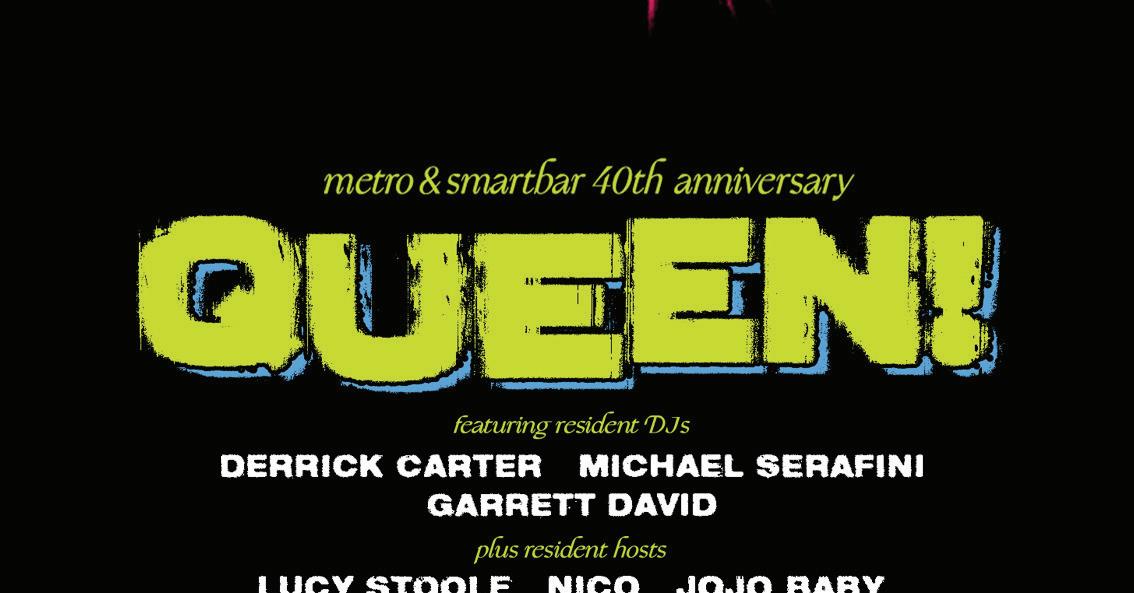
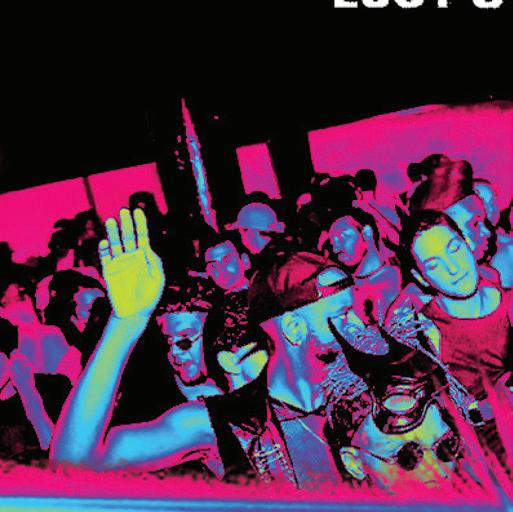
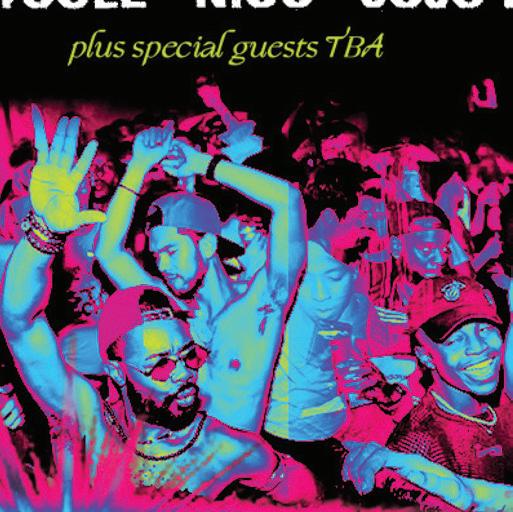
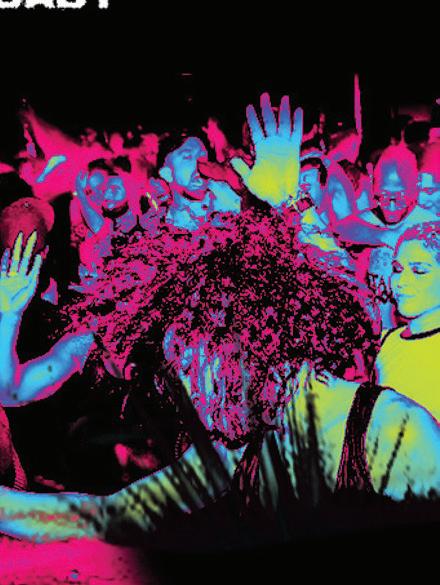


SEPTEMBER 15, 2022 - CHICAGO READER 73 Visit Ravinia.org SATURDAY, SEPTEMBER 17, 2022 SATURDAY, SEPTEMBER 17, 2022 SATURDAY, SEPTEMBER 17, 2022
EARLY WARNINGS
Mista Magoo 10/5, 9 PM, Punch House F
MK 10/28, 10 PM, Radius Chicago, 18+
Modest Mouse 12/9, 7:30 PM, Riviera Theatre, 18+ Narrow Head, Temple of Angels, Bleed 10/15, 8:30 PM, Empty Bottle
Molly Nilsson 10/11, 8 PM, Thalia Hall
Nora Marks, Cut Your Losses, OK Cool, Pinksqueeze 9/30, 9 PM, Gman Tavern
Nova Twins, Gully Boys 10/9, 7 PM, Subterranean b
Old Sea Brigade 11/10, 8 PM, Schubas, 18+
Omega-X 10/10, 6 PM, Concord Music Hall b Frank Orrall 10/1, 8 PM, SPACE, Evanston b
Ben Ottewell, Ian Ball of Gomez 11/11, 8 PM, SPACE, Evanston b
NEW
Amtrac, Crazy P (DJ set) 10/16, noon, Headquarters Beercade Andi 11/7, 7:30 PM, Schubas b
Argonaut & Wasp, Hembree 10/8, 8 PM, Schubas, 18+
Augustana 10/18, 8 PM, City Winery b
Bad Omens, Dayseeker, Make Them Suffer, Thousand Below 11/25, 5:30 PM, Concord Music Hall b
Bass Drum of Death 12/8, 8:30 PM, Empty Bottle
Blackberry Smoke 12/16, 7:30 PM, the Vic b
Blessed Madonna, Haai, Harry Cross 9/30, 10 PM, Smart Bar
Blu DeTiger, Tiffany Day 11/8, 7 PM, Metro b
Blushing, Lucid Express 10/24, 8:30 PM, Empty Bottle
Bobby Shmurda, Rowdy Rebel, GS9 Gino aka Fat Tony, and more 12/1, 8:30 PM, the Vic, 18+
Jim Brickman 10/6, 8 PM, City Winery b
Buku, G-Rex 10/22, 9:30 PM, Avondale Music Hall, 18+
California Honeydrops 10/27, 8 PM, Thalia Hall, 17+
Josh Cashman 11/1, 8 PM, Schubas, 18+
Cem Adrian 10/5, 8 PM, City
Winery b
Chrisette Michele 10/23, 5 and 8:30 PM; 10/24, 8 PM, City Winery b
CMAT, So Launch 10/3, 8:30 PM, Empty Bottle
Billy Cobham’s Crosswinds Project 9/29, 8 PM, City
Winery b
Chris Connelly 11/10, 7:30 PM, Gman Tavern
Cordoba, Fruitleather, Joshua Virtue 9/30, 7 PM, Subterranean, 17+
Couch, Jackson Lundy 10/8, 9 PM, Lincoln Hall, 18+
Charley Crockett, Greyhounds 11/26, 8:30 PM, the Vic, 18+
Cuddle Riot, Bishop’s Daredevil Stunt Club 12/2, 8 PM, Gman Tavern
DJ Cymba, Love Day 9/29, 9 PM, Punch House F Daði Freyr 9/29, 8 PM, House of Blues, 17+
Deadbeats night one featuring Zeds Dead, Dnmo, Rossy, Heyz 12/16, 9 PM, Aragon Ballroom, 18+
Deadbeats night two featuring Zeds Dead, Blanke, Imanu, Superave, Tinykvt 12/17, 9 PM, Aragon Ballroom, 18+ La Dispute, Sweetpill, Pictoria Vark 9/30, 8 PM, Thalia Hall b
Drugdealer 11/12, 7:30 PM, Thalia Hall, 17+
Eliminate 10/7, 8:30 PM, Bottom Lounge, 17+
Field Medic 11/2, 7:30 PM, Beat Kitchen, 17+
Forester 12/9, 9 PM, Subterranean, 17+
Andy Frasco & the UN, Little Stranger 12/9, 8 PM, Thalia Hall, 17+
Ghostbusters screening with live score performed by the Chicago Philharmonic 10/8, 7:30 PM, Auditorium Theatre b
Giant Rooks 12/10, 7 PM, House of Blues b
God Is War, Bloodyminded, Many Blessings, Maltreatment, Reek of Divinity 10/10, 8:30 PM, Empty Bottle
Gosh Diggity, 1.21 Gigawatts, Divisor, Life Looks Good 10/8, 6:30 PM, Subterranean, 17+
Guided by Voices 12/27-12/30, 8 PM; 12/31, 10 PM, SPACE, Evanston b
Steve Gunn 9/30, 10 PM, Empty Bottle
Habstrakt 10/1, 10 PM, Prysm Nightclub
Haru Nemuri, Frost Children 10/4, 8 PM, Metro b
Sean Hayes 10/26, 8 PM, SPACE, Evanston b Hobo Cane 12/7, 8:30 PM, Szold Hall, Old Town School of Folk Music Fb
Indigo Girls 11/20, 8 PM, Cahn Auditorium, Evanston b
Hayden James (DJ set) 10/7, 10 PM, Prysm Nightclub
Jamie 3:26, Cratebug, Humboldt Arboreal Soundsystem 10/1, 10 PM, Smart Bar
Jillie 10/7, 9 PM, Tack Room F
Junior Boys 3/2/2023, 8 PM, Metro, 18+
Kali Masi, Sam Russo, Tightwire 10/21, 9 PM, Gman Tavern
Zoë Keating 11/20, 7 PM, Maurer Hall, Old Town School of Folk Music b
Mat Kerekes, Rachel Bobbitt & Worry Club 11/13, 7:30 PM, Beat Kitchen, 17+
Nikki Lane 12/14, 8 PM, SPACE, Evanston b
Lissie 12/1, 7:30 PM, Lincoln Hall b
Malaa, Acraze 11/12, 10 PM, Radius Chicago
Manila Killa, Promnite, Dusk Lights 9/30, 9 PM, Lincoln Hall, 18+
Manwolves 10/1, 9 PM, Lincoln Hall, 18+
Kathy Mattea 11/11, 8 PM, Maurer Hall, Old Town School of Folk Music b
Max, Vincint 12/11, 6:30 PM, House of Blues b
Mercyful Fate, Kreator, Midnight 11/3, 6 PM, Hard Rock
Live Northern Indiana, Gary Metz, Spiritual Cramp 12/16, 9 PM, Metro, 18+
Michael J. Miles, Zahra Glenda Baker, Lloyd Brodnax King, Jill Kaeding 10/2, 7 PM, Maurer Hall, Old Town School of Folk Music b
Peppermint, Jujubee 11/23, 8 PM, SPACE, Evanston b Protomartyr 11/16, 8:30 PM, Thalia Hall, 17+
Ben Reilly 10/1, 9 PM, Schubas, 18+
Jessie Reyez 11/8-11/9, 6:30 PM, House of Blues b
Sacha Robotti 11/25, 10 PM, Prysm Nightclub Sa-Roc, Sol Messiah 11/19, 8 PM, Beat Kitchen, 17+ So Moon, Nuovo Testamento 12/7, 8 PM, Metro, 18+
Sons of the Never Wrong 9/30, 8 PM, SPACE, Evanston b
Special Interest 11/30, 8:30 PM, Empty Bottle Tove Styrke 11/5, 8 PM, Beat Kitchen b
Tauk, Kanika Moore, Mungion 10/21, 8 PM, Bottom Lounge, 17+
Tropical Fuck Storm, CB Radio Gorgeous 10/22, 9 PM, Lincoln Hall, 18+ Urban Heat, House of Harm 10/18, 7:30 PM, Bottom Lounge, 17+ Vial, Modern Nun 10/6, 6 PM, Subterranean, 17+ Voxtrot, Yellow Ostrich 10/21, 8:30 PM, Thalia Hall, 17+ Warren Hue 10/21, 7 PM, Subterranean, 18+
When the Sun Sets 10/2, 5:30 PM, Bottom Lounge b
UPDATED
Avalanches 10/1, 6:30 and 10:30 PM, Metro, 6:30 PM sold out, 10:30 PM show added, 18+
Jeff Beck & Johnny Depp 10/23, 7:30 PM, Chicago Theatre, lineup updated b Ibibio Sound Machine, Terror Jr 10/13, 9 PM, Sleeping Village, venue changed
The Mission [UK], Chameleons, Theatre of Hate 10/3/2023, 8 PM, Thalia Hall,
b ALL AGES F
miss
GOSSIP WOLF
rescheduled, 17+ Alex Wasily’s Funk Party 19 10/6-10/7, 9 PM, Schubas, 10/7 sold out
UPCOMING
Baynk 10/29, 8 PM, the Vic b Big Sandy & His Fly-Rite Boys 9/29, 8:30 PM, FitzGerald’s Blood Red Shoes 10/15, 8 PM, Cobra Lounge, 17+ Claudettes, Iguana vs. Bunny 10/7, 9:30 PM, Hideout Dinosaur Jr., Ryley Walker 9/30, 7:30 PM, the Vic, 18+ Girls Against Boys, Facs, Poison Arrows 10/12, 8 PM, Metro, 18+
The Head and the Heart, Shakey Graves 10/1, 7:30 PM, Huntington Bank Pavilion b Iron Maiden, Within Temptation 10/5, 7:30 PM, United Center b
Jaripeo sin Fronteras featuring Pepe Aguilar, Ángela Aguilar, Antonio Aguilar Hijo, Banda Azul Tequila, Mariachi Zacatecano, and more 9/30, 8 PM, Allstate Arena, Rosemont b
Lizzo, Latto 10/16, 8 PM, United Center b

Moderat 9/30, 9 PM, Riviera Theatre, 18+
Mother Mother, Sir Sly, Transviolet 10/7, 8 PM, Radius Chicago b
New Order, Pet Shop Boys, Paul Oakenfold 9/30, 6:45 PM, Huntington Bank Pavilion b
Willy Porter Band 10/16, 8 PM, SPACE, Evanston b Sabaton, Epica 10/15, 8 PM, Aragon Ballroom b
Southern Culture on the Skids 10/12, 8 PM, FitzGerald’s, Berwyn Stereolab, Deradoorian 9/29, 7:30 PM, Riviera Theatre, 18+ Them Vibes, Prescriptions 9/30, 9 PM, FitzGerald’s
Toadies, Reverend Horton Heat, Nashville Pussy 10/9, 7 PM, Metro, 18+
Steve Vai 11/16, 7:30 PM, Copernicus Center b
Vanishing Twin, Jessica Risker 10/5, 9 PM, Sleeping Village Wardruna 10/21, 8:30 PM, Auditorium Theatre b
The Who 10/12, 7:30 PM, United Center b
Wisin y Yandel 10/23, 8 PM, Allstate Arena, Rosemont b
Wolf Alice 10/6, 7:30 PM, Riviera Theatre bv

A furry ear to the ground of the local music scene
ON FRIDAY , September 16, Chicago singer, songwriter, and cartoonist Annie Fish will drop Weird Like Me , an album so steeped in classic alt-rock you’ll half believe Fish recorded it with Flood in 1993. Weird Like Me is a concept record about Fish’s childhood rock dreams, which she says she abandoned a er seeing how the “powers that be” treated Billy Corgan and Courtney Love. She’s presenting it as the reissue of a long-lost album, for which she’s constructed an elaborate mythology, even posting an oral history about her fictional 90s alt-rock fame. Fortunately, you don’t need time travel to hear these songs live: on Saturday, September 17, Fish celebrates the album’s release at Cole’s Bar Gossip Wolf knows Nick Butcher and Nadine Nakanishi of multi media studio Sonnenzimmer mostly for their top-notch concert posters and their clever releases of their own music (Butcher’s 2020 album Saccadic consists of two cassettes—one filled with music, the other with concrete). In 2020, Butcher and Nakanishi began working with local composer Ryan Norris, aka Coupler, on Cat Pose, which they call a “tone poem” or “audio-imaging exploration.” Its graphic score is based on 33 “slices” through an image of Norris’s late cat Jericho, which created loops analogous to audio loops. Through spoken word and drifting electronics, Cat Pose embodies a curious feline climbing and frolicking in an empty apartment. On Saturday, September 17, Butcher, Nakanishi, and Norris perform the piece twice at Sonnenzimmer’s studio (4045 N. Rockwell), at 11 AM and 4 PM. Pianist Mabel Kwan opens both shows. They’re free, but you must RSVP.
Last week, Monobody bassist Steve Marek self-released the self-titled debut album by Holy Western Parallels , which fuses gentle electronics, arty prog, and hip-hop. Holy Western Parallels features contributions from his Monobody bandmates as well as V.V. Lightbody, Udababy members Davis and Joshua Virtue , and more! —J.R. NELSON AND LEOR GALIL
Got a tip? Tweet @Gossip_Wolf or email gossipwolf@chicagoreader.com.
74 CHICAGO READER - SEPTEMBER 15, 2022 ll
Never
a show again. Sign up for the newsletter at chicagoreader. com/early
Peppermint ROBERT FRASHURE
CHICAGO SHOWS YOU SHOULD KNOW ABOUT IN THE
TO COME
WEEKS
WOLF BY KEITH HERZIK
By DAN SAVAGE
Q : I’m monogamous and have been dating my boyfriend who identifies as straight for a little over a year. He told me that he had a strict “no contact with exes” policy when we first met. Due to some sketchy behavior, lies, and gaslighting on his part— regarding contacts with his ex-girlfriends, open dating profiles, and multiple private Instagram accounts—I checked his phone, and my suspicions were confirmed. He didn’t cheat but there were some inappropriate messages that he apologized for. He blocked all his exes and is on the straight and narrow now.
When I checked his phone, I also found strange messages to one of his male friends. My BF sent this guy nudes and videos of him having sex with other women. (This was before we met.) There were also messages detailing how much they admired and missed each other’s cocks, and my boyfriend said he wanted to fuck other women with his friend. When I asked him about his relationship with this man, he said that they are just good friends, and that this kind of sexting was “something straight guys do.” I don’t think any of my past straight boyfriends ever talked about missing other
guys’ cocks, but this is the first boyfriend whose phone I ever checked for shenanigans. Is this something straight guys do?
I don’t care if my boyfriend was bisexual, but I don’t want to be lied to. And I really don’t want to be the crazy girlfriend, but my boyfriend had framed photos of this particular guy in his house that I made him remove. I also asked him to cut off all contact with this man. This is all fresh in my mind because we ran into this guy the other night. They kept telling each other how good they both looked and my BF was visibly nervous the whole time. Is my boyfriend telling me the truth? Do straight guys who don’t have any sexual interest in their friends send them dick pics? My BF is in his mid-40s. He knows I’m bi. The “no contact with exes” rule was his idea, not mine, and I think this guy counts as an ex and should remain blocked. Do you agree?
—STRAIGHT MEN EXCHANGING LONG LUSTY TEXTS EXUDING SEXUAL TENSION
A : Your boyfriend made the rule—no contact with exes (not even eye contact on the subway?)—but at some point, a er the lying and
SAVAGE LOVE
gaslighting, you became the enforcer: digging through his phone, ordering him to block his exes, take down framed photos, etc.
He was apparently willing to overlook your snooping, SMELLTEST, seeing as you’re still together. And you were apparently willing to overlook the mountain of incriminating evidence you found on his phone. While you honored his “no contact with exes” rule from the start, he was swapping texts, sexts, and photos with his exes the whole time, lurking on dating apps, and maintaining multiple Instagram accounts. You concluded he hadn’t cheated on you—he just broke his own stupid rule—but in my experience, SMELLTEST, “rules for thee, not for me” types are rarely very good at honoring monogamous commitments over the long term. I’m not saying he’s cheated on you already, but if not getting cheated on ever is important to you . . . he might not be the guy.
As for his claim that swapping dick pics and compliments are things straight guys do . . .
I haven’t had a chance to snoop through Harry Styles’s phone, SMELLTEST, so I can’t definitively say that no straight guy has ever sent another straight guy his dick pics. (Or spat on another straight guy at a film premiere.) And seeing as lots of straight men enjoy playing “gay chicken” these days (and posting the videos to TikTok), it stands to reason that some straight guys may be swapping dick pics and ironic messages about how badly they want each other’s cocks for the LOLs. But I don’t think that kind of behavior is common among straight guys, particularly straight guys in their 40s.
My hunch is that your guy had and enjoyed a few MMF threesomes with this guy before you met, and it was in
that context—with a woman in the room to heterosexualize any incidental homosexual contact—that he came to appreciate his friend’s cock. Seeing as you dug through his phone long enough to find all the dating apps he’s on, all the messages he’d been swapping with ex-girlfriends, and all those fake Instagram accounts, SMELLTEST, if he was bisexual you probably would’ve found messages he’d sent to other men and his Grindr, Scruff, and Sniffies accounts too.
If this friend is the only guy your boyfriend has ever messed around with, SMELLTEST, if that one guy’s cock is the only cock he’s ever wanted to push past his tonsils, your boyfriend is free to round himself down to straight. I also don’t think having messed around with this one dude makes them “exes” in the romantic/dating sense of the term, and I think you should let your boyfriend put his picture back up.
Finally, SMELLTEST, what the two of you are doing— this guy with his no-contact rules about exes and his lies, you with your snooping and demands to take down photos—sounds so exhausting. Is this a relationship or a police state? If he can manage to remain monogamous and gets a charge out of swapping dick pics with an old friend, what harm is there in that? Why not let him have that? And if the guy was hot . . . why not let both of them have you?
P.S. I hope those videos you BF sent his friend of him having sex with other women were taken with the consent of those other women and that he had their permission to share those videos with his friend. v
SEPTEMBER 15, 2022 - CHICAGO READER 75
Do straight guys swap dick pics? A relationship defined by sketchy behavior, gaslighting, and snooping
The full version of Savage Love is available on Savage. Love. Email questions@ savagelove.net. @fakedansavage POLICE STATE
Chicago Reader is now biweekly More than 60,000 copies will be available at nearly 1,200 locations across the city and suburbs. Find one near you and/or download the current issue: chicagoreader.com/map Upcoming Issues: World Music Fest insert Cannabis Conversations The People Issue The Nonprofits Issue 2022 Year-in-Review Sept. 29, 2022 Oct. 13, 2022 Oct. 27, 2022 Nov. 10, 2022 Nov. 24, 2022 Dec. 8, 2022 Dec. 22, 2022
JOBS
Ann & Robert H. Lurie
Children’s Hospital of Chicago seeks Neuropsychology Technicians for Chicago, IL to administer & score psych & neuropsych tests & questionnaires of pediatric & adolescent patients. Bachelor’s in Psycholoy rela ed field +2yrs exp re ’d e ’d s ills Exp must incl: administering & scoring neuropsych tests of pediatric & adolescent patients; working w/ children & their parents in clinical neuropsych capacity; supervision & training of neuropsych assessment procedures. Background check & health screen req’d. Apply at www.career. luriechildrens.org Trackin code 2 22 2
Caregiver
Responsibilities: Assisting with personal care, Following a prescribed healthcare plan, Ensuring my Mother home is organized according to her needs. Providing mobility assistance may be required, or exa ple helpin y Mother with her motorized wheelchair, appointments, grocery. Meal and watch over. Work Schedle is days a ee and ho rs per day Salary is 2 hr on ac y e ail Daniel (dajcahh@gmail. com) for more details.
SENIOR SAP TECHNICAL CONSULTANT Novigo, Inc. has multiple de reed exp Senior S Technical Consultant available in Chicago, IL. Telecommuting Permitted. To apply, send transcript(s) and resume to: recruitment@ novigo.com and reference e EE
Goettsch Partners (Chicago, IL) seeks Junior Architect to develop architectural building design studies & provide documentation of designs studies, under direction of Sr. project architect & designer, using 2 archi ec ral design software. Must submit electronic version o por olio exa ples of academic projects/digital images/photographs exa ples o echnical drawings of high-rise o ce ho el or ixed se projects. Portfolio must also demonstrate samples of work in AutoCAD, Revit & Adobe software programs. Must have an Architectural license. Submit resumes at hr@ gpchicago.com
IMC Markets (Polar Operations LLC) (Chicago, IL) seeks experienced professional Software Engineer Team Leads to collaborate with Traders, Quants and other members of the engineering team to bring the IMC Group’s quantitative trading strategies and softare pla or o he nex level using advanced analytical and programming skills. Implement individual trading strategies in code using a variety of software programming techniques. Interested candidates should send resume to: talent@ imc-chicago.com with “Software Engineer Team Leads” in subject line.
Computer Programmer, Write, analyze, review, and rewrite programs, sin or o char and diagram, and applying knowledge of computer capabilities, subject matter, and symbolic logic; Correct errors by making appropriate changes and rechecking the program to ensure that the desired results are produced; Perform or direct revision repair or expansion o exis in pro ra s to increase operating efficiency or adapt to new requirements; Write, update, and maintain computer programs or software packages to handle specific jobs such as tracking inventory, storing or retrieving data, or controlling other equipment; Consult with managerial, engineering, and technical personnel to clarify program intent, identify problems, and suggest changes; Compile and write documentation of program development and subsequent revisions, inserting comments in the coded instructions so others can understand the program; Coordinate and review work and activities of programming personnel; Develop Web sites. Mail résumé to Amgaabaatar Purevjal, iCodice LLC, e por r S i e ollin Meado s
Northwestern University seeks Assistant Professor of Accounting Information for Evanston, IL. PhD or ABD in Accounting/ Finance/Economics/ rela ed field re ’d e ’d High-quality research & teaching record & strong recommendations. Applications should include vita, job market paper, & he na es o a leas recommenders. Send application to: M.J. Herth, e 22 a p s ri e E ans on 2
BT Tech Consulting Manager – (Chicago, IL) RSM US LLP: Dirct crea ion o ax rel docs incl reqs, user stories, acceptance criteria, feature description PowerPoint decks, user guides, process flows, wireframes & newsletters. May work remote from anywhere in US. Reqs: Bachelor’s or (or frgn equivt) in Acctg, n o Sys or rel yrs as a Tax Senior Sys e s e veloper or a rel pos. Email res: Attn: C Volkening e 2 2 cla dine volkening@rsmus.com
ABC Supply Corporation Inc. seeks a Software Engineer in Chicago, IL to deliver high-quality production-ready application services, integration programs, APIs, and web ser ices e s MS+2 or BS+ yrs exp To apply mail resume to ABC Supply Corporation Inc., n ennie inde an ABC Parkway, Beloit WI M s re erence Job Title & Job Code:
DePaul University seeks Professional Lecturers for Chicago, IL location to teach courses to grad & undergrad students in the College of Computing & Digital Media. PhD or ABD in Data Sci/Comp Sci/Modeling & Simulation/related field req’d. Req’s: submit a cover letter, CV, teaching statement, & research statement. Send resume to: L. er o ic Eas ac son hica o
Sr Director, Info Tech –(Chicago, IL) for Matrix Sciences Int’l: Leads & Provides guidance by forming Analytics Team in T r o desi n Enterprise-wide Business Intelligence & Data Anlytcs Platform. Reqs: Master’s * (or for equiv) in Info Tech, Comp Sci or a rel’d ield yrs as Dir/Mgr of Info Tech, IT Anlyst or rel’d. *Will accep Bach + yrs exp in lie o Mas er’s + yrs exp incl exp lis ed above. Email resumes to: n Ma rix e hr a rixsciences co
SAP Expert. Bach + yrs exp ra on exp S Mod les SD, MM, PM; Treasury apps that interface w/ SAP (WSS or TREMA); S 2 22 in pro i plementation to provide operational support for RWE SAP Syss. RWE Renewables Services LLC, Chicago, IL. F/T. CV to: ellen.weaver@rwe. com. No calls/agents/ visa sponsorship. ref. job
Medline Industries, LP in Northfield, IL is seek’g: A) IS Business Analyst Associates to dvlp & maint’n enterprz & dept’mntl biz intelligence, data warehs’g, & report’g solut’ns. No trvl; no telecomm. Apply at: https:// medline.taleo.net/careersec ion d confiden ial jobapply.ftl?lang=en&o
B) Sr. Software Tester(s)/Quality Analyst(s) to be respon’ble for QA es case d lp n exe cut’n to ensure biz rqmnts are met & quality stndrds are upheld. No trvl; WFH bnft. Apply at: https:// medline.taleo.net/careersec ion d confiden ial jobapply.ftl?lang=en&o
IMC AMERICAS, INC. (Chicago, IL) seeks experienced professional Traders to develop, maintain, and enhance mathematical models, algorithms, and strategies for quantitative proprietary trading. Conduct quantitative research and analyses o financial markets, industries, and other relevant data to identify new market opportunities and refine trading strategies. Analyze, interpret, and model financial econo ic and industry data to develop and optimize trading strategy parameters to minimize slippage and axi i e re en e en eration. Design, develop, and enhance automated trading system components including trading models, algorithms, and platforms. Prepare and present high-quality financial analysis and reports following IMC global guidelines. Interested candidates should send resume to: talent@ imc-chicago.com with “Traders” in subject line.
Kids Future Day Care Center is seeking a Marketing Manager to Conduct, formulate, and implement appropriate marketing strategies; conduct marketing budget planning and adjustments on marketing strategies etc. Position requires a Bachelor’s Degree in Marketing or Related. Three-year experience as a ar e ing manager or related. Experience analy in e fectiveness of marketing e or s or rela ed ny ap plicant who is interested may submit their resume code ids re2 22 o ids re ay are en er Sheridan d ni hica o
Medline Industries, LP in Mundelein, IL is seek’g multi pos’ns: A) Sr. SQL Developers to dsgn & improve db/SQL centric sw prods in Sales Tech. No trvl; WFH bnft avail. Apply at: https:// medline.taleo.net/careersec ion d confiden ial jobapply.ftl?lang=en&o B) QA
Automation Engineers (Managed Care) to produce test cases for detailed & hi-lvl reqmnts exec ’ a o a ed manual test’g on web browsers & mobile devices. No trvl; no telecom. Apply at: https://medline. taleo.net/careersection/ md_confidential/jobapply.ftl?lang=en&job=INC) IS Project Managers to lead large proj/programs of work, using vary’g delivery models & strategy of broader proj mgmt. No trvl; no telecom. Apply at: https://medline. taleo.net/careersection/md_confidential/ jobapply.ftl?lang=en&o D) Sr IS Systems Analysts to be respon’ble for stabl’ty, reliabl’ty, release deploy’ o B2 B2 eco pla or s No trvl; WFH bnft avail. Apply at: https://medline. taleo.net/careersection/ md_confidential/jobapply.ftl?lang=en&job= M E) Sr. IS Automation Engineers to assist in archt., dsgn & build cloud infra’stre w/in MS Azure. No trvl; WFH bnft avail; must be a ail or in o ce periodic mtgs & tasks when req’d. Apply at: https://medline. taleo.net/careersection/ md_confidential/jobapply.ftl?lang=en&job=INM
StoneX Group Inc. seeks Machine Learning Engineers (two openings - Job Code 3324) in Chicago, IL to develop software solutions and implement machine learning algorithms and tools to drive data science and machine learning projects. Establish data pipelines for data ingestion, analytics and machine learning on large data sets. Please isi h ps s onex com/careers/ to apply.
o e 2 E E
Vistria Group (Chicago, IL) seeks Associate to perform due diligence/ financial modeling & valuation of privately held & public companies & research regarding sectors & investment he es cc ra el in U.S. Submit resumes to Admin@vistria.com, Job 2 22
Royal Cyber Inc. has openings for Sr. Developer (Design, Develop, & Test S/W), IT Project Manager (Manage & Lead S/W Projects), Technical Lead (Design, Develop, Lead, & Test S/W Dev.) & Business Analyst (Plan, Analyze & Manage S/W products) in Naperville, IL. Must have Bachelor or Master or e i prior exp in job offered or rel. field. Ed exp re ire en vary depending on position level/type. Travel reqd. To Apply send res es o Sh an Bl d S i e 2 aper ille or e ail hr.us@royalcyber.com
Test Architect (work site: S Elec ric o N. Ridge Blvd., Chicago, 2 Mail res e o Jennifer S. Bermudez, S Elec ric o Marina Village Pkwy, S e la eda or e ail enni er Bermudez@sandc.com.
Loyola University Chicago is seeking an Assistant Professor in Chicago, IL to teach assigned courses in Sociology and Women Studies and Gender Studies in accordance with the course syllabi. Please send resume to prosenblatt@luc.edu and re erence o
TransUnion, LLC seeks Sr Architects for various & unanticipated worksites throughout the US (HQ: Chicago, IL) to be responsible for sw solution architecture, architect & design sw solutions, cross-domain tech guidance & problem solving for sw apps. Master’s in Comp Sci/ Info Tech/Comp Eng/ any En ield+2yrs exp or Bachelor’s in Comp Sci/Info Tech/Comp Eng/ any En ield+ yrs exp req’d. Req’d skills:sw archi ec re desi n exp w/transforming sw apps into cloud native capabilities; applying architecture patterns, frameworks in building IT strategies rchi a e T distributed systems principles & evolving trends (Secure APIs, SaaS, PaaS, Cloud); creating solution prototypes for sw dev team; establish best practices; project planning & scoping, establishing program governance; leading & mentoring jr devs; Java, Spring; SQL, NoSQL Databases; AWS, e ps S e ile Teleco in permitted. Send resume to: M. Carter, REF: MH, da s hica o
76 CHICAGO READER - SEPTEMBER 15, 2022 ll
CLASSIFIEDS JOBS GENERAL REAL ESTATE RENTALS FOR SALE NON-RESIDENTIAL PROFESSIONALS & SERVICES CLEANING RESEARCH ADULT SERVICES WANT TO ADD A LISTING TO OUR CLASSIFIEDS? Email details to classified-ads@chicagoreader.com
Network Objects, Inc. has multiple openings for the following positions: Master’s+2yrs/ Bachelor’s+5yrs exp/ equiv. SAP ABAP Developer (NSAC21): SAP SD, RICEF, EDI, GTS, ECC. SAP SD Pricing Consultant II (NSPC21): SAP SD, Pricing, Rebates, Order management, Vistex. SAP SD Solutions Architect III (NSA11121): SAP SD, SAP CRM, ECC, SAP BCB and EDI/ALE-IDOC.
SAP HANA Consultant (NSHC21): HANA, ABAP, SQL Script, JavaScript, Python, C, C++, Java, Oracle, MySQL, Linux.










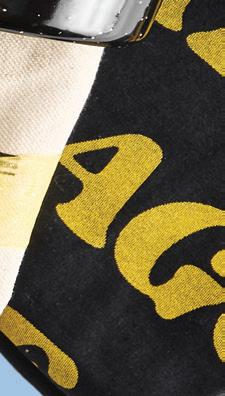








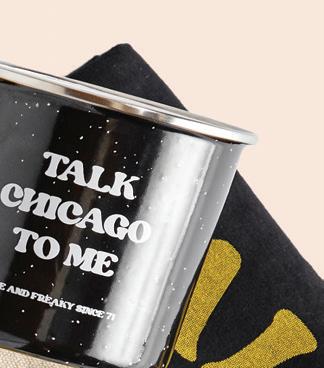
SAP BW/BO Analyst I (NSBAI22): SAP, SAP BW/BO, HANA, SD, SAP BI and FICO. Mail resume with job ID # to HR: 2300 Barrington Rd., Suite 400, Hoffman Estates, IL 60169. Unanticipated work site locations throughout U.S. Foreign equiv. accepted.
TransUnion, LLC seeks Advisors for Chicago, IL location to dev, automate & operate sw Infrastructure as a Service & Platform as a Service cloud app deployments using DevOps concepts. Master’s in STEM field +2yrs exp or Bachelor’s in STEM field +5yrs exp req’d. Req’d Skills: Hands on sw dev exp w/ Cloud & hybrid cloud tech (AWS EC2, Azure, S3, IAM, Lambda, SNS, Elastic Map Reduce cluster, Apache Hadoop, Spark); Python; bash scripting; APIs; microservices; serverless compute; server; network; storage; load balancing; clustering technologies; Puppet; CloudFormation; Terraform; CI/CD; Jenkins; AWS Code Deploy; Git; gitops environment; Ansible; boto3; dev AWS/ cloud automated scripts & tools; AWS Organizations; VPC; Account vending automation to provision AWS accounts in large scale environment. 40% telecommuting permitted. Send resume to: M. Carter, REF: SK, 555 W Adams St, Chicago, IL 60661.
ADULT SERVICES
Danielle’s Lip Service, Erotic Phone Chat. 24/7. Must be 21+. Credit/ Debit Cards Accepted. All Fetishes and Fantasies Are Welcomed. Personal, Private and Discrete. 773-935-4995
RESEARCH
Have you had an unwanted sexual experience since age 18? Did you tell someone in your life about it who is also willing to participate? Women ages 18+ who have someone else in their life they told about their experience also willing to participate will be paid to complete a confidential online research survey for the Women’s Dyadic Support Study. Contact Dr. Sarah Ullman of the University of Illinois at Chicago, Criminology, Law, & Justice Department at ForWomen@ uic.edu, 312-996-5508. Protocol #2021-0019.

PROFESSIONALS & SERVICES
CLEANING SERVICES
CHESTNUT ORGANIZING AND CLEANING SERVICES: especially for people who need an organizing service because of depression, elderly, physical or mental challenges or other causes for your home’s clutter, disorganization, dysfunction, etc. We can organize for the downsizing of your current possessions to more easily move into a smaller home. With your help, we can help to organize your move. We can organize and clean for the deceased in lieu of having the bereaved needing to do the preparation to sell or rent the deceased’s home. We are absolutely not judgmental; we’ve seen and done “worse” than your job assignment. With your help, can we please help you? Chestnut Cleaning Service: 312-332-5575. www. ChestnutCleaning.com
MUSIC LISTINGS

MJM DOM 52 SEEKS
SUB JEWISH FEMALE

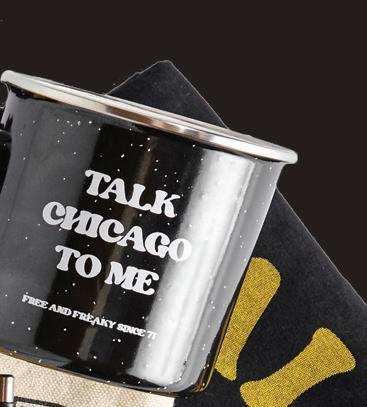
MJM DOM 52 seeks submissive mature jewish female who needs on going pleasure and punishment bondage bare bottom spanking hair pulling and will train and seeking discreet LTR I can host call/text-224-292-9899
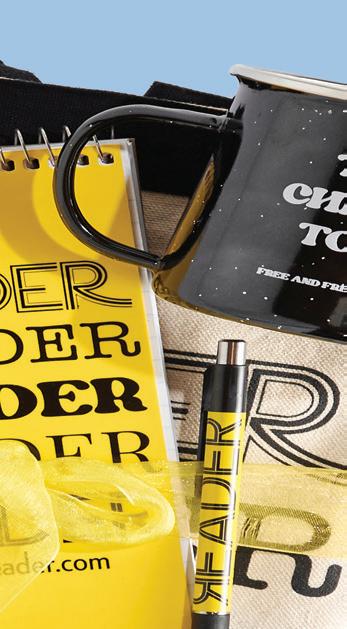
em: dragonmastercs69@ gmail.com

Submit your Reader Matches ad today at chicagoreader. com/matches for FREE. Matches ads are not guaranteed and will run in print and online on a space-available basis.


SEPTEMBER 15, 2022 - CHICAGO READER 77
REP THE READER! store.chicagoreader.com
A performing arts, visual arts, and other arts categories



































78 CHICAGO READER - SEPTEMBER 15, 2022 ll Outside Noise Reduction Keeps Bugs & Spiders Out Reduce or Eliminate Fog & Water Noise from Outside? Visit stormsnaps.com or noisewindows.com sales@stormsnaps.com Alpina Manufacturing, Chicago, IL 1-800-915-2828 Soundproofing Window Inserts the platform The Chicago Reader Guide to Business and Professional Services To advertise, e-mail ads@chicagoreader.com home improvement legal books Fun, Clean, Picture Frame assembly JOB $18/hour Tired or bored of clicking away on a keyboard working at home? Keep your hands and mind busy with a fun, safe, clean assembly job. You’d have your own large assembly zone, at least 15-20 feet away from others, so we’re really safe here. Top rated rm Alpina Manufacturing LLC founded in 1992 Beautiful campus in Galewood, near Mars candy, 3 blocks north of Oak Park. We build and sell display framing systems to customers nationwide including Wal-Mart, Verizon, Circle K gas stations, Hospitals. Full time, Part time, Flex hours for working parents or students. We train, no travel, work in Galewood. Open to any backgrounds. Excellent pay, friendly caring management. Stop in anytime between 7am and 4pm M-F ask for Izzy to apply and check us out. Alpina Manufacturing 6460 W Cortland St., Chicago, IL 60707 Brigi e Schmidt Bell, P.C. 847-733-0933 lawyers@bsbpc.com Brigi eBell.com Brigi eSchmidtBellPC Considering Divorce? We Can Help. Collaborative | Prenuptual Divorce | Mediation mental health YOUR AD HERE dance What Greta said . . . 5301N.ClarkSt.Fl.2 CHICAGODANCESUPPLY.COM 773-728-5344 773-616-6969 1234/1250 S. Michigan Ave. In/out. Must call 8 am-9 pm. No annoying texts. European Relax Massage Licensed & Certified Cupping health & wellness shop local Customized Massage Therapy, Intuitive Energy Work, and Holistic Talk Therapy 2514 W Armitage Ave, Suite 211 Chicago, IL 60647 773-697-9278 www.intuithealing.com Open Thursday-Monday BY APPOINTMENT ONLY A Matter of Consequences by Michael W. Falls Available on Amazon and Booklocker A Classic Chicago Mystery






































SEPTEMBER 15, 2022 - CHICAGO READER 79 the cannabis platform a Reader resource for the canna curious www.neuromedici.com 312-772-2313 Findouttoday ifmedical cannabisorinfusiontherapyis rightforyou.Telemedavailable! Yourpartnersinhealthandwellness. Serving medical cannabis patients since 2015. To advertise, email ads@chicagoreader.com CBD / cannabis recipes, psychedelic drawings to color, word puzzles to stimulate your brain, growing tips, and more! chicagoreader.com/420book The Budrista platform is a cannabis industry and lifestyle project. Its purpose is to support the healthy and balanced lifestyle of cannabis industry workers. Budrista functions through various outlets such as educational programming and recreational events. By signing up, you’ll have first access to our events and programming! CALL 1-855-927-2570 promo code N7017 TM * Prices are per person based on double occupancy plus up to $299 in taxes & fees. Single supplement and seasonal surcharges may apply. Add-on airfare available. Free date changes 100 days before departure for all land tours and cruise tours. Deposits and final payments are non-refundable. Onboard Credit requires purchase of Ocean View or Balcony Cabin. O ers apply to new bookings only, made by 9/30/22. Other terms & conditions may apply. Ask your Travel Consultant for details. BEST OF HAWAII FOUR-ISLAND TOUR GRAND ALASKAN CRUISE & TOUR Oahu • Hawaii Island • Kauai • Maui — Enjoy a fully guided 4-island Hawaiian vacation with centrally located lodging in Waikiki on Oahu, and beachfront lodging on the “Big Island” of Hawaii, Kauai, and Maui. Guided throughout by our friendly Tour Directors—your local experts. Includes 3 inter-island flights. Vancouver • Ketchikan • Juneau • Skagway • Glacier Bay • Denali Anchorage • and more — Visit Denali National Park and Glacier Bay National Park on the same incredible trip! Cruise through the Gulf of Alaska and the Inside Passage as you discover the best of the Frontier State by land and by sea. 12 days, departs year-round 12 days, departs May - Sep 2023 FROM $2,549 * $2,299 * FROM $2,049 * $1,799 * FREE ONBOARD CREDIT PLAN YOUR DREAM VACATION
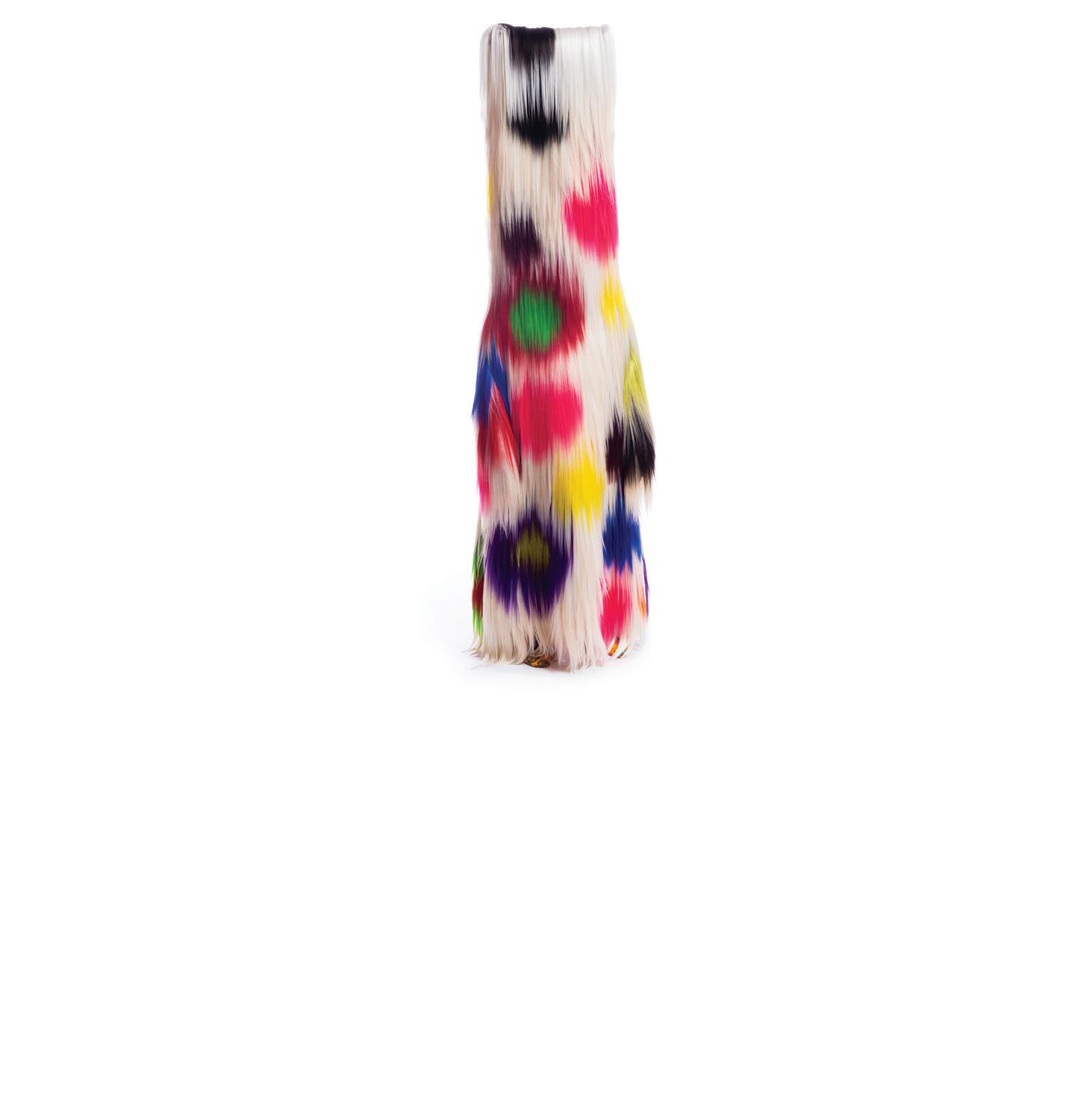



































 By ISA GIALLORENZO
By ISA GIALLORENZO






















































































 By MIKE SULA
By MIKE SULA



























































































 By KAYLEN RALPH
By KAYLEN RALPH




































































































































































































































 By EMILY MCCLANATHAN
By EMILY MCCLANATHAN




















 By DMITRY SAMAROV
By DMITRY SAMAROV

















































































































































































 By KATHLEEN SACHS
By KATHLEEN SACHS




































 By LEOR GALIL
By LEOR GALIL





























































 —LEOR GALIL
—LEOR GALIL


 GALIL v
GALIL v


















































































